ALSO Eat, Drink, Explore & Enjoy Cincinnati May Festival Celebrates 150 Years American Choral Directors Association WELCOME INSIDE Beginnings of the Cincinnati May Festival
THE CITY THAT SINGS

is a vibrant community of choirs from across the Tri tate area of Ohio, Kentucky, and Indiana of all singers in the Cincinnati region.
Choirs from YOUR schools, universities, community organizations, and houses of worship are invited to join , and together, we ensure that Cincinnati remains “The City hat Sings.”
Whether you’re looking for a choir to join, a performance to attend, or a grand convention of singers, THE CITY THAT SINGS has the information you need!
Learn more online at bit.ly/citythatsings.

 May Festival announcing its 150th anniversary season.
Credit: JP Leong
May Festival Chorus, May Festival Youth Chorus and Cincinnati Symphony Orchestra led by May Festival Principal Conductor Juanjo Mena perform Jessie Montgomery’s I Have Something to Say, May 2022.
Credit: JP Leong
May Festival announcing its 150th anniversary season.
Credit: JP Leong
May Festival Chorus, May Festival Youth Chorus and Cincinnati Symphony Orchestra led by May Festival Principal Conductor Juanjo Mena perform Jessie Montgomery’s I Have Something to Say, May 2022.
Credit: JP Leong
FESTIVAL 150
CINCINNATI MAY FESTIVAL
Music Hall
Geraldine V. Chavez Center for the Choral Arts 1241 Elm Street
Cincinnati, OH 45202
Administrative Offices: 513.621.1919
contact@mayfestival.com
Box Office Music Hall 1241 Elm Street Cincinnati, OH 45202 513.381.3300
sales@cincinnatisymphony.org
Group Sales 513.744.3590
groupsales@cincinnatisymphony.org
TTY/TDD
Use TTY/TDD Relay Service 7-1-1 mayfestival.com
CONNECT WITH US
MAY FESTIVAL PROGRAM BOOK STAFF:
Managing Editor Tyler Secor
Senior Editor/Layout
Teri McKibben
Graphic Design
David Mill & Regina Kuhns
CINCINNATI MAGAZINE: Advertising and Publishing Partners for May Festival Program Book
Publisher Ivy Bayer
Production Director & IT Systems Administrator
Vu Luong
Advertising & Marketing Designer
Logan Case Account Representatives
Laura Bowling, Maggie Wint Goecke, Hilary Linnenberg, Chris Ohmer, Julie Poyer
Operations Director
Missy Beiting
Business Coordinator
Erica Birkle
Advertising and Business Offices
1818 Race Street, Suite 301
Cincinnati, OH 45202 | 513.421.4300
Subscriptions: 1.800.846.4333
cincinnatimagazine.com
CONTENTS 3 Greetings from the Board Chair and Executive Director 6 Feature Story: The May Festival Celebrates its 150th Anniversary 9 Spotlight on 25 for 25: A New Time for Choral Music 12 May Festival Spotlight: The Beginning 14 Beginnings of the Cincinnati May Festival and Music Hall 17 Cincinnati's Modern Musical Landscape 18 The Music Hall ARTISTS: 22 Juanjo Mena, Principal Conductor 23 May Festival Chorus 24 Chorus Leadership: Robert Porco, Director of Choruses; Matthew Swanson, Associate Director of Choruses 26 May Festival Youth Chorus, Matthew Swanson, Director 27 Guest Chorus 28 Guest Soloists 32 Cincinnati Symphony Orchestra CONCERT: 34 ACDA NATIONAL CONFERENCE: Feb. 23 & 25 EAT, DRINK, EXPLORE, AND ENJOY CINCINNATI!: 46 Thea Tjepkema is Music Hall's Guardian Angel 52 Cincinnati's Iconic Food Dishes 56 Welcome to Bourbon Country 58 Where to Eat Nearby DEPARTMENTS: 64 Administration
contents © 2023. The contents cannot be
in part, without
2 | CINCINNATI MAY FESTIVAL
All
reproduced in any manner, whole or
written permission from the May Festival.
Dear Friends,


On behalf of the May Festival, May Festival Chorus and the Cincinnati Symphony Orchestra, welcome to Cincinnati! We are very excited that the American Choral Directors Association is here in Cincinnati for its first in-person national conference since 2019.
The City of Cincinnati has a rich history of singing, dating as far back as the year 1800 when the city was just a small village of 750 people. In fact, the newspaper at the time, The Western Spy, even advertised the first singing school:
Those gentlemen and ladies who feel themselves disposed to organize a singing school will please to convene at the courthouse to-morrow evening at candle light, as it is proposed to have singing.
The seeds were planted and, as the city grew in population, the creation of English and German singing societies quickly followed. The number of societies grew so large that there was a need for singing festivals. June 1–4, 1849 was the first such festival, drawing together singing societies from Cincinnati, Louisville, and Madison, Indiana to form the Nord-Amerikanischer Saengerbund.
Less than three decades later in 1873, the first Cincinnati May Festival was held, bringing together the English and German singing traditions found in early Cincinnati. The May Festival continues today as the longest-running choral festival in the Western Hemisphere. Craig Doolin’s article, “Beginnings of the Cincinnati May Festival and Music Hall” on page 14, tells us more about the early history of the May Festival.
Flashing forward to more recent times, in 2012 Cincinnati drew international attention when it became the first U.S. city to host the World Choir Games. To honor this event and the storied history of singing in the Queen City, Cincinnati became known as “The City That Sings.” With hundreds of choirs and tens of thousands of singers, the City of Cincinnati certainly lives up to that moniker. Cincinnatianslove to sing!
This magazine is full of stories about the May Festival and the City of Cincinnati.
In Ken Smith’s article (p. 6), he highlights the upcoming May Festival, which will bring back treasures from previous Festivals and introduce new works to celebrate this momentous year. In Wajeeh Khan’s article (p. 9), he describes the 25 for 25 choral music commissioning collaboration between the May Festival and Luna Composition Lab, developed to celebrate our 150th milestone and our legacy of commissioning new music. And Cincinnati Magazine divulges the best restaurants and bars to visit during your stay in Cincinnati.
Program information about the May Festival Chorus’ headlining concert, including program notes and artist bios, can also be found within the pages of this magazine.
Once again, welcome to The City That Sings, enjoy all that we have to offer here in Cincinnati, and thank you for adding your voice to our 150th anniversary season.
Director
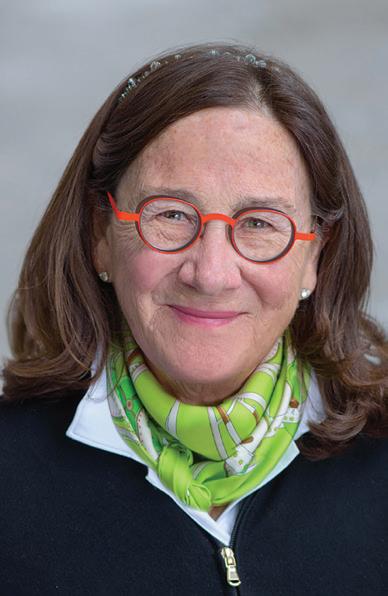
 GREETINGS FROM THE BOARD CHAIR AND EXECUTIVE DIRECTOR
Christy Horan and Steven Sunderman
GREETINGS FROM THE BOARD CHAIR AND EXECUTIVE DIRECTOR
Christy Horan and Steven Sunderman
CINCINNATI MAY FESTIVAL | 3
Christy Horan, Chair, Board of Directors Steven Sunderman, Executive

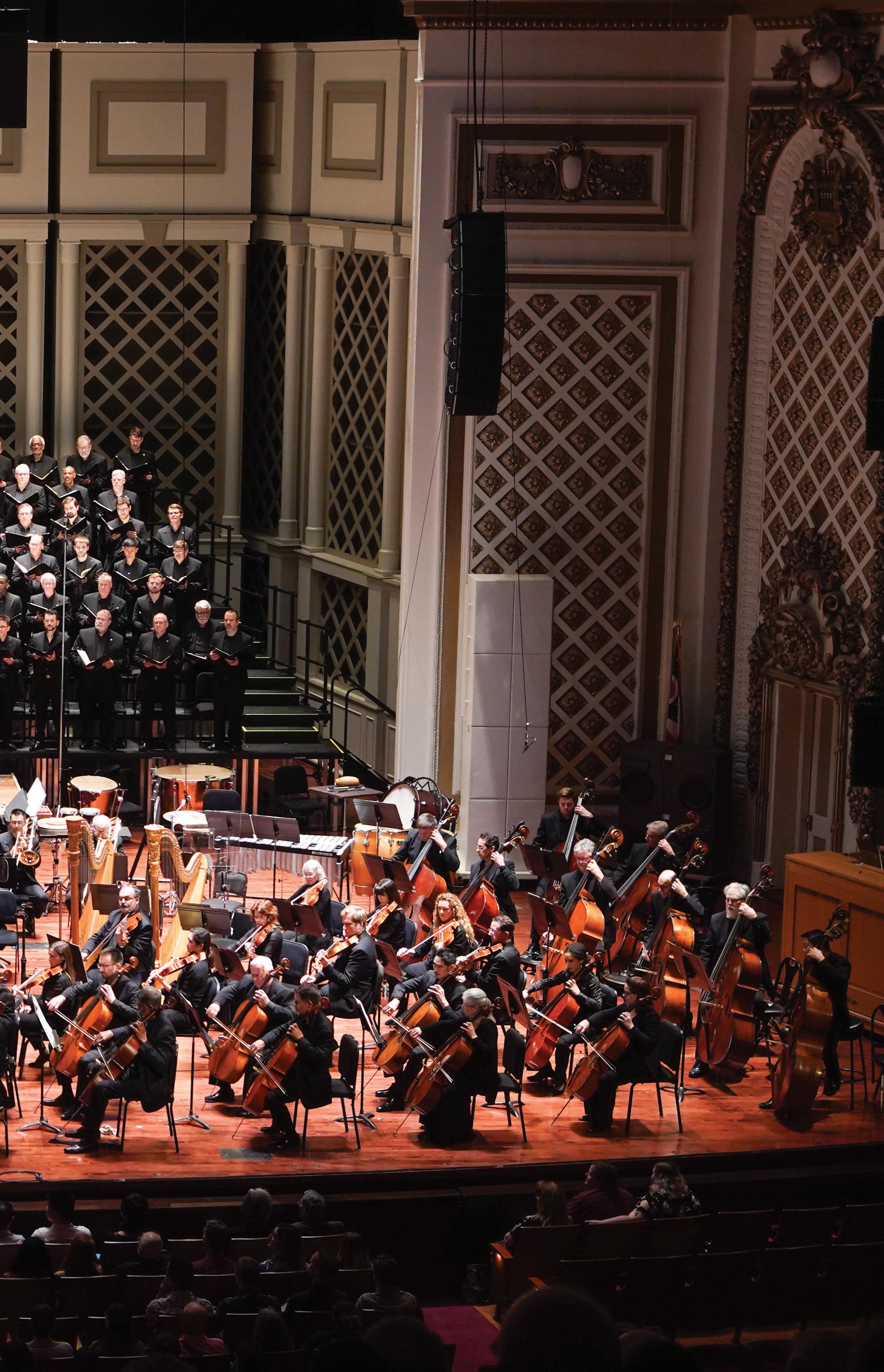 Credit: Mark Lyons
Credit: Mark Lyons
THE MAY FESTIVAL CELEBRATES ITS 150th ANNIVERSARY
 by Ken Smith
by Ken Smith
When he was first invited to become Principal Conductor of the Cincinnati May Festival, Juanjo Mena began studying its past programming extensively. “I asked to see a full list of the Festival’s repertory—not just the past 10 or 15 years they initially sent, but everything the Festival has done since 1873,” he recalls. “Did you know the May Festival did the U.S. premiere of Bach’s Magnificat? Or Handel’s Dettingen Te Deum?”
If we didn’t remember before, we certainly do now. As the May Festival looks ahead to its 150th anniversary this season, highlights of the Chorus’ stellar history are resounding again in the city—not just in Music Hall, and not only in May. Mena opens the Festival on May 19, 2023 with the Magnificat capping a program featuring the world premieres of James MacMillan’s Timotheus, Bacchus and Cecilia and James Lee III’s Breaths of Universal Longings, both May Festival commissions. Robert Porco, the Festival’s Director
of Choruses, will lead the Dettingen Te Deum on April 1 at Hyde Park Community United Methodist Church, in a program including the world premiere of a new work commissioned from Olivia Bennett (read more about the 25 for 25 Project on p. 9) and performed by the May Festival Youth Chorus. That mix of choral standards with music still hot
 The May Festival kicked off its 150th anniversary season by performing Mahler’s Symphony No. 2, Resurrection, with the Cincinnati Symphony Orchestra led by CSO Music Director Louis Langrée in September 2022. Credit: Roger Mastroianni
The start of the May Festival sounded early this season with the traditional herald trumpets decked in their new May Festival banners. Credit: Charlie Balcom
The May Festival kicked off its 150th anniversary season by performing Mahler’s Symphony No. 2, Resurrection, with the Cincinnati Symphony Orchestra led by CSO Music Director Louis Langrée in September 2022. Credit: Roger Mastroianni
The start of the May Festival sounded early this season with the traditional herald trumpets decked in their new May Festival banners. Credit: Charlie Balcom
MAY FESTIVAL FEATURE 6 | CINCINNATI MAY FESTIVAL
off the proverbial press has long been a source of the Festival’s allure, Mena asserts.
“This is not just performing music, it’s helping to create the music, with the composers playing an active part,” he says. On May 20, Marin Alsop makes her May Festival debut conducting Robert Nathaniel Dett’s oratorio The Ordering of Moses, which the May Festival Chorus premiered in 1937 and brought to Carnegie Hall in 2014. The Festival’s Music Director Laureate James Conlon opens the second week on May 25, pairing Mozart’s Requiem with the world premiere of a new commission by Julia Adolphe. On May 27, the Festival draws to a dramatic close with Mena leading Mahler’s mighty Eighth Symphony—the so-called Symphony of a Thousand—with the May Festival Chorus and Youth Chorus joined by the Cincinnati Boychoir, Cincinnati Youth Choir, and the entire Cleveland Orchestra Chorus.

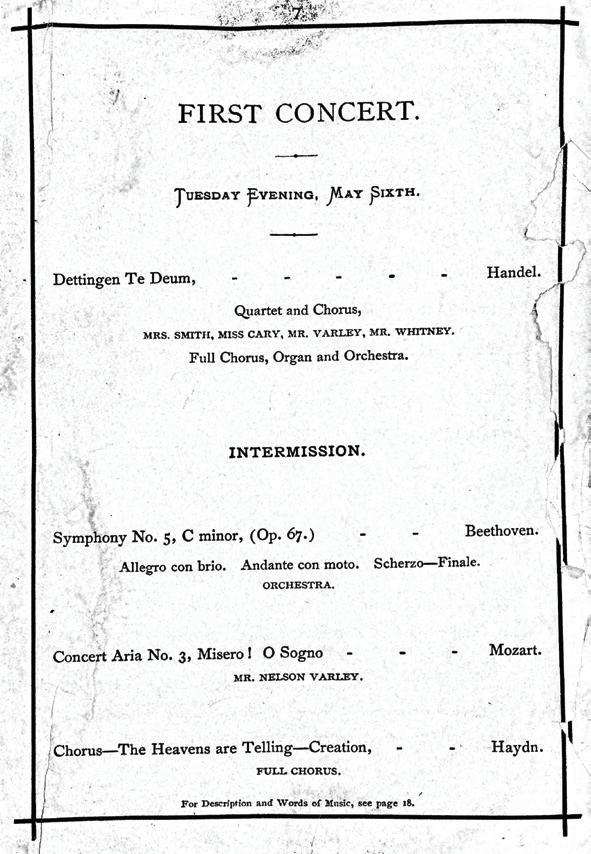
This season’s celebration is all the more poignant, given that just a few years ago choral singing had topped music’s “high risk” activities. After the 2020 May Festival was canceled entirely due to Covid-19, Mena pushed to reopen in 2021, even in a reduced format. “This is not a time for us to stop making music,” insisted Mena, who led a programming switch to smaller ensembles and orchestral works with soloists. “It’s a time to send a message to audiences that we need to continue.”
“I suppose you could say we already made our public statement by opening the 2022–23 season with Mahler’s Resurrection Symphony,” adds Porco. “But really, when we opened the 2022 May Festival with John Adams conducting his El Niño and closed with the Beethoven Ninth, that’s when we said, ‘We’re back!’”

For nearly two seasons, Porco kept the Chorus together largely as a social unit through emails and Zoom gatherings. “A few members elected not to return, but we also had an influx of new people,” he says. The 2022 Festival was nearly back to its pre-pandemic state, with big choral works and a full rehearsal schedule, except that mask-wearing continued. “It was no fun singing a three-hour rehearsal in a mask,” Porco says, “but we were, and continue to be, highly conscious of people’s health.”
For Mena, who ends his six-year tenure as Principal Conductor this season, his first U.S. posting in Cincinnati was partly a return to his musical roots. Having grown up in Spain’s Basque region, he began singing in choirs at age 7 and was first invited to conduct a choir at 16. Two years later, he formed his first ensemble, a 100member girls’ choir.
His transition to the orchestral world followed a similar path. After studying conducting in Vitoria-Gasteiz and Madrid, Mena was invited by

MAY FESTIVAL FEATURE
Principal Conductor Juanjo Mena conducted Beethoven’s Symphony No. 9 to end May Festival 2022. Credit: JP Leong
Director of Choruses Robert Porco leads the May Festival Chamber Choir in performance at the Cathedral Basilica of the Assumption, April 2022. Credit: JP Leong
Programs from the first May Festival show the Festival’s premieres of Handel’s Dettingen Te Deum and Bach’s Magnificat
CINCINNATI MAY FESTIVAL | 7
the Basque government to create the region’s first youth orchestra. Two years later, he was tapped to become Music Director of the Bilbao Symphony Orchestra, launching his professional career. By the time he was appointed the May Festival’s Principal Conductor in 2016, he was six years into his contract as Chief Conductor of the BBC Philharmonic.
“I’d been aware of the May Festival tradition,” he says. “I knew the importance not only of preserving its values but adding to them as
well.” Some Basque populism he brought to Cincinnati included presenting free community choral concerts in Music Hall and creating a special May Festival Community Chorus of more than 300 singers (many of them singing in a chorus for the first time) for a special presentation of Handel’s Messiah. He also invited Basque vocal ensembles to perform in Cincinnati.


“In my youth, singing was done for the people,” Mena says. “This is also important in Cincinnati, because the community is the core of the Festival. It’s always important to discover different ways of singing, and these were some ideas I brought to the May Festival to bring people together and look to the future.”
He pauses for a moment. “You know, I was already in shock seeing all the pieces that the May Festival had performed, when I discovered the name Jesús Guridi,” he exclaims. “He was a composer from my city in Spain! In Cincinnati, people were performing the same music here that I was singing in my choir at home. How is this possible? And then I thought, why not?”
MAY FESTIVAL FEATURE
The May Festival Chorus, the cast of Peer Gynt, the Cincinnati Symphony Orchestra, CSO Music Director Louis Langrée, Director of Choruses Robert Porco, and Concert Theatre Works director Bill Barclay take a bow after the January 2023 concert. Credit: JP Leong
8 | CINCINNATI MAY FESTIVAL
Cincinnati Symphony Orchestra Music Director Louis Langrée conducts the May Festival Chorus in Grieg’s Peer Gynt, January 2023. Credit: JP Leong
by Wajeeh Khan
2023 marks the 150 th anniversary of the May Festival, which has an extensive legacy of commissions and premieres (for more on the May Festival’s history see p. 14). To honor this history, the May Festival embarked on a new endeavor: 25 for 25: A New Time for Choral Music, a choral commissioning project in collaboration with Luna Composition Lab, whose composers will be writing 25 new choral works for 25 choral ensembles throughout Greater Cincinnati.
Founded in 2016 by composers Missy Mazzoli and Ellen Reid, Luna Composition Lab provides mentorship and a plethora of educational and professional resources for female, nonbinary and gender non-conforming composers ages 13–18. Mazzoli says:
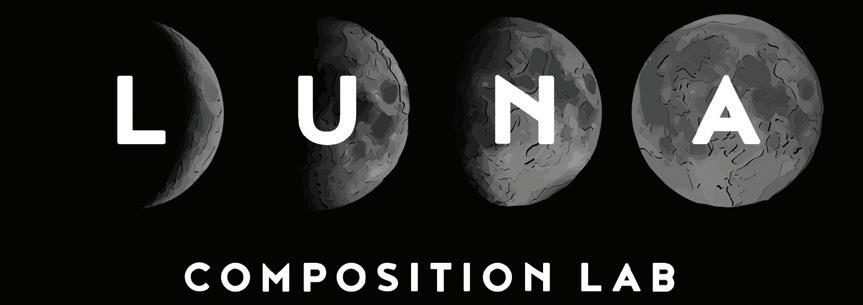


Ellen and I came together in early 2016. As women who have been in the field for a very long time, we’ve noticed very specific barriers to gender equality in the field [of music composition]. We’ve both been in the position of being the first woman whose music was performed by several orchestral and opera organizations. The field has a long way to go in including non-male compositional voices. A lack of role models and representation at the highest levels in academia and in concert halls throughout the world is one of the barriers to gender equality.
Luna Composition Lab was founded to address some of these barriers. The only initiative of its kind in the U.S., Luna Lab’s goal is to celebrate underrepresented voices and shape the future of music through a support system focused on continuing success. Luna Composition Lab provides for its fellows eight months of mentorship with acclaimed female and non-binary composers, opportunities to have original work workshopped, premiered and professionally recorded, and a culminating weeklong festival in New York City filled with masterclasses from world-renowned composers. Fellows also gain access to a strong and supportive network of professional performers, composers and other aspiring musicians.
From top: Luna Composition Lab founders Missy Mazzoli (Credit: Caroline Tompkins) and Ellen Reid
(Credit: James Matthew Daniel)
CINCINNATI MAY FESTIVAL | 9
The May Festival’s 25 for 25 Project aligns perfectly with the educational and professional goals of Luna Composition Lab. “We were thrilled to hear about the May Festival’s interest in us and were honored that they commissioned new choral works from 25 of our alumni composers,” said Executive Director Alyssa Kayser-Hirsh. “It was a no-brainer for us. It’s the largest commissioning initiative that Luna Lab has ever done,” said Reid. Mazzoli echoed this sentiment, stating, “A single commission like this can elevate a composer’s career. For most of our composers, this is their first professional commission. To say that their first commission is from the May Festival will be so huge for them.”
The new works written by composers of Luna Composition Lab will be premiered by Greater Cincinnati choral ensembles in a community showcase March 19, 2023, and at several other


local performances throughout the spring. The collaborative magnitude and the uniqueness of this event is particularly noteworthy: 25 composers and 25 choral ensembles, which range from afterschool choirs of elementary students to university choirs and community choruses, performing 25 new works. The May Festival funded the compositions in their entirety and, for each Luna Lab fellow, the Festival is also funding composition lessons with mentor composers, travel to Cincinnati to allow composers and ensembles to engage with one another, and professional recordings. Participating ensembles and artists are also receiving a stipend to support their performances.
Perhaps the most valuable aspect of this commissioning project has been the mentorship, guidance and encouragement that Luna Composition Lab fellows have received from professional composers. As Ellen Reid stated, “Every composition, no matter what level it’s at, is always a learning experience. This will be a great professional learning experience for our fellows that will set them on a track to have long, meaningful and fruitful careers.”
One of the mentors who has been fostering these learning experiences is Julia Adolphe, a criticallyacclaimed composer known for works such as her comic opera A Barrel of Laughs, a Vale of Tears and for her three pieces commissioned and premiered in Cincinnati: Sea Dream Elegies for Chorus, Oboe and Cello in May 2016 and Equinox (heard at the 2023 ACDA conference performances) in November 2017, both by the May Festival Chorus, and Paper Leaves on Fields of Clay in May 2022 by the Cincinnati Symphony Orchestra.
Adolphe, who has faced barriers and inequities as both a student and as a professional, relished the opportunity to connect with students who are at such a critical point in their young careers. “The whole process is very remarkable. The fact that the May Festival is giving these students the opportunity to have a professional commission at such a young age, along with providing them with a support network, is a huge deal,” said Adolphe. “If it’s your first time writing for an ensemble, there can be a fear of crashing and burning. So, it’s really wonderful to have that support network and to have a chance to get feedback from professionals and be set up for success.”
One of the biggest aspects that attracted Adolphe to this commissioning initiative was the ability to provide students with opportunities and connections that she did not have.
“Reflecting back on my late teens and early 20s, one thing that stuck out to me was that I didn’t have any female or non-binary composer role models. There were a couple of these composers who I

SPOTLIGHT: 25 FOR 25
10 | CINCINNATI MAY FESTIVAL
Above, from top: May Festival Youth Chorus led by Matthew Swanson, April 2022 (Credit: JP Leong); Northern Kentucky Community Chorus (Credit: AJ Waltz); and Classical Roots Community Choir, March 2019 (Credit: Mark Lyons).
admired, but I did not have access to them. They were never a part of the faculty at the schools I went to. This project gives others an opportunity that I never had. In a way, as a mentor, I get to remember what it was like to be at the very beginning of my own career, with my eyes toward being a professional. I keep trying to remind my students that they’re very ahead of the game!”
Commissions and premieres have always been a feature of the May Festival, and they will remain so as the Festival continues to grow and innovate. “The May Festival was formed to unite locals in sharing their unique talents in choral music with the greater community,” said Steven Sunderman, Executive Director of the May Festival. “The May Festival is incredibly proud to celebrate its first 150 years in this outstanding community. We look forward to these diverse, exciting and inventive new works, written by exemplary composers and performed by our local choral and vocal artists. Through these amazing performances that connect and inspire all of us, Cincinnati will continue to remain The City That Sings.”
For more information on the 25 for 25: A New Time for Choral Music project, please visit mayfestival.com/25
25 for 25 Composers
Violet Barnum
KiMani Bridges
Olivia Bennett
Gabriella Cariddo
Madeline Cheng
Tiffany Cuaresma
Michelle David
Alicia Erlandson
Jack Gjaja
Abby Harris
Elisa Johnson
Anya Lagman
Devon Lee
Yuri Lee
Maya Miro Johnson
Joanna McDonald
Jordan Millar
Rachel Mugemancuro
Ebun Oguntola
Cecilia Olszewski
Caleb Palka
Zola Saadi-Klein
Sage Shurman
Azalea Twining
Chloe Villamayor
• Cincinnati Boychoir
• Cincinnati Camerata
• Cincinnati Choral Academy
• Cincinnati Men’s Chorus
• Cincinnati Youth Choir
• CinKoa: Cincinnati
Korean Choir
• Classical Roots Community Chorus
• Hear Us, Hear Them
• Heri et Hodie
• Jeremy Winston Chorale
•
• Little Miami Chorale
• May Festival
Youth Chorus
•
MUSE: Cincinnati
Women’s Choir
• No Promises Vocal Band
• Northern Kentucky Community Chorus
•
Northern Kentucky University
Chamber Choir
• School for the Creative and Performing Arts Chorale
• St Ursula Academy Vocal Ensemble
•
Learn more at mayfestival.com/25
• Thomas More University Choir
• Tron
• University of Cincinnati College-Conservatory of Music Chorale
• Ursuline Academy Choir
• Voices of Indiana
• World House Choir
• Xavier University Choir
• Young Professionals Choral Collective
•
SPOTLIGHT: 25 FOR 25
you to 25 for
Project participating ensembles and artists!
Thank
25
A NEW TIME CHORAL MUSIC for CINCINNATI MAY FESTIVAL | 11
May Festival: The Beginning
 Credit: Eric Johnson
Credit: Eric Johnson

BEGINNINGS OF THE CINCINNATI MAY FESTIVAL
AND MUSIC HALL
by Craig Doolin, co-author of A City That Sings: Choral Music in Cincinnati
Cincinnati’s famous May Festival, first held in 1873, is a unique mixture of choral traditions. While the artistic forces were almost entirely German, the administrative team that planned the event was mostly of English descent. Cincinnati’s successful 1870 Saengerfest, with its 1,800 singers, was certainly a hometown model for the May Festival, but the tone of the event came from the spectacularly large, but well-mannered, display of the massed-choir traditions of English festivals in Leeds and elsewhere. The festive social component of the German festivals, complete with food and drink, hasn’t been a regular part of the May Festival. At the time of this writing, the Festival is 150 years old and has been a continuous event since its inception in 1873. Until 1967, the May Festival was held every two years with only a few exceptions, but since then it has been given every year.
Over the years, many people have led the May Festival, including Theodore Thomas, Eugène Ysaÿe, Eugene Goossens, Josef Krips, Max Rudolf, James Conlon and, presently, Juanjo Mena.
Cincinnati history holds that Maria (pronounced with a long “i”) Longworth Nichols, the 23-year-old granddaughter of the wealthy Nicholas Longworth, invited the famous conductor, Theodore Thomas, to her home on Grandin Road to ask him to create and conduct what is today the oldest continuous choral music festival in the Western Hemisphere. Also present at this historic meeting were Maria's husband, Colonel George Ward Nichols, who had been an aide-de-camp to Civil War Generals Fremont and Sherman; Heinrich Rattermann, a leading figure in the Saengerfests of the past decade; and Henry Krehbiel, music critic of the Cincinnati Gazette
Maria’s eagerness to have a festival in Cincinnati came from an 1871 trip to England, where she witnessed one of the large English festivals. Thomas, during their meeting in 1872, agreed to
be conductor of the festival if $50,000 could be raised for a guarantee fund and a committee could be formed to take care of the business aspects of the event.
The Cincinnati Musical Festival Association’s Executive Committee included, among others, George Ward Nichols as President, with dry goods merchant John Shillito as treasurer, Cincinnati music publisher John Church as Chairman of the Printing Committee, and attorney Bellamy Storer, Jr., as Secretary. Over the following eight months, these men made all the business decisions leading to the May Festival of 1873.
They decided to hire Theodore Thomas as musical director and Carl Barus as director of the chorus. Thomas’s touring orchestra would play, as they would continue to do at every Festival until 1904. Arthur Mees, a Cincinnati music teacher, was named rehearsal accompanist and, later, Festival organist. Choristers were assembled from throughout the West (today’s Midwest) by distributing a circular to 121 music dealers, 60 post offices, and 144 singing societies. The circular was also distributed to 1,120 newspapers throughout Ohio, Indiana, Kentucky, and “the leading papers of the West.” Rehearsals were set to begin in January of 1872.

Sometime in November, the Executive Committee engaged soloists. The soloists for the 1873 May Festival were Mrs. H.M. Smith of Boston, soprano; Emma Dexter of Cincinnati, soprano; Annie Louise Cary, contralto; Nelson Varley, tenor; J.P. Rudolphsen, bass; and Myron W. Whitney, bass. Although Thomas had no advance notice of the soloists’ hiring, he was nonetheless satisfied. He did express concern about Annie Louise Cary, the contralto soloist hired to sing excerpts from Gluck’s Orfeo ed Euridice:
I must be sure that a good contralto is engaged who can sing the two arias and the recitatives connecting the choruses. She must have a good
MAY FESTIVAL SPOTLIGHT
14 | CINCINNATI MAY FESTIVAL
Theodore Thomas Courtesy of the Friends of Music Hall
voice and not be spoiled by singing Trovatore and Lucrezia, and one who will not try to cover up her bad singing by shaking her body and smiling at young America.
However, Thomas relented and later praised her as “perhaps the finest alto voice in the country.”
In the meantime, the Festival chorus was taking shape, and rehearsals were strict. Choristers who were absent from rehearsals had their names published in the local newspapers. By the time the first performance took place, the chorus had 706 members.
The performances of the 1873 May Festival, held in Saengerfest Halle (built for the 1870 Saengerfest and located on the site where the current Music Hall was built in 1878), established it as the principal musical event of Cincinnati’s concert season, an honor that it retains to the present day. The repertoire was overwhelmingly German. Of the 60 works on the seven concerts, only five were by composers not born in a German-speaking country. The matinee concerts consisted largely of arias, art songs and light orchestral works, including isolated movements of symphonies, Strauss waltzes, and overtures. Thomas’s evening concerts were more formal and consisted of major vocal and choral works, including Handel’s Dettingen Te Deum, scenes from Gluck’s Orfeo ed Euridice, and Beethoven’s
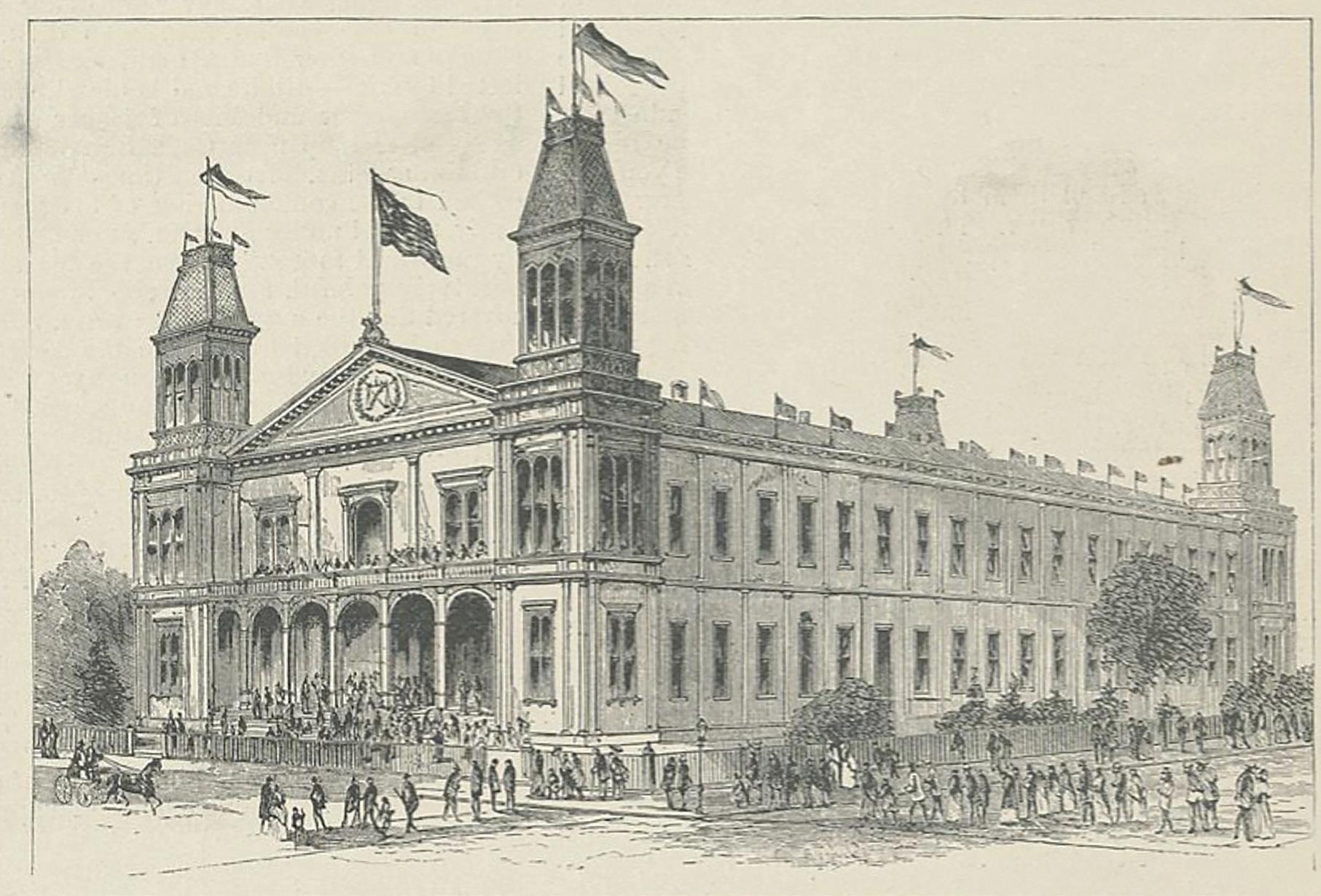
Ninth Symphony. In the five days from May 6 to 10, 1873, Cincinnati’s reputation as a city of Saengerfests grew to include world-class performances of canonic works for orchestra and chorus.
After the death of Theodore Thomas in 1905, the 1906 May Festival featured British composer Sir Edward Elgar conducting the American premiere of his oratorio The Dream of Gerontius at the final concert. He conducted the second, fifth and sixth concerts of the Festival, and spent the preceding two weeks rehearsing his music with the performers.
Leonard Bernstein was Honorary Music Director for the 1973 centennial celebration of the May Festival, at which he conducted Beethoven’s Missa Solemnis.
The May Festival has presented many world and U.S. premieres in its 150-year history. Among the Festival’s U.S. premieres are Handel’s Dettingen Te Deum (the very first work performed at the very first Festival), Mahler’s Symphony No. 3, Britten’s “Choral Dances” from his opera Gloriana, and Menotti’s The Death of the Bishop of Brindisi. Continued commissions and artistic innovations ensure that the May Festival remains as relevant today as it was in 1873. The tradition lives and expands.
SPOTLIGHT: BEGINNINGS
Saengerfest Hall, c. 1870, from Harper’s Weekly Courtesy of the Friends of Music Hall
CINCINNATI MAY FESTIVAL | 15
MUSIC HALL
Cincinnati Music Hall is a direct result of the 1875 May Festival. Cincinnati’s usual springtime thunderstorms pelted the leaky tin roof of Saengerfest Hall with rain and hail. The cavernous hall acted as a resonating chamber, and Thomas had to stop the concerts on more than one occasion to let the storms pass. It was also hot and crowded. Windows were broken to reduce the temperature, but the
6,000 attendees, a third of them outside the hall, could not be moved.
Kentucky-born grocer Reuben Springer was so annoyed by the situation that he made the initial $125,000 donation to create a matching fund to enable the construction of Music Hall, completed in 1878. The Third May Festival, originally scheduled for 1877 but postponed until the new hall could be finished, cemented the Festival as a recurring event deserving of notice on a national level.

Music Hall was designed by Hannaford and Procter and is 150-feet tall at its central gable. Of its 372 feet of frontage, 178 feet would be devoted to the main hall, while nearly 90 feet would be occupied by each of the two exposition buildings, constructed in 1879. Music Hall would be 293 feet deep from Elm Street to the Miami and Erie Canal that flowed behind the hall.

Cincinnati’s Music Hall was officially dedicated at the first concert of the 1878 May Festival on May 14.
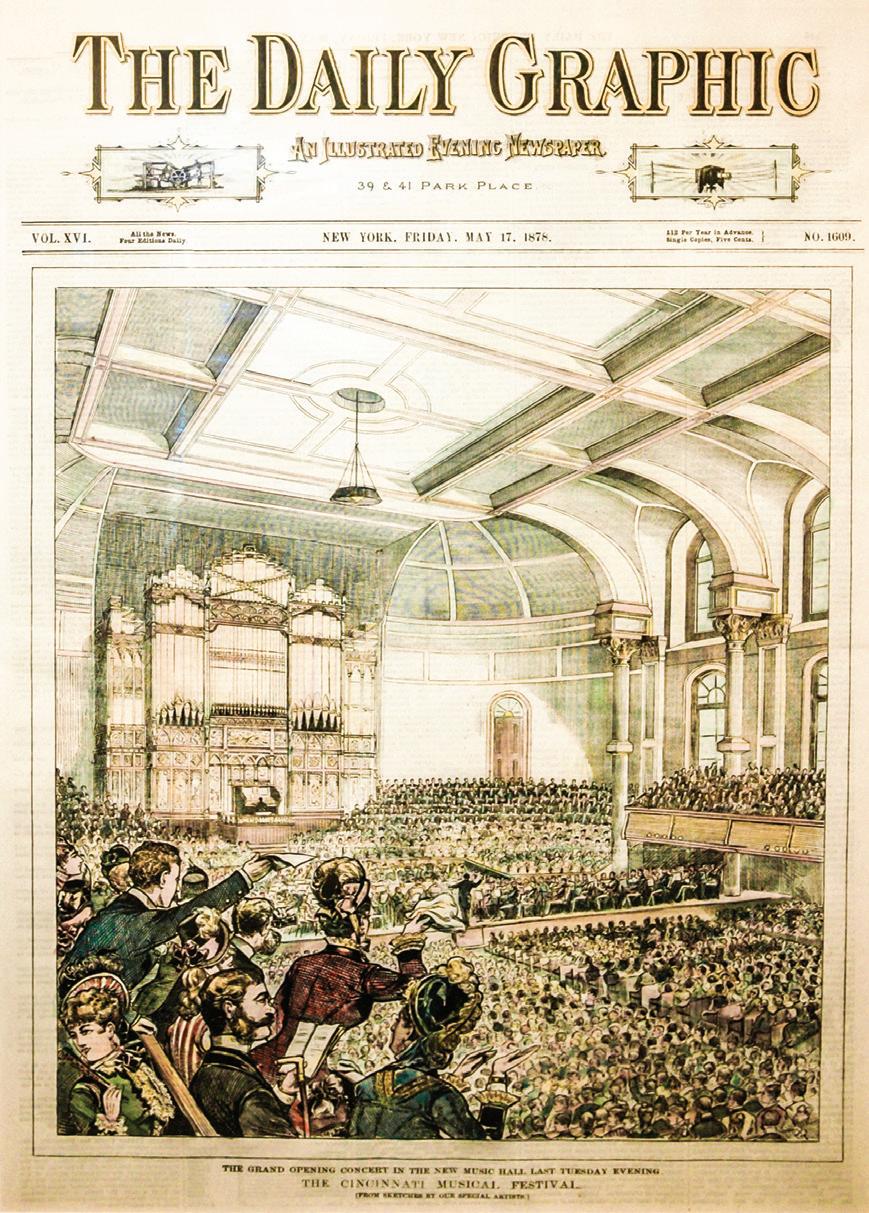
SPOTLIGHT: BEGINNINGS
Reuben Springer Courtesy of the Friends of Music Hall
16 | CINCINNATI MAY FESTIVAL
Left: The cover of the 1878 Daily Graphic, featuring the interior of the newly opened Music Hall for the Grand Opening Concert of “The Cincinnati Musical Festival.” Below: Music Hall, 1878. Courtesy of the Friends of Music Hall
MAY FESTIVAL SPOTLIGHT CINCINNATI'S MODERN MUSICAL LANDSCAPE
by Tyler M. Secor
The formation of the May Festival in 1873 catalyzed what is today’s culture of arts and music in Cincinnati and put the City of Cincinnati on the map as a hub for music and art. After the first May Festival, the Chicago Tribune wrote, “the result of that festival to-day is, that Cincinnati is the first musical city of the West.” Other arts and music organizations quickly followed.
As noted in Craig Doolin’s article, “Beginnings of the Cincinnati May Festival and Music Hall” (p. 14), the 1875 Festival led to the construction of the Festival’s home, Cincinnati’s iconic Music Hall, in 1878. Reuben R. Springer, a successful business man and the person who made the initial donation to build Music Hall, wrote, “The Musical Hall building to be located in the center of the lot, and so planned and constructed as to be capable of being used for Exposition purposes in connection with suitable buildings that may be constructed on the North and South to the limits of the lot.” By the 1878 May Festival, only the center section of Music Hall had been built; the north and south “wings” were built between 1878 and 1879 and opened in the fall of 1879. These wings were built to hold popular

industrial expositions. The North Wing, known as Machinery, or Power, Hall, and the South Wing, known as the Art, or Horticultural, Hall housed the Seventh Cincinnati Industrial Exposition in September 1879. Among the 250,000 guests that visited this exposition was President Rutherford B. Hayes and General W. T. Sherman.
These wings, or halls, have been used for a variety of purposes throughout the years. The North Hall was renovated in the 1920s to include a 6,000seat arena for sporting events such as basketball, wrestling, boxing, swimming, tennis, ice skating, gymnastics, bowling and roller derby. Currently, the North Hall holds the offices for the Cincinnati Opera and Cincinnati Arts Association, a scene/carpentry shop, and the Harry T. Wilks Studio. A glass roof adorned the top of the South Hall until 1927. With a glass roof, the top floor of the South Hall was used to house exhibits of plants and landscaping. In 1927, this floor was renovated into a ballroom for popular bands and dancing. Today, the South Hall houses Cincinnati Symphony Orchestra and May Festival offices, while the ballroom remains on the second floor.
The founding of the College of Music quickly followed the first May Festival. Established on October 14, 1878, this college was led by then May Festival Music Director Theodore Thomas and housed on the top floor of Music Hall (known then as Dexter Hall, but today called Corbett Tower). The Cincinnati Conservatory of Music had existed since 1867, when founder Clara Baur rented a room in Miss Nourse’s School for Young Ladies. The Conservatory is believed to be the first residential conservatory in the U.S. and helped to form the National Association of Schools of Music (NASM). In 1955, the College of Music and the Conservatory of Music would merge to create The College-Conservatory of Music (CCM). CCM would go on to merge with the University of Cincin-
continued, p. 20
“[A] crowning jewel in the diadem of the Queen City—The May Festival.”
—Charles T. Greve, 1892.
CINCINNATI MAY FESTIVAL | 17
1879 Floor plan for Music Hall, Courtesy of the Friends of Music Hall
An“informal” opening of the newly built Music Hall was held on April 8, 1878 as the May Festival Chorus held its rehearsal before 300 invited guests. Music Hall opened the first night of the 1878 May Festival on May 14. The entire city was decorated with flags and bunting. Thousands of visitors mingled with proud citizens. The crowd around Music Hall gathered early and cheered as each carriage pulled up to the building. Reports estimate every seat inside Music Hall was filled. Additionally, 3,000 individuals stood in every available space. When Reuben Springer entered the stage, the crowd stood and cheered wildly for a full fifteen minutes.
The 1878 May Festival program book contained the following letter about the thenMusic Hall.

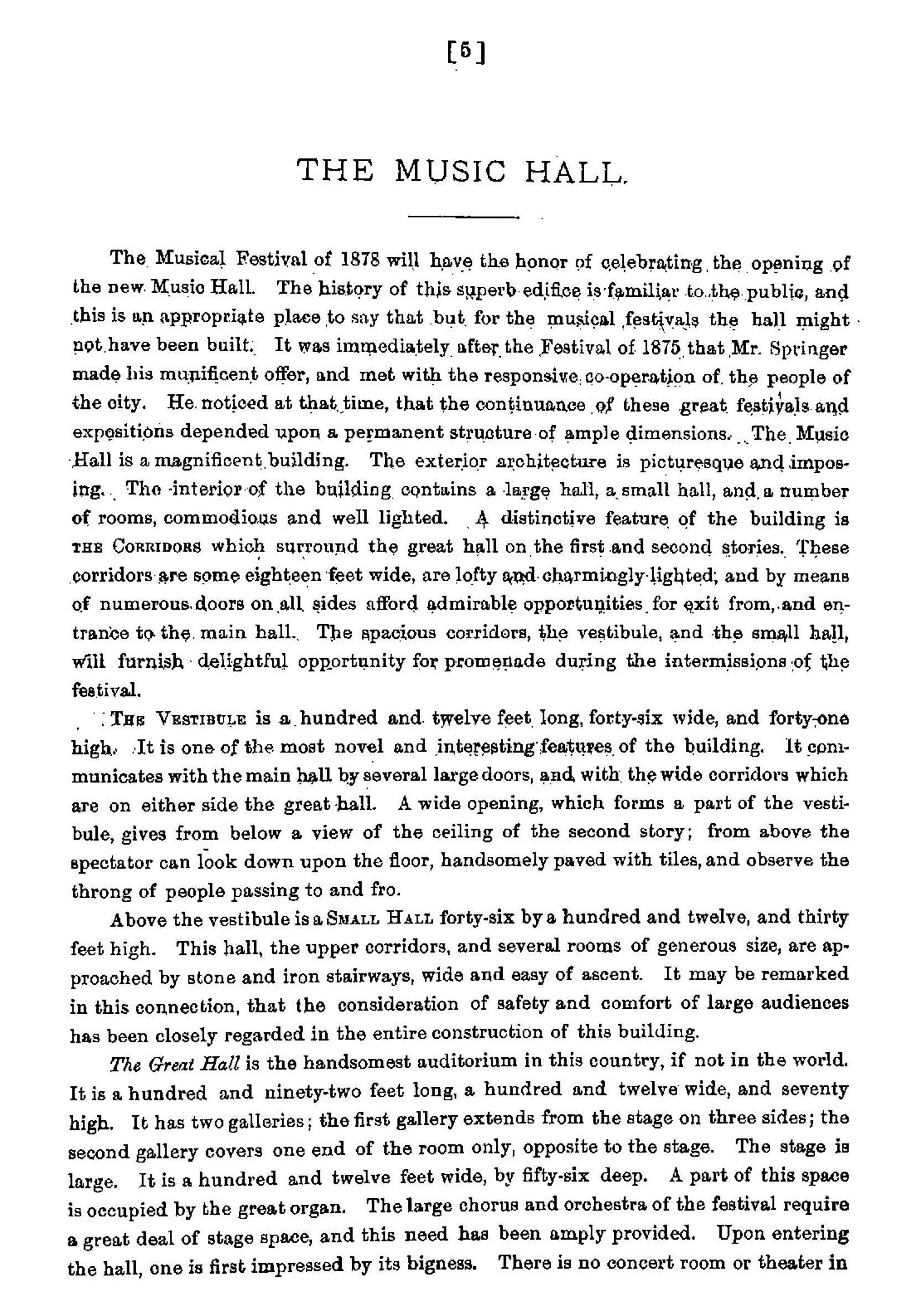



The Musical Festival of 1878 will have the honor of celebrating the opening of the new Music Hall. The history of this superb edifice is familiar to the public, and this is an appropriate place to say that but for the musical festivals the hall might not have been built. It was immediately after the Festival of 1875 that Mr. Springer made his magnificent offer, and met with the responsive co-operation of the people of the city. He noticed at that time, that the continuance of these great festivals and expositions depended upon a permanent structure of ample dimensions. The Music Hall is a magnificent building. The exterior architecture is picturesque and imposing. The interior



THE
MUSIC HALL








of the building contains a large hall, a small hall, and a number of rooms, commodious and well lighted. A distinctive feature of the building is THE CORRIDORS which surround the great hall on the first and second stories. These corridors are some eighteen feet wide, are lofty and charmingly lighted; and by means of numerous doors on all sides afford admirable opportunities for exit from, and entrance to the main hall. The spacious corridors, the vestibule, and the small hall, will furnish delightful opportunity for promenade during the intermissions of the festival.
THE VESTIBULE is a hundred and twelve feet long, forty-six wide, and forty-one high. It is one of the most novel and interesting features of the building. It communicates with the main hall by several large doors, and with the wide corridors which are on either side the great hall. A wide opening, which forms a part of the vestibule, gives from below a view of the ceiling of the second story; from above the spectator can look down upon the floor, handsomely paved with tiles, and observe the throng of people passing to and fro.
Above the vestibule is a SMALL HALL forty-six by a hundred and twelve, and thirty feet high. This hall, the upper corridors, and several rooms of generous size, are approached by stone and iron stairways, wide and easy of ascent. It may be remarked in this connection, that the consideration of safety and comfort of large audiences has been closely regarded in the entire construction of this building.
The Great Hall is the handsomest auditorium in this country, if not in the world. It is a hundred and ninety-two feet long, a hundred and twelve wide, and seventy high. It has two galleries; the first gallery extends from the stage on three sides; the second gallery covers one end of the room only, opposite to the stage. The stage is large. It is a hundred and twelve feet wide, by fifty-six deep. A part of this space is occupied by the great organ. The large chorus and orchestra of the festival require a great deal of stage space, and this need has been amply provided. Upon entering the hall, one is first impressed by its bigness. There is no concert room or theater in this country, and but two or three in Europe as large. The next impression is vivid and novel. For the first time one sees a large hall entirely lined with wood. This lining is the “golden tulip,” sometimes called poplar. It is finished with oil. The wood is rich in color, presenting an appearance of green and gold. This tint is pleasing in the highest degree. The sight of this vast room lined with golden wood, to the mind of the musician, at once suggests the thought of the violin and bass viol, and the perfection of instruments of sound. It was this question of acoustics which decided the use of wood rather than plaster, even at a greater expense. The result of this wise discretion has been eminently successful. Experiment has already proved that the acoustic properties of the hall are admirable. The organ, orchestra, chorus, and the solo voice are heard with perfect and equal distinctness. With these artistic excellencies, the hall has well-devised and sufficient ventilation, and plenty, but not excessive light. It seats some 4,400 persons, with a generous provision for those who prefer to stand. On the main floor of the hall, the seats are a comfortable chair, the seat of which may be turned up, for the convenience of passage to and fro. The seating capacity of the main floor is 2,974; the first gallery, 1,022; the second gallery, 432. The entrance doors to the main floor and galleries are numerous, on both sides and at the end of the hall. There are five aisles on the main floor; three in the center, and one on each side. The holder of a reserved seat, with a little forethought, may at once find the door nearest his seat, and save much trouble.
THE AUDIENCE enter by the doors on Elm street. THE CHORUS and other performers by the door on Plum street. The large rooms at the Plum street end of the building are reserved for the chorus and soloists and orchestra. Refreshments will be served during the intermission in the small hall and other parts of the building.


nati (forming the UC-CCM) in 1962 to create the school of music that is still active today.

Cincinnati was home to the first Black-owned conservatory in the U.S. Founded by Dr. Artie Matthews and his wife, Anna Howard, in 1921, the Cosmopolitan School of Music provided advanced educational and musical opportunities for African Americans. The June Festival, an annual African American choral festival produced by the Cincinnati Recreation Commission, was the outgrowth of increased opportunities for African Americans. From 1938 to the mid-1950s, the Festival was held mostly outdoors and drew 100–300 singers from Cincinnati to perform for crowds of thousands.
The College of Music held the city’s first opera festivals starting in 1881. These festivals were performed mostly by major touring companies. But in 1910, as part of the Cincinnati Industrial Exposition, a new opera was commissioned from faculty member Pietro Floridia; titled Paoletta, the opera premiered with unquestionable success on August 29, 1910. Twenty years later, on June 27, 1920, the Cincinnati Opera Association would be formed, making Cincinnati Opera the second oldest opera company in the U.S. the Cincinnati Zoo and Botanical Garden was the home of the Cincinnati Opera until 1972. Like the May Festival, the Cincinnati Zoo and Botanical Garden was also formed in 1873 and opened to the public in 1875.
In the realm of fine art, the Cincinnati Museum Association (known today as the Cincinnati Art Museum) was formed in 1881. The South Hall of Music Hall was the Art Museum’s temporary location
until its building in Eden Park, which remains its home today, was finished in 1886. The Art Museum currently houses an “encyclopedic art collection of more than 67,000 works spanning 6,000 years.”
For contemporary Cincinnatians, the link between the May Festival and the Cincinnati
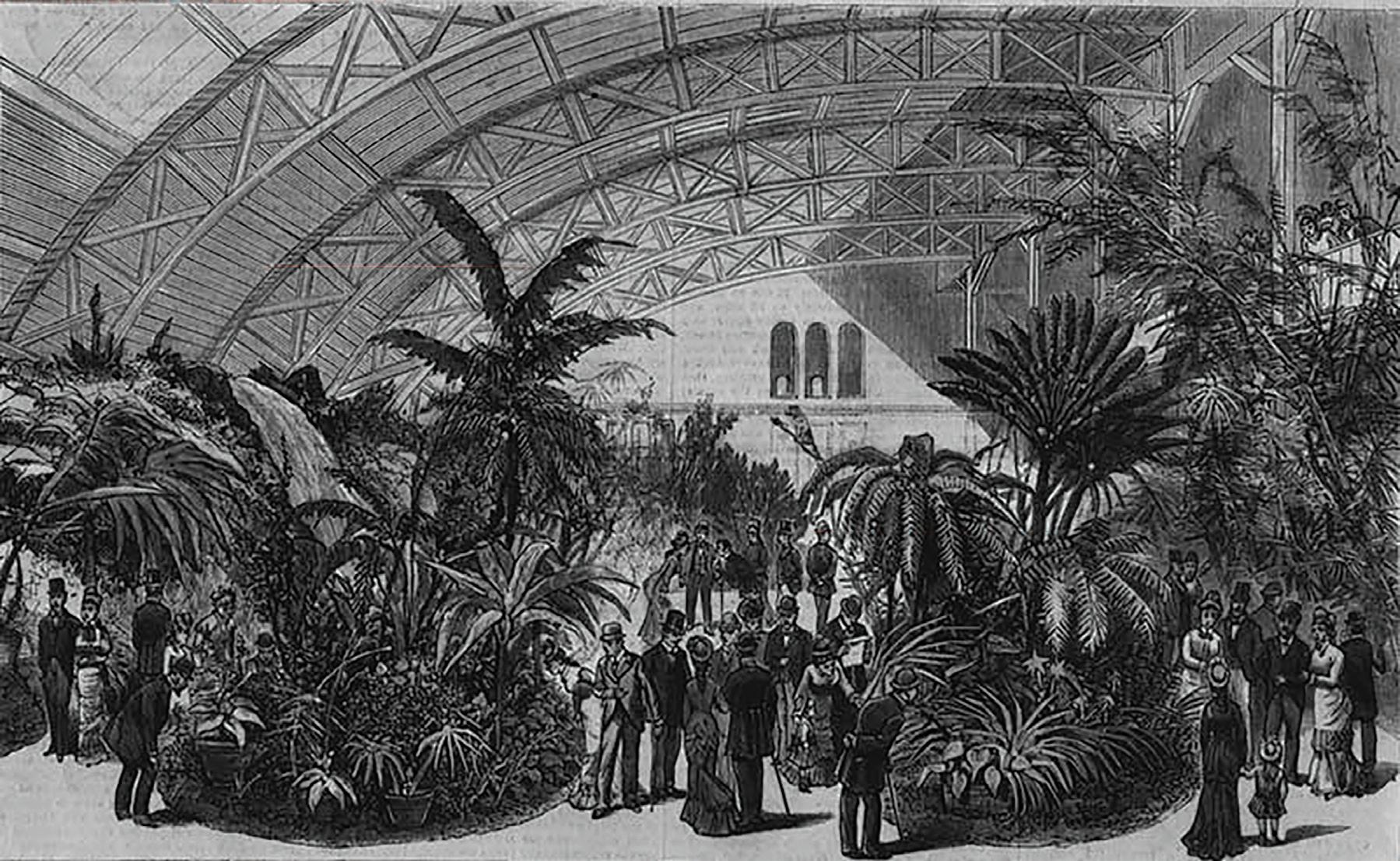
MAY FESTIVAL SPOTLIGHT
Horticulture Hall, south wing, Courtesy of the Friends of Music Hall
20 | CINCINNATI MAY FESTIVAL
The Cincinnati Orchestra Association Company incorporation document from 1894.
Symphony Orchestra is foundational, but complex. Starting in 1880, the relationship between Theodore Thomas, the May Festival and the College of Music grew bitter until the city of Chicago announced that Thomas had been hired to develop its symphony orchestra in 1891. The announcement dashed any expectations that Thomas would start a symphony orchestra in Cincinnati. Many attempts to create an orchestra in the 1880s and early 1890s had failed; then the Ladies Musical Club, which was founded in 1891 and had sponsored several concerts, turned its attention to larger goals: establishing a permanent orchestra in Cincinnati. “They determined at the outset to maintain control of the Orchestra Association, limiting men to supportive roles” (Robert C. Vitz).
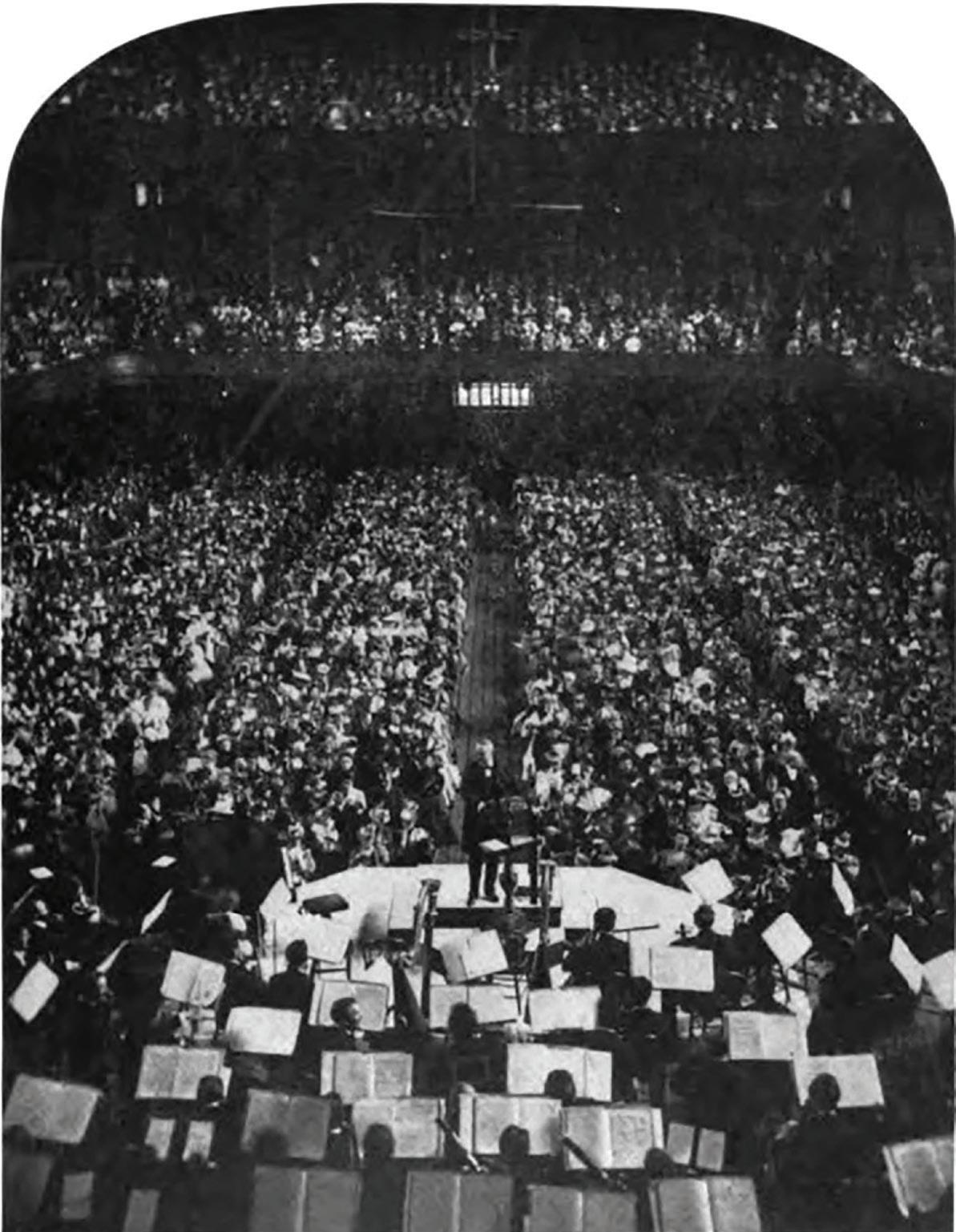
Led by Helen “Nellie” Herron Taft (who became First Lady of the U.S. when her husband William Howard Taft was elected president in 1908), the Ladies Musical Club started raising money and support for a new orchestra. Part of their planning was attempting to quell old feuds by selecting leadership that would bring Cincinnati’s fractured musical community together. Their plan was to select a music director who also directed the May Festival; however, this plan was ultimately blocked by the May Festival president. The Cincinnati Orchestra Association Company was founded in May 1894, and the Cincinnati Symphony Orchestra (CSO) held its first concert on January 17, 1895, conducted by Frank Van der Stucken. The CSO was the first orchestra in the U.S. to be founded by a group of women.
The Ladies Musical Club’s plan to see the CSO and the May Festival directed by the same person came to fruition in 1906, when the May Festival program listed Frank Van der Stucken as Music Director and the CSO as the orchestra. The CSO would remain the house orchestra of the May Festival but, in 1970, the practice of the CSO’s music director being the music director of the May Festival ended.

Today the Cincinnati Musical Festival Association and the Cincinnati Symphony Orchestra remain separate 501(c)(3) organizations, but they share administrative support through a shared services agreement that allows for combining resources and expertise to benefit all organizations.
It is a powerful testament to the people of Cincinnati who, in the
last three decades of the 19th century, organized, formed and funded major professional music ensembles that have stood the test of time and have placed Cincinnati forever on the map as one of the finest musical cities in the Midwest.
Bass-baritone Norman Treigle towers over the 1969 cast of Faust at the Cincinnati Zoo.
1894 May Festival, Theodore Thomas on stage in Cincinnati Music Hall. Photo by John Closs from Memoirs of Theodore Thomas by Rose Fay Thomas, 1911, p. 177.
MAY FESTIVAL SPOTLIGHT CINCINNATI MAY FESTIVAL | 21
Juanjo Mena began his conducting career in his native Spain as Artistic Director of the Bilbao Symphony Orchestra in 1999. His uncommon talent was soon recognized internationally with appointments as Principal Guest Conductor of the Bergen Philharmonic and Chief Guest Conductor of the Orchestra del Teatro Carlo Felice in Genoa. In 2011, he was named Chief Conductor of the BBC Philharmonic, which he led for seven seasons, taking the orchestra on tours of Europe and Asia and conducting annual televised concerts at the Royal Albert Hall as part of the BBC Proms. He currently holds the position of Principal Conductor of the Cincinnati May Festival, the longest running choral festival in North America, served by the Cincinnati Symphony Orchestra.

A sought-after guest conductor, Juanjo Mena has led Europe’s top ensembles and also appears regularly with all the major orchestras in his native Spain. Following his North American debut with the Baltimore Symphony in 2004, he has conducted most of the continent’s leading orchestras. In Asia, he is a regular guest conductor of the NHK Symphony Orchestra in Tokyo.
Juanjo Mena opened the 2022–23 season with a Carnegie Hall gala concert, leading the Teatro Real Orchestra (the Royal Opera of Madrid) in its historic Carnegie Hall debut. The concert follows Mena’s recent triumphant performances at Madrid’s Teatro Real, with Arthur Honegger’s Joan of Arc at the Stake paired with Debussy’s La damoiselle élue staged in June 2022. Other guest performances this season include his debut with the Dallas Symphony and the Czech Philharmonic and returns to the Minnesota Orchestra, Bamberg Symphony, Lucerne Symphony, Dresden Philharmonic, BBC Philharmonic, Cincinnati Symphony, Danish National Orchestra, Oslo Philharmonic and the Spanish National Orchestra. May 2023
marks Juanjo Mena’s final performances as Principal Conductor of the May Festival, concluding his pivotal six-year tenure at the organization, during which he has expanded commissioning of new works and put the community at the heart of the Festival. The Cincinnati May Festival’s 150th Anniversary program will culminate with Mena leading Mahler’s Eighth Symphony.
Juanjo Mena’s operatic work includes Wagner’s The Flying Dutchman; Richard Strauss’ Salome, Elektra and Ariadne auf Naxos ; Bartók’s Duke Bluebeard’s Castle;and Schoenberg’s Erwartung, as well as productions of Tchaikovsky’s Eugene Onegin in Genoa, Mozart’s The Marriage of Figaro in Lausanne, and Beethoven’s Fidelio and Britten’s Billy Budd in Bilbao.







His latest release, of Bruckner’s Symphony No. 6 with the BBC Philharmonic on Chandos, has been described by The Classical Review as “intensely musical,” “impressive” and with a “spectacular sound.” Mena’s rich discography with the BBC Philharmonic on Chandos also includes an acclaimed Gabriel Pierné release selected as a Gramophone Editor’s Choice, Weber symphonies, Ginastera’s orchestral works to mark the composer’s centenary, and new reference recordings of lesser-performed Spanish repertoire including Arriaga’s orchestral pieces, works by Albéniz, Montsalvatge and Turina, as well as three discs of works by Manuel de Falla featuring his opera La vida breve. In 2012, Juanjo Mena recorded Messiaen’s Turangalîla-Symphonie with the Bergen Philharmonic for the Hyperion label, a disc said to “utterly redefine the terms under which past/current/future Turangalîlas need to be judged” (Gramophone).



Juanjo Mena studied conducting with Sergiu Celibidache following his musical education at the Madrid Royal Conservatory, where he was mentored by Carmelo Bernaola and Enrique García Asensio. In 2016, he was awarded the Spanish National Music Award. He lives with his family in his native Basque Country.

JUANJO MENA
Photo: Michal Novak
Principal Conductor
22 | CINCINNATI MAY FESTIVAL
LEADERSHIP
MAY FESTIVAL CHORUS
ROBERT PORCO, Director of Choruses
Matthew Swanson, Associate Director of Choruses
Heather MacPhail, Accompanist
Christin Sears, Conducting Fellow
Kathryn Zajac Albertson, Chorus Manager
Bryce Newcomer, Chorus Librarian
The May Festival Chorus has earned national and international acclaim for its musicality and command of repertoire. Consisting of 130 avocational singers who collectively devote more than 45,000 hours in rehearsals and performances annually, the Chorus is the core artistic element of the Cincinnati May Festival and the official chorus of the Cincin-

nati Symphony Orchestra (CSO) and Cincinnati Pops. The premier choral ensemble in Cincinnati, the May Festival Chorus has garnered national and international attention through numerous PBS broadcasts and award-winning recordings, many in collaboration with the CSO and Pops. Most recently, a live recording of Robert Nathaniel Dett’s The Ordering of Moses featuring Music Director Laureate James Conlon conducting the Chorus and CSO at Carnegie Hall was released to critical acclaim in 2016 on Bridge Records, and, in 2017, the Chorus re-released its popular a cappella holiday recording Christmas with the May Festival Chorus on the Fanfare Cincinnati label. The Chorus is also featured on several Pops recordings, which have sold over 10 million copies worldwide.
THE MAY FESTIVAL CHORUS
Soprano
Natalie Badinghaus
Tracy Bailey
Karen Bastress
Laurel Boisclair Ellsworth
Dawn Bruestle
Caitlyn Byers
Joanna Chapman
Renee Cifuentes
Ally Clifton
Kathy Dietrich
Jennifer Dobson
Rachel Dummermuth
Sarah Evans
Jennifer Fillare
Anita Marie Greer
Melissa Haas
Gaynelle Hardwick
Dana Harms
Mary Wynn Haupt
Carolyn Hill
Sara Hook
Alexandra Kesman
Lisa Koressel
Judith C. LaChance
Hilary Landwehr
Julia Lawrence
Julia Marchese
Audrey Markovich
Alison Peeno
Lauren Peter
Kristi C. Reed
Beth Roberts
Justine Alexandra Samuel
Noelle Scheper
Julia H. Schieve
Christin Sears
Yvon F. Shore
Mary Ann Sprague
Alex Vale
Erika Walker
Patricia Wilkens
Taraneh R. Wilkinson
Samantha Zeiger
Alto
Kathy Falcon
Sarah Fall
Lindsey Fitch
Alexis Gabbard
Amanda Gast
Sally Vickery Harper
Sarah Horseman
Beth Huntley
Spence B. Ingerson
Karolyn L. Johnsen
Jenifer Klostermeier
Julie Laskey
Megan Lawson
Katherine Loomis
Elaine P. Lustig
Kathy Mank
Melissa Martin
Teri McKibben
Jennifer Moak
Amy M. Perry
Kate Robertson
Christy Roediger
Amanda Schwarz Rosenzweig
Karen Scott-Vosseberg
Rachel Seymour
Sarah Stoutamire
Kristie Stricker
Christine Wands
Megan Weaver
Robin Rae Wiley
Tenor
Matthew Swanson
Lawrence Adams
Lydia Rose Ball
Avery Bargasse
David Bower
Douglas Easterling
David Gillespie
Robert Henderson
Fansheng Kong
Elijah Lanham
Kevin Leahy
Matthew Leonard
Robert Lomax
Andrew Miller
H. Scott Nesbitt
Jason Ramler
Larry Reiring
Edward Rosenberry
Austin Schafer
Adam Shoaff
David W. Skiff
Jeffrey Stivers
Matthew Swope
Stephen West
Barry Zaslow
Bass
Mark Barnes
Jim Baxter
Richard Becker
Nathan Bettenhausen
Andrew L. Bowers
Scott Brody
Darren Bryant
Christopher Canarie
Matthew Cheek
Lawrence Coleman
Antonio Cruz
Steven L. Dauterman
David Dugan
Grant Ebert
Steve France
Mark Hockenberry
Kim P Icsman
Christopher Kanney
Takuya Konishi
D. Stuart Lohrum
John McKibben
Daniel Parsley
Michael Pekel
Justin Peter
James V. Racster
Mitch Radakovich
Brian Reilly
Joshua Wallace
Mark Weaver
Paul Wessendarp
Tommy Wessendarp
MAY FESTIVAL CHORUS & CHORUS
The May Festival Chorus is endowed by the Betsy & Alex C. Young Chair
CINCINNATI MAY FESTIVAL | 23
Credit: Mark Lyons
ROBERT PORCO, Director of Choruses
Recognized as one of the leading choral musicians in the United States, Robert Porco has been an active preparer and conductor of choral and orchestral works and a highly regarded educator in the practice and art of conducting and choral leadership for more than 40 years.
The 2022–23 season is Porco’s 34th as Director of Choruses of Cincinnati’s May Festival, starting in the position in 1989. In 2011, Porco received Chorus America’s Michael Korn Founders Award for Development of the Professional Choral Art. In 2021 and 2022, the May Festival, with the May Festival Chorus (MFC) at its core, was named “One of the Best Classical Music Festivals in the U.S. and Canada” by BBC Magazine
Notable performances during Porco’s tenure with the May Festival have included the 2010 premiere he led of Out of the Cradle Endlessly Rocking, a piece commissioned by the MFC in honor of Porco’s 20th season as director. Acclaimed Carnegie Hall performances he prepared include Mendelssohn’s Elijah in 1991 with Jesús López Cobos, the MFC and the Cincinnati Symphony Orchestra (CSO); Mahler’s Symphony No. 8 in 1995 with Robert Shaw, the MFC, The Cleveland Orchestra, and other choruses; and Britten’s War Requiem in 2001 with James Conlon, the MFC and the CSO. The 2014 performance of R. Nathaniel Dett's The Ordering of Moses and John Adams' Harmonium, with the MFC, Conlon and the CSO, “shook the rafters…. Carnegie has seldom felt so alive,” according to The New Yorker.
The MFC’s 2008 performance of the Pulitzer Prize-winning On the Transmigration of Souls, under the baton of composer John Adams, led Adams to write, “The pure American quality of their enunciation and their perfectly balanced sonorities lifted the matter-of-fact plainness of the words to a transcendental level, and for once the piece did not seem as compromised and uneven as I had previously thought.”
Porco’s conducting career has spanned geographic venues across western Europe and the U.S., including performances in the Edinburgh Festival; Taipei, Taiwan; Lucerne, Switzerland; Tel Aviv and Jerusalem, Israel; and Reykjavík, Iceland; and in the May Festival, Tanglewood Music Festival, Berkshire Music Festival, Blossom Festival and Grant Park Festival. He has guest conducted at the May Festival since 1991, with the Cincinnati Symphony Orchestra since 1996, and with The Cleveland Orchestra since 2000.
From 1998 to 2017, Porco was Director of
Choruses for The Cleveland Orchestra, preparing the Cleveland Orchestra Chorus (COC) for appearances in Severance Hall and the Blossom Festival and with the Orchestra at the Edinburgh Festival in 1999, at Carnegie Hall in 2002 and at the Lucerne Festival and London Proms in 2005. Porco’s work during the 2013–14 season included preparing the COC for its debut with the Orchestra in Frankfurt, Paris and Luxembourg. From 1988 to 1998, Porco was Artistic Director and Conductor of the Indianapolis Symphonic Choir.
Porco has gained national recognition for his preparation of choruses for prominent conductors such as John Adams, Pierre Boulez, James Conlon, Andrew Davis, Christoph von Dohnányi, Paavo Järvi, Erich Kunzel, Raymond Leppard, James Levine, Jahja Ling, Louis Langrée, Jesús López Cobos, Zubin Mehta, Juanjo Mena, John Nelson, André Previn, Kurt Sanderling, Leonard Slatkin, Robert Shaw, Franz Welser-Möst, John Williams and David Zinman.

Porco taught doctoral-level choral conducting at the Indiana University Jacobs School of Music from 1979 to 1998, in addition to serving as Department Chair, and returned as a guest instructor in 2011 and 2012. A highlight of his tenure at IU included leading a wholly student choral and orchestral ensemble of 250 in a highly acclaimed performance of Leonard Bernstein’s MASS as part of the Tanglewood Music Festival’s celebration of the composer’s 70th birthday. As teacher and mentor, Porco has guided and influenced the development of hundreds of musicians, most of whom are now active as professional conductors and singers, and as teachers in public and private schools and in schools of music. Porco remains a sought-after guest instructor and coach for conservatory students, young professional conductors, and singers. His guest teaching venues have included Harvard University, the University of Miami Frost School of Music, the University of Cincinnati College Conservatory of Music and Westminster Choir College (Princeton, NJ).
MATTHEW SWANSON, Associate Director of Choruses
Matthew Swanson is the Associate Director of Choruses, the Director of the Youth Chorus, and the Director of Special Projects at the Cincinnati May Festival. He annually prepares the May Festival Chorus and Youth Chorus for performances with the Cincinnati Symphony and Pops Orchestras and for their featured appearances at the May Festival. Additionally, he develops and

MAY FESTIVAL CHORUS & CHORUS LEADERSHIP
Credit: Roger Mastroianni
24 | CINCINNATI MAY FESTIVAL
Credit: Krista DeVaul
produces special projects for the May Festival in collaboration with local, regional and national organizations.
Highlights of his tenure at the May Festival include the creation of an annual Youth Chorus commissioning project; the presentation of community choral concerts during the May Festival; a robust program of professional voice instruction, free to Chorus and Youth Chorus members; the Festival’s community choral podcast “Sing the Queen City”; and free in-school choral clinics for area middle and high schools. His portfolio of special projects at the May Festival has included staged productions of Leonard Bernstein’s MASS (2018) and Candide (2022), the formation of the May Festival Community Chorus, and 25 for 25, the May Festival’s 2023 collaborative commissioning project.
Beyond the May Festival, his affiliations have included the Mostly Mozart Festival at Lincoln Center (New York), Schola Antiqua (Chicago), and the National Youth Choirs of Great Britain. In the 2022–23 season, he conducts the Xavier Choir and teaches choral methods and conducting at Xavier University, and he leads Vox Antiqua, an ensemble of the Early Music Lab at the University of Cincinnati’s College-Conservatory of Music (UC-CCM).
Matthew Swanson is a native of southeast Iowa. He earned an undergraduate degree in trumpet performance and American Studies at the University of Notre Dame, master’s degrees in choral conducting and choral studies from UC-CCM and King’s College, Cambridge, respectively, and a doctorate of musical arts in conducting from UCCCM. He was awarded the May Festival Choral Conducting Fellowship in 2015.
HEATHER MacPHAIL, Accompanist
Heather MacPhail has been the accompanist for the May Festival Chorus since 1990. She is a frequent keyboardist with the Cincinnati Symphony Orchestra, performing on all keyboard instruments, and has been organ soloist for the Saint-Saëns Organ Symphony in several performances. MacPhail has been Staff Accompanist at Miami University since 1997. There, she supervises and coaches students in accompanying, teaches organ, and performs with faculty and guest artists. MacPhail has performed as piano soloist with the Oxford String Quartet, Miami University Orchestra and Central Ohio Symphony Orchestra. She performs regularly on local concert series, such

as Christ Church Glendale Music at Noon, Holy Trinity Episcopal Noon Series and Westwood First Concert Series.
Heather MacPhail is Organist/Director of Music
Ministries at Westwood First Presbyterian Church in Cincinnati. She maintains a private teaching studio for piano and organ, with students active in competitions and recitals. She holds a Master of Music degree in Accompanying and a Bachelor of Music degree in Piano Performance from the University of Cincinnati College-Conservatory of Music.
CHRISTIN SEARS
May Festival Conducting Fellow
Christin Sears is a first-year doctoral student in Choral Conducting at the University of Cincinnati CollegeConservatory of Music. She graduated summa cum laude from Texas State University, receiving her bachelor’s and master’s degrees in Music Education and Choral Conducting, completing her study in 2010. While at Texas State, Sears received numerous scholarships in recognition of her academic and musical achievements. In her final year, the faculty awarded her the Presser Foundation Scholarship, honoring her academic standing, leadership and extracurricular involvement.
Sears taught for 12 years as a school choral director in the Houston area and was selected the First Year Teacher of the Year at her first appointment. In 2013, Christin Sears became the founding choir director at Obra D. Tompkins High School in Katy, Texas. The Tompkins Chorale received the highest honor of being selected to perform at the 2019 Texas Music Educators Association Convention and, in the same year, was named the Overall Winner of the Celebration of Excellence Choral Festival.
Sears is an active clinician, soloist, and singer in professional ensembles. She served as the soprano section leader and sang seven seasons with CANTARE Houston. Christin Sears is happy to be newly wed to her husband, Timothy Sears, and is grateful for his unending love and support.
The May Festival is grateful to Ginger Warner for her generous support of the Conducting Fellowship.
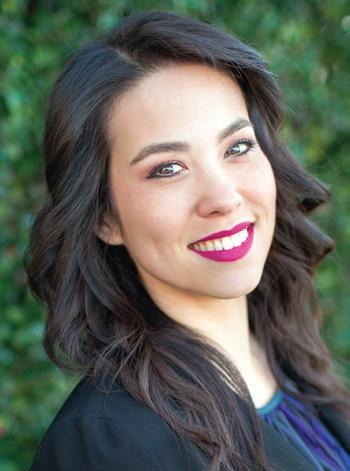
MAY FESTIVAL CHORUS & CHORUS LEADERSHIP
CINCINNATI MAY FESTIVAL | 25
MAY FESTIVAL YOUTH CHORUS MATTHEW SWANSON, Director
David Kirkendall, Accompanist and Assistant Director
Dr. Eva Floyd, Musicianship Instructor
Kathryn Zajac Albertson, Chorus Manager
Bryce Newcomer, Chorus Librarian
The May Festival Youth Chorus connects, inspires and educates young people through the study and performance of choral music. Since its founding in 1987, the Youth Chorus has appeared annually at the May Festival to perform choral-orchestral works with the May Festival Chorus, the Cincinnati Symphony Orchestra, and internationally renowned conductors and soloists. In addition, the Youth Chorus presents its own concert series and collaborates with cultural institutions and organizations throughout greater Cincinnati.
Highlights of the Youth Chorus experience include a broad range of repertoire; annual commissions and world premieres; free professional voice instruction; access to free and discounted tickets to the May Festival, CSO and Pops concerts; frequent concert appearances with the CSO and Pops at Music Hall and Riverbend Music Center; and a community of enthusiastic and skilled peer musicians from across the Tri-State. Notably, the Youth Chorus is tuition-free; acceptance is based solely on ability.
DAVID KIRKENDALL, Accompanist and Assistant Director
David Kirkendall has served as assistant director and accompanist for the May Festival Youth Chorus since 2006. He was choral director at Princeton High School in Cincinnati from 1980 to 2013, and
THE MAY FESTIVAL YOUTH CHORUS
Brayden Adams
Ava Altenau
Sam Bringle
Calia Burdette
Anna Burkhart
Angelina Bush
Cameron Carnahan
Timothy Carnahan
Ella Clark
Sophia Clever
William Demeter
Gabrielle Dodd
Margaux Flaig
Gwyneth Gaunt
Caroline Gneuhs
Mary Hollon
Natalie Hoover
Madeleine Kasman
Katie Kear
Emily Lynch
Cecelia McDaniel
Sophia Nery
Charlie Rahner
Nikki Tayidi
Abby Turner
Rhea Umrani
Ansley Varisco
Celia Wallace
Olivia Wetzel
Sam Wright
for three years he served as choral director at Mount Saint Joseph University.
After earning his undergraduate degree, Kirkendall continued at the University of Cincinnati College-Conservatory of Music, receiving a master’s degree in Choral Conducting. He received a fellowship to attend the Choral Conducting Institute at the Aspen Music Festival, and has also completed studies for the Doctor of Musical Arts degree in Choral Conducting at the University of Illinois. His keyboard reductions and continuo realizations appear in the Roger Dean edition of the Vivaldi Gloria, and he has had an SSA arrangement published with Alfred Music Publishing.
EVA
FLOYD, Musicianship Instructor
Eva Floyd is an associate professor of choral music education at the University of Cincinnati CollegeConservatory of Music (CCM), where she teaches Choral Methods, Literature for School Choir, History and Philosophy of Music Education, and Kodály Musicianship classes for music education graduate students. Floyd is also the founder and conductor of the CCM Community Women’s Choir.
The Organization of American Kodály Educators published a DVD documentary of Soul-fege: A Journey from Soulful Genres to the Classics, which chronicles Eva Floyd’s collaboration with the Voices of Unity Gospel Youth Choir to prepare for an honor choir festival in Budapest using Kodályinspired teaching techniques.
The May Festival Youth Chorus is financially assisted by the ongoing support of ArtsWave and the Ohio Arts Council. The Wohlgemuth Herschede Foundation




MAY FESTIVAL YOUTH CHORUS
26 | CINCINNATI MAY FESTIVAL
Credit: JP Leong
CINCINNATI BOYCHOIR
JASON ALEXANDER HOLMES, Artistic Director
Lisa Peters, Associate Director
Patrick Apfelbeck, Program Coordinator
Carmen Greiner, Executive Director
Stacey Devlin, Finance Manager
Cincinnati Boychoir is a choir for male-identifying youth of all musical abilities from across the greater Cincinnati region. Founded in 1965, the Boychoir is a teaching and performing organization that offers musical enrichment, performance and touring opportunities.

Cincinnati Boychoir vocal ensembles are directed by professional music educators who teach a curriculum not only of musical skills but also of cultural appreciation, empathy, selfdiscipline, leadership, mentorship, and a spirit of volunteerism.
In its core ensembles, boys from grades 3 through 12 attend weekly rehearsals for a full academic year. Each week, all boys come together for a combined rehearsal in which older boys are empowered as big brothers to younger boys, teaching them the nuts and bolts of music and singing, as well as how to tie their bowties, and more.
Cincinnati Boychoir presents approximately 20 annual performances in the greater Cincinnati region, and members have performed concerts and completed residencies both at home and abroad.
The Boychoir strives to be accessible to boys of all racial, ethnic and socioeconomic backgrounds, offering them the opportunity to experience the lifechanging impact of immersive arts participation.
JASON ALEXANDER HOLMES, Artistic Director

Jason Alexander Holmes is a music educator and performer from Ridgeway, Virginia, and currently serves as the Artistic Director of the Cincinnati Boychoir, the director of Cincinnati's MLK Chorale, and the Associate Musician for Children and Youth at Christ Church Cathedral in Cincinnati. Before coming to Cincinnati, he was Director of Educational Programming at the Boston Children’s Chorus. Prior to his time in Boston, Jason taught music at the elementary and secondary levels. He also led the University of Rochester Gospel Choir
and the Eastman Young Children’s Chorus. Jason holds degrees from the Eastman School of Music and Ithaca College, where his mentors and teachers included Drs. Susan Wharton Conkling, William Weinert and Susan Avery.
Choirs under Jason’s direction are consistently praised for their energetic, unified tone and engaging performances. He is known for innovative programming that celebrates the cultural context while encouraging singers and audiences alike to stretch their awareness by living in many different musical worlds. Pedagogically, Jason is committed to implementing culturally responsive practices in music education. He has given workshops and conference sessions on this topic at professional development seminars, schools and conferences.
At the core of Jason’s teaching and performing is the belief that we are all expressive and musical beings who deserve to witness and participate regularly in moments of truth and beauty.
Bryce Biedenharn
Garrett Cetti
Seth Coppens
Santiago Dreher
Alexander Gentil
James Harper
Joel Leptak-Moreau
Jackson Metz
Joshua Moore
Aaron Pankey
Andrew Prevost
Owen Riker
Lawrence Riley
JeKorey Spencer
Enairs Turnbow
GUEST CHORUS
The Cincinnati Boychoir was prepared by Lisa Peters for these performances.
CINCINNATI MAY FESTIVAL | 27
CINCINNATI BOYCHOIR
JACQUELINE ECHOLS, soprano
Lyric soprano Jacqueline Echols has been praised for her “dynamic range and vocal acrobatics” ( Classical Voice) in theaters across the United States. In the summer of 2022, Echols reprised her acclaimed portrayal of Clara in Porgy and Bess in her debut with Des Moines Metro Opera, in addition to her debut with The Cleveland Orchestra for their annual Martin Luther King Jr. Celebration Concert, and her return to Cincinnati Opera for a special performance alongside Morris Robinson in Morris and Friends.
In the 2022–23 season, she returns to LA Opera as Julie in Rhiannon Giddens’ and Michael Abels’ Omar, debuts the role of Juliette in Roméo et Juliette with Opera San Antonio, and makes her long-awaited return to the Kennedy Center reprising the role of Musetta in La bohème with Washington National Opera.
In the 2021–22 season, Echols was featured at The Metropolitan Opera both as Clara in Porgy and Bess and as Noémie in The Met’s family adaptation of Massenet’s Cendrillon. Additional performances at The Met include Pousette in Manon and Musetta in La bohème. She has been seen at the Kennedy Center/Washington National Opera in the title role of La traviata, Sister Helen in Jake Heggie’s Dead Man Walking, Micaela in Carmen, as well as Woglinde/Forest Bird in Der Ring des Nibelungen.

On the concert stage, Echols performed with the Ann Arbor Symphony for their 2017 seasonopening gala concert and returned for her first performances of Beethoven’s Symphony No. 9. She made her debut with the Memphis Symphony in Handel’s Messiah.
Echols is a 2012 second prize winner at the Gerda Lissner International Vocal Competition. She completed her master’s degree and artist diploma at the University of Cincinnati College-Conservatory of Music, where she appeared as the Female Chorus in The Rape of Lucretia, the Countess in The Marriage of Figaro, Anne Truelove in The Rake’s Progress, and Pamina in The Magic Flute L2artists.com/jacqueline-echols
RODRICK DIXON, tenor
Rodrick Dixon possesses a tenor voice of extraordinary range and versatility that has earned him the respect and attention of leading conductors, orchestras and opera companies.

Notable operatic engagements include Los Angeles Opera, Michigan Opera Theater, Todi Music Festival, Portland Opera, Opera Columbus, Cincinnati Opera and Opera Southwest in roles including the title role of Zemlinky’s Der Zwerg, Walther von der Vogelweide in Tannhäuser, Tonio in La fille du régiment, Lenski in Eugene Onegin, the title role of Les contes d’Hoffmann, Prince in Vanqui, Sportin’ Life in Porgy & Bess, the Duke in Rigoletto, and the title role in Rossini’s Otello.
On the concert stage, Rodrick Dixon is a regular guest of the Cincinnati May Festival, including for Nathaniel Dett’s The Ordering of Moses in Cincinnati and in New York’s Carnegie Hall.
He was tenor soloist for The Philadelphia Orchestra composer-in-residence Hannibal Lokumbe in world premieres of Healing Tones and One Land, One River, One People; he also performed in Lokumbe’s historic Crucifixion Resurrection, presented by the orchestra in honor of the nine church members who lost their lives during Bible study in Charleston, SC.
Dixon’s extensive television credits include several PBS specials and guest appearances on network and cable television shows. Musical theater credits include the original cast of Ragtime on Broadway. He appears in the annual Too Hot to Handel Christmas concerts at the Detroit Opera House and Chicago’s Auditorium Theatre.
Recordings for Sony/BMG include PBS Great Performances Cook, Dixon & Young Vol. 1 (2005), Follow that Star Christmas CD (2003), Liam Lawton’s Sacred Land (2006), and Rodrick Dixon Live in Concert (2008), and a Christmas album with the Cincinnati Pops.
tenorroddixon.com
GUEST SOLOISTS 28 | CINCINNATI MAY FESTIVAL
Photo: Dan Demetriad
ERIC GREENE, baritone

American baritone Eric Greene’s current and future engagements include Benny “Kid” Paret and Benny Paret Jr. in Terence Blanchard’s Champion with The Metropolitan Opera; Rigoletto (title role) with Opera North; Dallapiccola’s Il prigioniero (title role) with the London Symphony Orchestra, Mo. Pappano conducting; Escamillo in Carmen with Liceu Barcelona; Porgy and Bess with Musikfest Bremen and Quincena Musical de San Sebastian; Beethoven’s Symphony No. 9 with La Fondazione Arturo Toscanini, Fabio Luisi conducting; and The Word/Voice of God in Dett’s The Ordering of Moses with City of Birmingham Symphony Orchestra and at Carnegie Hall.
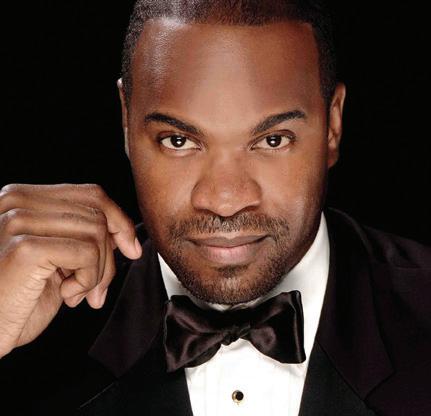
Most recent engagements include Wotan in Das Rheingold with City of Birmingham Symphony Orchestra (CBSO); Porgy with Theater an der
Wien and English National Opera; Monterone in Rigoletto at the Royal Opera House, Covent Garden (debut); Richard Nixon in Nixon in China with Scottish Opera; Amonasro in Aida with Opera North; Mozart’s Requiem with the Cincinnati Symphony Orchestra; Beethoven’s Symphony No. 9 with CBSO; the leading role of Oberon in Hans Gefors’ Der Park with Malmö Opera; Trinity Moses in Aufstieg und Fall der Stadt Mahagonny with the Salzburger Landestheater and Bill in Aufstieg… with Teatro dell’opera di Roma; Henry Davis in Weill’s Street Scene with Teatro Real; the leading role of Janitor in Tansy Davies’ Between Worlds (world premiere) with English National Opera at the Barbican; Donner in Das Rheingold and Gunther in Götterdämmerung with Teatro Massimo in Palermo; The Knife of Dawn (world premiere) at Roundhouse; Ivan Khovansky in Khovanshchina, Aeneas in Dido and Aeneas and Segismundo in Jonathan Dove’s Life is a Dream (world premiere) with Birmingham Opera; Billy Bigelow in Carousel with Opera North at the Barbican; and many others. atholestill.com/artist/eric-greene

GUEST SOLOISTS ARE YOU STILL MANAGING YOUR CHOIR THE H A R D HARD WAY? Manage members, events, repertoir, and much more Multiple ensembles Integrated event ticketing Membership fees invoicing 30-day free trial “...really great and intuitive” “...very professional and easy to use” “...HarmonySite has proved an excellent asset” HarmonySite is... •A comprehensive, centralized online suite of choirmanagement tools •A gorgeous website to promote your choir •A communications hub for your members ...all wrapped up into one integrated user-friendly package Use promocode ACDArocks for a 50% discount off your first year. .com Try HarmonySite, used by hundreds of choirs all around the world. CINCINNATI MAY FESTIVAL | 29
COMING UP WITH THE CSO & POPS
MAR 2023
DEATH & TRANSFIGURATION
MAR 4 & 5 SAT 7:30 pm; SUN 2 pm*
Louis Langrée conductor
Elizabeth Freimuth horn
R. STRAUSS Horn Concerto No. 1
Samuel ADAMS Variations [World Premiere, CSO Co-Commission]
R. STRAUSS Death and Transfiguration
Film In Concert MARVEL’S BLACK PANTHER
MAR 10–12 FRI & SAT 7:30 pm; SUN 2 pm
THE MERMAID
MAR 17 & 18 FRI & SAT 7:30 pm
Kevin John Edusei conductor
Simone Lamsma violin
F. MENDELSSOHN Die schöne Melusine (“The Fair Melusine”)
E. KORNGOLD Violin Concerto
A. ZEMLINSKY Die Seejungfrau (“The Mermaid”)
BEETHOVEN’S FIFTH
MAR 24–26 FRI 11 am; SAT 7:30 pm; SUN 2 pm
Anna Rakitina conductor
Sterling Elliott cello
A. DVOŘÁK Cello Concerto
Richard AYRES No. 52, I.Saying Goodbye
L.v. BEETHOVEN Symphony No. 5
Lollipops Concert SHERLOCK HOLMES AND THE CASE OF THE MISSING MAESTRO
MAR 25 SAT 10:30 am
Concert Sponsor: Cincinnati Symphony Club









CSO PROOF: SURREALIST EL TROPICAL
MAR 29 & 30 WED & THU 8 pm
Rosie Herrera Dance Theatre
Rosie Herrera choreographer
Clyde Scott video and production designer
Luke Kritzeck lighting and production designer
APR 2023
SHOSTAKOVICH SYMPHONY NO. 5
APR 7 & 8 FRI & SAT 7:30 pm
Louis Langrée conductor
Stephen Hough piano
Daníel BJARNASON New Work, Part I [US Premiere, CSO Co-Commission]
S. RACHMANINOFF Piano Concerto No. 1
D. SHOSTAKOVICH Symphony No. 5
CLASSICAL ROOTS
APR 14 FRI 7:30 pm*

John Morris Russell conductor
Classical Roots Community Choir
Artist Sponsor: Jeffrey & Jody Lazarow and Janie & Peter Schwartz Family Fund
PICTURES AT AN EXHIBITION
APR 15 & 16 SAT 7:30 pm; SUN 2 pm
Ramón Tebar conductor
Steven Banks saxophone
N. RIMSKY-KORSAKOV Russian Easter Overture
Billy CHILDS Saxophone Concerto [CSO Co-Commission]
M. MUSSORGSKY Pictures at an Exhibition (arr. Ravel)
MAHLER SYMPHONY NO. 7
APR 21 & 22 FRI 11 am; SAT 7:30 pm
Matthias Pintscher conductor
G. MAHLER Symphony No. 7
Concert Sponsor: Peter Landgren and Judith Schonbach Landgren
BEN FOLDS
APR 25 TUE 7:30 pm
Ben Folds singer-songwriter-pianist
RAGTIME In Concert
APR 28-30 FRI & SAT 7:30 pm; SUN 2 pm
John Morris Russell conductor
MAY 2023




SAINT-SAËNS ORGAN SYMPHONY
MAY 5-7 FRI & SAT 7:30 pm; SUN 2 pm
Louis Langrée conductor
Víkingur Ólafsson piano
Friday & Saturday
H. BERLIOZ Overture to Lesfrancs-juges (“The Judges of the Secret Court”)
M. RAVEL Concertoin G Major for Piano and Orchestra
C. SAINT-SAËNS Symphony No. 3, Organ
Sunday
H. BERLIOZ Overture to Lesfrancs-juges (“The Judges of the Secret Court”)

H. BERLIOZ “Marche des Gardes ” from Les francs-juges (“The Judges of the Secret Court”)








C. SAINT-SAËNS Danse macabre
C. SAINT-SAËNS Symphony No. 3, Organ
AN AMERICAN IN PARIS
MAY 12 & 13 FRI 11 am; SAT 7:30 pm
Louis Langrée conductor
Courtney Bryan piano and composer
D. MILHAUD La création du monde (“The Creation of the World”)

Courtney BRYAN Piano Concerto [World Premiere, (orchestral version), CSO Co-Commission]
D. ELLINGTON Night Creature
G. GERSHWIN An American in Paris (ed. Clague)
Presenting Sponsor: HORAN
FOR A FULL LIST OF UPCOMING EVENTS AND ADDITIONAL INFO VISIT
CINCINNATISYMPHONY.ORG




Louis Langrée Music Director • John Morris Russell Cincinnati Pops Conductor
* For more info on our livestreams visit cincinnatisymphony.org/ live
Music Hall | 1241 Elm St | Cincinnati, OH | 45202

With a legacy dating back 128 years, the Cincinnati Symphony Orchestra (CSO) is considered one of America’s finest and most versatile ensembles. Led by Louis Langrée since 2013, the CSO’s distinguished roster of past music directors includes Leopold Stokowski, Eugène Ysaÿe, Fritz Reiner, Max Rudolf, Jesús López Cobos and Paavo Järvi. Matthias Pintscher is the Orchestra’s Creative Partner, and previous artistic partners have included Lang Lang, Philip Glass, Branford Marsalis and Jennifer Higdon. The Orchestra also performs as the Cincinnati Pops, founded by Erich Kunzel in 1977 and currently led by John Morris Russell with Damon Gupton serving as Principal Guest Conductor. The CSO further elevates the city’s vibrant arts scene by serving as the official orchestra for the Cincinnati May Festival, Cincinnati Opera and Cincinnati Ballet.


The CSO has long championed the composers and music of its time and has given historic American premieres by Claude Debussy, Gustav Mahler, Richard Strauss, Maurice Ravel, Béla Bartók, William Grant Still and other prominent composers. It has also commissioned many works that ultimately became mainstays of the classical repertoire, including Aaron Copland’s Fanfare for the Common Man. The Orchestra continues to actively commission new work, amplifying new
Music Director Louis Langrée
voices from a diverse array of backgrounds, most recently with the Fanfare Project, a series of solo instrument works written for CSO musicians to mark a moment in time during the Covid pandemic. Deeply committed to inclusion, relevance, and enhancing and expanding opportunities for the children of Greater Cincinnati, the Orchestra works to bring music education, in its many different forms, to as broad a public as possible. In 2020, the CSO was one of the first American orchestras to create a Chief Diversity & Inclusion Officer position to ensure the absorption of best DE&I practices into every facet of the organization. The CSO/ CCM Diversity Fellowship, a nationally recognized program in partnership with the University of Cincinnati College-Conservatory of Music, provides a graduate degree-level education with performance and professional development opportunities for extraordinary young string players from populations historically underrepresented in American orchestras. The CSO is also an incubator for and partner to NIMAN, a consortium of American orchestras, professional musicians and educators established to address the lack of racial equity in the classical music field by aligning resources and collaborating to strengthen the trajectory of classical
color


VAULTED VOICES


SAT APR 1 7:30 pm
Hyde Park Community United Methodist Church



ORCHESTRA
instrumentalists of
at all stages of their pre-careers.
CINCINNATI SYMPHONY
Robert Porco, conductor Matthew Swanson, conductor May Festival Chamber Choir May Festival Youth Chorus
Director of Choruses Robert Porco conducts Handel’s celebratory Dettingen Te Deum, the first work ever performed at the May Festival. Matthew Swanson leads the Youth Chorus in a varied program, including a 25 for 25 commission from composer Olivia Bennett. Tickets for this performance are free, but a suggested donation of $25 per ticket is welcomed and encouraged.
Olivia Bennett
Hyde Park Community United Methodist Church
mayfestival.com • 513.381.3300
Matthew Swanson Associate Director of Choruses
32 | CINCINNATI MAY FESTIVAL
The Vaulted Voices concert is supported in part by Chris and Beth Canarie.
FIRST VIOLINS
Stefani Matsuo
Concertmaster
Anna Sinton Taft Chair
Felicity James
Associate Concertmaster
Tom & Dee Stegman Chair
Philip Marten
First Assistant Concertmaster
James M. Ewell Chair++
Eric Bates
Second Assistant Concertmaster
Serge Shababian Chair
Kathryn Woolley
Nicholas Tsimaras–
Peter G. Courlas Chair++
Anna Reider
Dianne & J. David Rosenberg Chair
Mauricio Aguiar§
Anne G. & Robert W. Dorsey Chair
Minyoung Baik
James Braid
Marc Bohlke Chair given by Katrin & Manfred Bohlke
Michelle Edgar Dugan
Donald & Margaret Robinson Chair
Rebecca Kruger Fryxell
Clifford J. Goosmann & Andrea M. Wilson Chair
Gerald Itzkoff
Jean Ten Have Chair
Sylvia Mitchell
Jo Ann & Paul Ward Chair
Charles Morey†
Luo-Jia Wu
SECOND VIOLINS
Gabriel Pegis
Principal
Al Levinson Chair
Yang Liu*
Harold B. & Betty Justice Chair
Scott Mozlin**
Henry Meyer Chair
Kun Dong
Cheryl Benedict
Evin Blomberg§
Rachel Charbel
Ida Ringling North Chair
Chika Kinderman
Hyesun Park
Paul Patterson
Charles Gausmann Chair++
Stacey Woolley
Brenda & Ralph Taylor Chair++
VIOLAS
Christian Colberg
Principal
Louise D. & Louis Nippert Chair
Christopher Fischer
Acting Associate Principal
Grace M. Allen Chair
Julian Wilkison**
Rebecca Barnes§
Emilio Carlo†
Stephen Fryxell
Melinda & Irwin Simon Chair
Caterina Longhi
Gabriel Napoli
Denisse Rodriguez-Rivera
Dan Wang
Joanne Wojtowicz
CELLOS
Ilya Finkelshteyn
Principal
LOUIS LANGRÉE, Music Director
Louise Dieterle Nippert & Louis Nippert Chair
JOHN MORRIS RUSSELL, Cincinnati Pops Conductor
Louise Dieterle Nippert & Louis Nippert Chair
Matthias Pintscher, CSO Creative Partner
Damon Gupton, Pops Principal Guest Conductor
Samuel Lee, Assistant Conductor
Ashley and Barbara Ford Chair
Daniel Wiley, Assistant Conductor
Ashley and Barbara Ford Chair
Irene & John J. Emery Chair
Daniel Culnan*
Ona Hixson Dater Chair
Norman Johns**
Karl & Roberta Schlachter
Family Chair
Daniel Kaler§
Marvin Kolodzik & Linda S. Gallaher
Chair for Cello
Isabel Kwon†
Hiro Matsuo
Laura Kimble McLellan Chair++
Theodore Nelson
Peter G. Courlas–
Nicholas Tsimaras Chair++
Alan Rafferty
Ruth F. Rosevear Chair
BASSES
Owen Lee
Principal
Mary Alice Heekin Burke Chair++
James Lambert*
Thomas Vanden Eynden Chair
Stephen Jones**
Trish & Rick Bryan Chair
Boris Astafiev§
Luis Arturo Celis Avila
Gerald Torres
Rick Vizachero
HARP
Gillian Benet Sella
Principal
Cynthia & Frank Stewart Chair
FLUTES
Randolph Bowman
Principal
Charles Frederic Goss Chair
Henrik Heide*†
Haley Bangs
Jane & David Ellis Chair
PICCOLO
Rebecca Tutunick
Patricia Gross Linnemann Chair
OBOES
Dwight Parry
Principal
Josephine I. & David J. Joseph, Jr.
Chair
Lon Bussell*
Stephen P. McKean Chair
Emily Beare
ENGLISH HORN
Christopher Philpotts
Principal
Alberta & Dr. Maurice Marsh Chair++
CLARINETS
Christopher Pell
Principal
Emma Margaret & Irving D. Goldman Chair
Joseph Morris*
Associate Principal and E-flat Clarinet
Robert E. & Fay Boeh Chair++
Ixi Chen
Vicky & Rick Reynolds Chair in Honor of William A. Friedlander
BASS CLARINET
Ronald Aufmann
BASSOONS
Christopher Sales
Principal
Emalee Schavel Chair++
Martin Garcia*
Hugh Michie
CONTRABASSOON
Jennifer Monroe
FRENCH HORNS
Elizabeth Freimuth
Principal
Mary M. & Charles F. Yeiser Chair [OPEN]*
Ellen A. & Richard C. Berghamer
Chair
Molly Norcross**
Acting Associate Principal
Sweeney Family Chair in memory of Donald C. Sweeney
Lisa Conway
Susanne & Philip O. Geier, Jr. Chair
Duane Dugger
Mary & Joseph S. Stern, Jr. Chair
Charles Bell
TRUMPETS
Robert Sullivan
Principal
Rawson Chair
Douglas Lindsay*
Jackie & Roy Sweeney
Family Chair
Steven Pride
Otto M. Budig Family Foundation Chair++
Christopher Kiradjieff
TROMBONES
Cristian Ganicenco
Principal
Dorothy & John Hermanies Chair
Joseph Rodriguez**
Second/Assistant Principal Trombone
BASS TROMBONE [OPEN]
TUBA
Christopher Olka
Principal
Ashley & Barbara Ford Chair
TIMPANI
Patrick Schleker
Principal
Matthew & Peg Woodside Chair
Joseph Bricker*
Morleen & Jack Rouse Chair
PERCUSSION
David Fishlock
Principal
Susan S. & William A. Friedlander Chair
Michael Culligan*
Joseph Bricker *
Morleen & Jack Rouse Chair
Marc Wolfley+
KEYBOARDS
Michael Chertock
James P. Thornton Chair
Julie Spangler+
James P. Thornton Chair
CSO/CCM DIVERSITY
FELLOWS~
Tyler McKisson, viola
Luis Parra, cello
Samantha Powell, cello
LIBRARIANS
Christina Eaton
Principal Librarian
Lois Klein Jolson Chair
Elizabeth Dunning
Acting Associate Principal Librarian
Cara Benner
Interim Assistant Librarian
STAGE MANAGERS
Brian P. Schott
Phillip T. Sheridan
Daniel Schultz
Andrew Sheridan
§ Begins the alphabetical listing of players who participate in a system of rotated seating within the string section.
* Associate Principal
** Assistant Principal
† One-year appointment
+ Cincinnati Pops rhythm section
++ CSO endowment only
~ Funded by the Andrew W. Mellon Foundation
CINCINNATI MAY FESTIVAL | 33
AMERICAN CHORAL DIRECTORS ASSOCIATION NATIONAL CONFERENCE 2023
THU FEB 23, 8 pm | SAT FEB 25, 8 pm Music Hall, Cincinnati, OH
JUANJO MENA, conductor
ROBERT PORCO, conductor
JACQUELINE ECHOLS, soprano
RODRICK DIXON, tenor
ERIC GREENE, baritone
MAY FESTIVAL CHORUS, Robert Porco, director
The May Festival Chorus is endowed by the Betsy & Alex C. Young Chair
MAY FESTIVAL YOUTH CHORUS, Matthew Swanson, director
CINCINNATI BOYCHOIR, Jason Alexander Holmes, artistic director CINCINNATI SYMPHONY ORCHESTRA, Louis Langrée, Music Director
Julia ADOLPHE Equinox+ (b. 1989)
May Festival Chamber Choir
James LEE III Breaths of Universal Longings MAY FESTIVAL COMMISSION (b. 1975)
May Festival Chorus
May Festival Youth Chorus
Cincinnati Boychoir
R. Nathaniel DETT Selections from The Ordering of Moses * (1882–1943)
May Festival Chorus, vocal soloists
Johann “Dona Nobis Pacem” from Mass in B Minor, BWV 232
Sebastian BACH (1685–1750)
May Festival Chorus
The pre-concert talk is in Springer Auditorium 7–7:30 pm each night.
This performance is approximately 90 minutes long. There will be no intermission.
The May Festival is grateful for support for the 2022–23 season from the following:
The appearance of the Cincinnati Symphony Orchestra is generously supported by the Louise Dieterle Nippert Musical Arts Fund of the Greenacres Foundation
+The May Festival commission of Julia Adolphe's Equinox for Chorus is made possible by a grant from ArtsWave.
*The Ordering of Moses by Nathaniel Dett, ©1937 (Renewed) J. Fischer & Bro. Exclusive Worldwide Print Rights Administered by Alfred Music. All Rights Reserved. Used by Permission of Alfred Music.

34 | CINCINNATI MAY FESTIVAL
PROGRAM NOTES
JULIA ADOLPHE
Equinox
Born: May 16, 1988, New York City
Work Composed: 2017
Premiere: November 2017, May Festival Chamber
Choir, Robert Porco conducting.
Instrumentation: SATB chorus, a cappella
Duration: approx. 15 minutes
Among the greatest distinctions for a composer is the performance of a major work by one of the world’s leading orchestras. Julia Adolphe registered that honor at age 25, when her Dark Sand, Sifting Light was one of three pieces by young composers chosen for the New York Philharmonic’s 2014 “NY Phil Biennial.” In addition to glowing reviews of the work, Adolphe also took from that experience a 2016 Lincoln Center Emerging Artists Award and a commission for a concerto titled Unearth, Release for the Philharmonic’s Principal Violist Cynthia Phelps, which was premiered at a subscription concert in November 2016 conducted by the orchestra’s Music Director-Designate, Jaap van Zweden (recorded for 2019 release by Decca Gold); White Stone, Adolphe’s third work for the NYP, was introduced by the orchestra and Alan Gilbert at the Bravo! Vail Festival in Colorado in July 2017. Her 2021 violin concerto, Woven Loom, Silver Spindle, was commissioned by the LA Philharmonic for concertmaster Martin Chalifour.
Adolphe’s comic opera for all ages, A Barrel of Laughs, A Vale of Tears, based on the novel by Jules Feiffer with libretto by Stephanie Fleischmann, received initial workshops directed by Elkhanah Pulitzer at National Sawdust and Boston Court Pasadena in 2019.
Current commissions include a chorus and orchestra piece for the May Festival Chorus and Cincinnati Symphony Orchestra, to be premiered during the May Festival’s 150th Anniversary Season in May 2023, as well as a piano trio for the Sitkovetsky Trio and the Chamber Music Society of Lincoln Center. Adolphe’s awards include the Lincoln Center Emerging Artist Award, an OPERA America Discovery Grant, a Charles Ives Scholar-
ship from the Academy of Arts and Letters, and an ASCAP Young Composer Award.
A native New Yorker living in Nashville, Adolphe holds a Master of Music degree in Music Composition from the USC Thornton School of Music and a Bachelor of Arts degree from Cornell University. She is the creator and host of the podcast LooseLeaf NoteBook, sponsored by New Music USA, which delves into the connections between creativity and mental health.
Equinox, commissioned in 2017 for the Cincinnati May Festival Chorus, is based on verses by poet, essayist, playwright and teacher Elizabeth Alexander, one of the most prominent and influential figures in contemporary American literature.
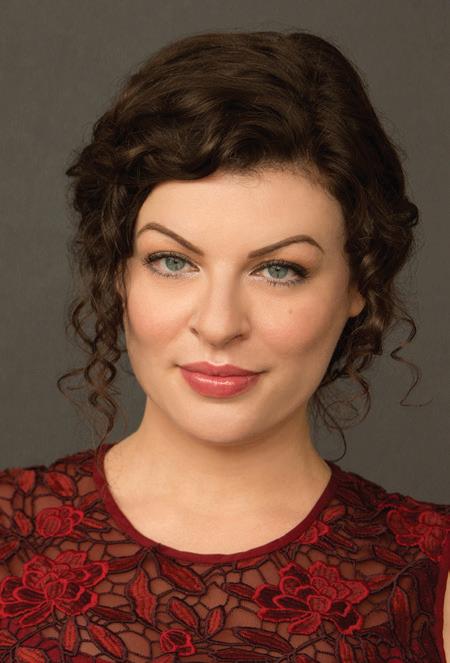
Dr. Alexander was born in Harlem in 1962 but grew up in Washington, D.C., where her father, Clifford Alexander, Jr., was United States Secretary of the Army and Equal Employment Opportunity Commission chairman. Alexander has taught at Yale (where she chaired the African American Studies Department), Smith College and the University of Chicago, and is now Wun Tsun Tam Mellon Professor in the Humanities at Columbia University, Chancellor of the Academy of American Poets, and Director of Creativity and Free Expression at the Ford Foundation. Her book of poems, American Sublime (2005), was one of three finalists for that year’s Pulitzer Prize and among the American Library Association’s “Notable Books of the Year.” In 2009, she composed and delivered Praise Song for the Day for the inauguration of President Barack Obama. Elizabeth Alexander’s best-selling memoir, The Light of the World, was released to great acclaim in 2015 and named as a finalist for both the Pulitzer Prize and the National Book Critics Circle Awards. First Lady Michelle Obama said it was her favorite book of the year.
Julia Adolphe wrote of Equinox:
Against the backdrop of the autumnal equinox, where dying bees feverishly fill the skies, Elizabeth Alexander portrays a family’s encounter with illness, death and human perseverance. Striking juxtapositions permeate the poem: life and death, venom and honey, frenzied movement and complete stillness. The equinox, one of the two days out of the year when day and night are equal in duration, captures the protagonist’s dual state of existence: understanding the frailty of the human body and the resilience of the human spirit. With highly rhythmic, contrapuntal motives juxtaposed against lyrical lines and homophonic singing, the work’s music follows the trajectory of Alexander’s poem. Harmonies swirl through Please turn page quietly
CINCINNATI MAY FESTIVAL | 35
Julia Adolphe
moments of dark richness to pale sparseness, evoking the poem’s complex exploration of human striving, patient acceptance and spiritual communion.
—Dr. Richard E. Rodda
TEXT
Equinox by Elizabeth Alexander
Now is the time of year when bees are wild and eccentric. They fly fast and in cramped loop-de-loops, dive-bomb clusters of conversants in the bright, late-September out-of-doors. I have found their dried husks in my clothes. They are dervishes because they are dying, one last sting, a warm place to squeeze a drop of venom or of honey. After the stroke we thought would be her last My grandmother came back, reared back and slapped a nurse across the face. Then she stood up, walked outside, and lay down in the snow. Two years later there is no other way to say, we are waiting. She is silent, light as an empty hive, and she is breathing.
JAMES LEE III
Breaths of Universal Longings
Born: 1975 in St. Joseph, Michigan
Work Composed: 2022
Premiere: These performances are a special presentation of this work.
Instrumentation: SATB chorus, SATB youth chorus, 2 flutes, 2 oboes, 2 clarinets, 2 bassoons (incl. contrabassoon), 4 horns, 2 trumpets, 3 trombones, tuba, timpani, bass drum, chimes, congas, crash cymbals, egg shaker, glockenspiel, suspended cymbals, tam-tam, tambour de Basque, temple blocks, tenor drum, tom-tom, triangle, wind chimes, wood block, harp, strings
Duration: approx. 28 minutes
James Lee III, born in 1975, graduated with a Doctor of Musical Arts degree from the University of Michigan in 2005. Lee’s orchestral works have been commissioned and premiered by the National Symphony, Detroit Symphony, Baltimore Symphony, Chicago Symphony, Boston Symphony, St. Louis Symphony, and the orchestras of Philadelphia, Cincinnati, Atlanta, and others. His works have been conducted by Leonard Slatkin, Marin Alsop, Michael Tilson Thomas, Juanjo Mena, and oth-

ers. In October of 2021, Amer’ican was premiered by the Detroit Symphony, and Niiji Memories, his flute concerto, was premiered by Julietta Curenton and the Columbia Orchestra. In November of 2021, the Calyx Piano Trio premiered Tones of Clay at Tanglewood, and the St. Louis Symphony performed Emotive Transformations. Other world premieres that season included Freedom’s Genuine Dawn, which was premiered by the Baltimore Symphony in January 2022. A Double Standard for Karen Slack and the Pacifica String Quartet was premiered in June of 2022 at Carnegie Hall and Shriver Hall. Premieres scheduled for the 2023–24 season include a piano concerto, an English horn concerto, and an orchestral work.
James Lee II wrote of Breaths of Universal Longings:
Breaths of Universal Longings is a work in four movements that is inspired primarily by the concepts of joy and belonging. It is a work that celebrates the power of the voice and singing. It is also about shared humanity and the universality of singing. The first movement, “From Dust We Were Made,” employs biblical texts from Genesis 2:7, and Job 38:7 in which I paraphrased the words written. The initial idea is that mankind was created from the dust of the ground, the breath of life was breathed into humanity’s nostrils, and then man (and woman) become living beings that would rise, and joyfully sing as the morning stars also sang together and all of creation shouted for joy! Movement two, “Now and Then,” was written by Charles Bertram and is a reflection on a long life lived and a comparison of the actions in one’s youth with the last years of one’s life. The following strophe from the poem illustrates the sentiments of the poet: “To life’s sun-setting years, My feet have come—Alas! And through its hopes and fears, again I shall not pass.” There are contrasting episodes of music that alternate with the unifying melodic passages on the texts “All life is built from song” and “All life is built from love.” As the work continues, the third movement, “Reflection,” utilizes texts written by members of the May Festival Youth Chorus. This movement includes texts that search for joy, singing, longing and belonging. The music from this movement was partially inspired by the aftermath of being in mandatory lockdowns and quarantines during the Covid-19 crisis of 2020 and 2021. A beautiful part of the texts used in this movement comes from the words “Into this day we must rise as a sun, out from this darkness to shine.” The last movement, “Seeking Joy,” uses texts from William Henry Davies' poem with the same name. The music here continues in a steady ascent from a thin texture of tranquility that
PROGRAM NOTES
36 | CINCINNATI MAY FESTIVAL
James Lee III
seeks to musically convey the opening words, “Joy, how I sought thee!” As the texts continue to expand on the acts of an individual searching for joy in various places and not being fulfilled, the music comes to a decisive change in course with the words “Joy, I have found thee!” Then, the music continues to bring forth passages of joy, glee, awe, and exuberance in an increasingly dense texture until the last explosive measure.
TEXT
Breaths of Universal Longings
1. From Dust We Were Made
Genesis 2:7, Job 38:7, (paraphrased by James Lee III)
Dust, from dust we were made. Inanimate, lifeless…dust that lay on the ground until day six. Then those hands appeared. Those hands took the dust, formed man, and then GOD breathed into man’s nostrils the breath of life.
A living soul was born.
Ah, those hands. They took a rib from man. A woman was formed and united with man. United bones, united flesh, unashamed. Breathe. Arise. Sing.
The morning stars also sang together, and all the children of God shouted for joy!
2. Now and Then Charles Bertram Johnson
All life is built from song
In youth’s young morn I sang; And from a top-near hill
The echo broke and rang.
The years with pinions swift
To youth’s high noon made flight, All life is built from song
I sang amid the fight. To life’s sun-setting years, My feet have come—Alas! And through its hopes and fears
Again I shall not pass.
The lusty song my youth
With high-heart ardor sang
Is but a tinkling sound— A cymbal’s empty clang. And now I sing, my Dear, With wisdom’s wiser heart, All life is built from love, And song is but a part.
3. Reflection
Texts by members of the May Festival Youth Chorus
Where is the song?
Where is our joy?
searching—longing—seeking—chasing— Calling.
Into what day will we break as dawn?
Out of this dark will we climb?
The longing of our age is an age of belonging.
Into this day we must rise as a sun, out from this darkness to shine. Here is our song— Hear this, our joy! seeing—meaning—breathing—being— Singing.
4. Seeking Joy
William Henry Davies
Joy, how I sought thee! Silver I spent and gold, On the pleasures of this world, In splendid garments clad; The wine I drank was sweet, Rich morsels I did eat— Oh, but my life was sad! Joy, how I sought thee!
Joy, I have found thee! Far from the halls of Mirth, Back to the soft green earth, Where people are not many; I find thee, Joy, in hours With clouds, and birds, and flowers— Thou dost not charge one penny. Joy, I have found thee!
ROBERT NATHANIEL DETT
Selections from The Ordering of Moses
Born: October 11, 1882, Niagara Falls, Canada
Died: October 2, 1943, Battle Creek, Michigan
Work Composed: 1932
Premiere: Premiered on May 7, 1937 at the Cincinnati May Festival, conducted by Eugene Goossens with soprano Agatha Lewis, contralto Elizabeth Wysor, tenor Frederick Jagel and baritone Alexander Kisselburgh as soloists.
Instrumentation: solo soprano, tenor, bass, SATB chorus, 2 flutes, piccolo, 2 oboes, 2 clarinets, 2 bassoons, 4 horns, 2 trumpets, 3 trombones, tuba, timpani, bass drum, castanets, chains, crash cymbals, glockenspiel, snare drum, suspended cymbals, tam-tam, tambour de Basque, tom-tom, triangle, harp, organ, strings
Duration: approx. 28 minutes
The Cincinnati May Festival of 1937 was a fitting venue for the first performance of R. Nathaniel Dett’s The Ordering of Moses. Cincinnati had been a border town for much of the preceding century, on the free side of the Ohio River across from Kentucky, where slavery was then legal, and it was a key point along the Underground Railroad that secretly transported perhaps 100,000 southern enslaved persons to freedom before Emancipation in 1863. The branch of the system of circuitous routes and safe houses leading north from Cincinnati coursed through Ohio to Oberlin, whose progressive liberal arts college had been admitting African American
Please turn page quietly
PROGRAM NOTES
CINCINNATI MAY FESTIVAL | 37
students since 1835 and women since 1837, then on to Cleveland and along Lake Erie past Buffalo to terminate just across the Niagara River in Canada, where slavery was forbidden. (The National Underground Railroad Freedom Center was opened in Cincinnati in 2004 to “teach, convene and inspire” around the city’s role in that crucial episode of American history—learn more at freedomcenter. org or visit the Freedom Center at the corner of East Freedom Way and Second Street West—and a student-designed sculpture in Oberlin's Tappan Square commemorates that city's important place in the Underground Railroad.) As many as 60,000 formerly enslaved persons established new lives in Canada in such African American enclaves as Drummondville, Ontario (incorporated into the town of Niagara Falls in 1881), and it was there that Dett’s maternal grandmother, Harriet Johnson, settled in the 1850s after leaving Washington, D.C.; it is unknown if she was enslaved or free. The Johnson family flourished in their new home. Harriet’s son graduated from law school in San Francisco and her daughter, Charlotte, was well educated, socially adept, successfully ran her own rooming house, married Robert Dett (a railroad porter born in Maryland who became a prominent member of the community), instilled a love of music and church in
her children, and was active in significant social and political causes, not least membership in the antislavery Republican Party after the family moved to the New York side of Niagara Falls in 1893. It was into this household that Robert Nathaniel Dett was born on October 11, 1882.




























































































Both of Dett’s parents sang and played piano, and Nathaniel recalled, “I just ‘picked’ it up. I played piano by ear ever since I can remember.” He was given formal lessons with a local teacher and continued his musical studies when the family moved across the river to New York State when he was 11. To pay for the lessons and to help with the family budget, he got a job as a bellboy at the tony Cataract Hotel. He was allowed to play the grand piano there when it was not otherwise in use and began to attract attention for his improvisations and renditions of popular songs. Soon he was entertaining at church and social functions around town. After being encouraged by several professional musicians who stayed at the Cataract, Dett settled on a career in music, and, in 1900, he issued his first publication, a ragtime number titled “After the Cakewalk.” In 1903, he was accepted as a student in piano and composition at Oberlin College, which was then responsible for about one-third of all African American graduates from America’s pre-











PROGRAM NOTES
vaecinci.com 513.381.3300 Ticketson sale now! SANCTUARY ROAD* by Paul Moravec & Mark Campbell APR 29 7:30PM | Jarson-Kaplan Theater “My soul neededthis.” VAE Attendee
38 | CINCINNATI MAY FESTIVAL
Featured Artists: Dashon Burton, Malcom Merriweather, Laquita Mitchell, Taylor Rave and Noah Stewart *World premiere of the chamber orchestration. Music Director Craig Hella Johnson
dominantly white institutions of higher education. Dett became the first African American to receive a degree from the Oberlin College Conservatory of Music when he graduated in 1908.
Dett immediately began a distinguished career as a teacher and choral director with appointments at traditionally African American colleges, raising the performance level of the student groups while also continuing to appear as a pianist and develop a compositional style informed equally by his formal training and his life-long immersion in spirituals and folk songs: “this wonderful store of folk materials, the melodies of enslaved people” he called them, “who poured out their longings, their griefs and their aspirations in one great, universal language.”
After serving on the faculties of Lane College in Tennessee (1908–1911) and the Lincoln Institute in Missouri (1911–1913), Dett spent the next two decades at the Hampton Institute in Virginia, where he chaired the music department, initiated the undergraduate degree program in music, founded a performance series, and established a choir that became an internationally renowned touring organization specializing in African American sacred music. In 1916, he married the pianist Helen Elise Smith, the first African American graduate of the Damrosch Institute of Musical Art (renamed the Juilliard School of Music in 1924 to honor the bequest of wealthy textile merchant Augustus D. Juilliard) and continued his own education during the following summers with advanced studies at the American Conservatory of Music in Chicago, Northwestern University, University of Pennsylvania, Columbia University and Eastman School of Music (where he earned his master’s degree in 1932), in France with Nadia Boulanger, and at Harvard, where he won the Bowdoin Literary Prize for his essay on “The Emancipation of Negro Music” and the Francis Boott Award for his choral partsong “Don’t Be Weary, Traveler.” Dett retired from the Hampton Institute in 1932 and taught privately in Rochester, NY for three years, but returned to academia when he was appointed to the faculty of Sam Houston College in Texas in 1935 and Bennett College in North Carolina in 1937. He joined the USO (United Service Organizations) in 1942, soon after the country had
entered World War II, and died of a heart attack the following year in Battle Creek, Michigan, where he had been assigned to develop a choir for the Women’s Army Corps; his remains were interred in Niagara Falls, Ontario.
The premiere of The Ordering of Moses was given on May 7, 1937 at the Cincinnati May Festival, with Eugene Goossens conducting a chorus of 350 and a quartet of distinguished oratorio and operatic soloists.
Early in his career, Dett stated that he wanted to create something for African Americans that would be “musically peculiarly their own and yet which would bear comparison with the nationalistic utterances of other people’s work in art form,” and he realized his vision with original compositions and arrangements for chorus, piano, orchestra and organ rooted in spirituals and the African American experience. His prominence in American music was attested by honorary doctorates from Oberlin College and Howard University, the Harmon Foundation Medal, the Palm and Ribbon Award from the Royal Belgian Band, and election as president of the National Association of Negro Musicians, which he helped establish in 1919 as the country’s first organization dedicated to the preservation, encouragement and advocacy of all genres of the music of African Americans. The Methodist Episcopal Church in Niagara Falls, the de facto Canadian terminus of the Underground Railroad where Dett was organist from 1898 to 1903, was named in his honor in 1983.
Dett composed The Ordering of Moses, his “Biblical Folk Scene for Soli, Chorus and Orchestra,” in 1932 as his graduation thesis from the Eastman School of Music, and continued to revise it until it was published in New York five years later. Dr. Dett, in a letter, wrote that “it cannot be said that The Ordering of Moses is the result of any sudden or immediate inspiration.” Later he confessed that the compilation of the text—which is partly biblical and partly folk lore—the composition of the music, and the orchestration occupied him for 10 years, and that the fugue, “Go Down Moses,” took four years to write. Continuing, he said:
Although the text is very free in form, and embraces a number of styles, blank verse, free verse and rhyme, still I like it; for in it the story is continuous and very understandable and absolutely fits the music.
Sometimes words and music occurred to me simultaneously, which of course, results in an
Please turn page quietly
PROGRAM NOTES
CINCINNATI MAY FESTIVAL | 39
ideal relationship. The similarity of folk text to the words of Scripture is striking and the fusion of the two seems natural; moreover, the light which is thrown subsequently on the true meaning of the spiritual is very revealing.
Dett’s oratorio, his most ambitious creative effort, was formed around iconic episodes of the biblical Exodus—the lament of the Israelites held captive in Egypt, the divine calling (“ordering”) of Moses, the parting of the Red Sea and the pursuit by the Egyptians, the rejoicing of the freed Israelites—with a text he drew from the books of Exodus and Lamentations and the words of traditional spirituals, most notably “Go Down, Moses,” whose melody recurs as a motto throughout the work. Dett assigned the chorus to represent The Children of Israel, the soprano Moses’ sister Miriam, the alto The Voice of Israel, the tenor Moses, and the baritone The Voice of God and The Word. “The Moses depicted,” Dett wrote in a preface to the score, “is not the Moses familiarized to us by the other arts, especially by the work of Michelangelo, whose statue of the patriarch has become symbolic. At the time of this ‘ordering,’ Moses was a shepherd on a hillside, undoubtedly a young man, which explains the part being assigned to a tenor voice.”
The premiere of The Ordering of Moses was given on May 7, 1937 at the Cincinnati May Festival, with Eugene Goossens conducting a chorus of 350 and a quartet of distinguished oratorio and operatic soloists: soprano Agatha Lewis, contralto Elizabeth Wysor, tenor Frederick Jagel and baritone Alexander Kisselburgh. The event was Dett’s greatest triumph. Herman J. Bernfeld of the Cincinnati Enquirer reported, “So great was the enthusiasm that the composer was brought forth not once but several times and cheered to the echo, the audience arising as one to show its pleasure in the presentation of Dett’s composition.” Performances in New York City; Chicago; Washington, D.C.; White Plains, New York; and Stockton, California followed the premiere, but interest in The Ordering of Moses waned following the composer’s death. The May Festival revived the work in 1956 under the direction of Thor Johnson with soloists Leontyne
Price, William Warfield, Carol Brice and Luther Saxon, and Alabama’s Talladega College Choir performed it in 1967 in observance of the school’s centenary. The Talladega performance was recorded and issued privately, but it wasn't until the May Festival's recording in 2014 that the oratorio was recorded commercially by professional forces.
The premiere of The Ordering of Moses in Cincinnati drew national attention. Olin Downes wrote in The New York Times, “Mr. Dett had reason to congratulate himself upon the effect of his music…. The concert closed, as he bowed from the stage, with an ovation in his honor.” The performance was also broadcast nationwide on NBC’s Blue Network…or at least most of it was. NBC had originally scheduled a full hour for the transmission, sufficient to air the entire composition, but the live feed was abruptly cut off after 45 minutes and the remaining time filled with recorded organ music. In their comments on a transcription of the broadcast in the remarkable collection of rare mid-20th-century recordings assembled by producer Edward J. Smith (EJS: Discography of the Edwin J. Smith Recordings), William Shaman, William J. Collins and Calvin M. Goodwin speculated that the truncated broadcast was “a concession to objections tendered by telephone to the network, The Ordering of Moses having been possibly the first network broadcast of a major work by a black composer.” Perhaps it was a sign of the quickly evolving social situation at that time, but six months later Dett was commissioned by the Columbia Broadcasting Corporation, along with five other prominent American composers, to write an orchestral piece for broadcast over the CBS network; Howard Barlow led the Columbia Symphony in the premiere of Dett’s (complete) American Sampler on October 2, 1938.
Organist and choral conductor J. Harrison Wilson concluded his 1970 University of Southern California doctoral dissertation on The Ordering of Moses with these thoughts: “Through this composition R. Nathaniel Dett contributed to American musical literature a work that must be considered a landmark in oratorio composition. If Dett wrote no other works, this one should assure him a place in this country’s musical history.”
—Dr. Richard E. Rodda
PROGRAM NOTES
“If Dett wrote no other works, this one should assure him a place in this country’s musical history.”
40 | CINCINNATI MAY FESTIVAL
—J. Harrison Wilson
TEXT: THE ORDERING OF MOSES
Text based on scripture and folklore
The Word
All Israel’s children sorely sighed, Chorus
By reason of their bondage—
The Word
And unto God they sorely cried,
Chorus
By reason of their bondage—
The Word
All Israel’s children sighed— And unto God they cried— ’Neath Egypt’s king they hard were tried—
Chorus
By reason of their bondage.
Chorus
And from a burning bush, flaming, God spake unto Moses saying—
Go down, Moses, Way down in Egypt’s land; Tell Pharaoh
Let my people go!
Thou shalt lead thy people
To the promised land.
Go down, take thy rod in thy hand
Thou shalt lead thy people
To the promised land.
Moses
Lord!
Who am I to go unto Pharaoh, And why should I lead the children of Israel! How shall they know Thou sendest me?
What name shall I say unto them?
What signs or wonders show?
I am not eloquent; Have no gift of speech; Am slow of tongue.
Chorus
And God spake unto Moses, Spake unto Moses saying—
The Voice of God
Who hath made a man dumb, Or who hath made his mouth speak?
Is it not I, Jehovah?
God of your fathers?
Now therefore, go, And I will be thy mouth. I will instruct thee
What thou shalt say!
Go down, Moses—
Chorus
Go down, Moses, Way down in Egypt’s land. Tell Pharaoh
Let my people go!
Thou shalt lead thy people To the promised land, I’ve looked on Israel, And I have respect unto her.
MEDITATION OF MOSES
The Word
And when they reached the other shore— O glory, hallelujah—
They sang a song of triumph o’er.
O glory, hallelujah!
Moses
I will praise Jehovah, For he hath triumphed gloriously; The horse and his rider
He has o’er thrown in the midst of the sea!
Chorus
Hallelujah, hallelujah, Let us praise Jehovah.
The Word
Then did the women of Israel Gather with timbrels and dances; And Miriam, gifted with prophecy, Answered exhorting them, saying—
Miriam
Come, let us praise Jehovah, For His triumph is glorious; The clouds and fire are his chariots, The winds and waves obey Him. Now all the armies of Pharaoh Are sunk as stones in deep waters. The deeps stood up as the mountains, When Thou didst blow Thy breath upon them.
The Women
Hallelujah, hallelujah!
Moses Sing ye to Jehovah, For He hath triumphed gloriously.
Chorus
Thy right hand, O Lord, Is become glorious in power: Pharaoh’s hosts thou hast cast In the depths of the sea!
Moses Sing ye
Praise to Jehovah, Sing ye.
Chorus
He is King of kings; He is Lord of lords. Sing together, praise Jehovah, Great God of our fathers. God, the great I Am That I Am; Hallelujah, He is a Man of War. Mighty is Jehovah, Mighty in battle; No god doth wonders like Him. Please turn page quietly
PROGRAM NOTES CINCINNATI MAY FESTIVAL | 41
Praise the Lord. Sing to Jehovah, Whose right hand is our salvation.
Moses
O praise ye, Praise Jehovah, Praise His holy name!
Miriam
O praise ye, Praise ye Jehovah, Praise His holy name!
Chorus
He is King of kings, He is Lord of lords. Sing together, praise Jehovah, Great God of our fathers. God, the Great I Am That I Am, Hallelujah, He is a Man of War. Mighty is Jehovah, Mighty in battle— No god doth wonders like Him, Praise the Lord, Sing to Jehovah, Whose right hand is our salvation. O praise the Lord!
Moses I will sing unto Jehovah, For He hath triumphed gloriously.
Miriam
The horse and his rider He hath thrown into the sea!
Moses
Jehovah is my strength and my song!
Miriam And He hath become my salvation!
Moses This is my God, and I will praise Him!
Miriam My father's God, and I will exalt Him.
Moses Thou, Lord, in Thy loving kindness Hast led the people, whom Thou hast redeemed!
Miriam and Moses
Jehovah shall reign forever and ever!
PROGRAM NOTES 42 | CINCINNATI MAY FESTIVAL
CINCINNATI MUSICAL FESTIVAL ASSOCIATION
BOARD OF DIRECTORS
Officers
Christy Horan, Chair
Mike Curran, Vice-Chair
Anthony Lazzeri, Treasurer
Mary Stucky, Secretary
Eric Combs, Immediate Past Chair
Directors
Helene Bentley
David Boyles
William Henry Caldwell
Chris Canarie
Melanie M. Chavez
Teresa F. Ernst, PharmD
Barbara Feldmann
Mary Monahan Gimpel
J. Mark Holcomb
Dr. David A. Huelsman
Isaiah Hyman, Jr.
Thomas Kirkpatrick
Robert K. Lomax
Rene McPhedran
Patricia Misrach
Manisha Patel, MD
Kathleen Rambo
Ruthann Sammarco
Eileen Stanisic
Kelly Willbrandt
Jeannine Winkelmann
Shelby O. Wood
Directors Emeriti
Susan S. Laffoon
Geraldine B. Warner
Honorary Director
Steven Monder
Advisory Committee
(Past Chairs)
Rhoda A. Brooks
Melanie M. Chavez
Eric K. Combs
Nancy Heffner Donovan
Kelley J. Downing
Gregory L. Ebel
Jerold A. Fink
J. Mark Holcomb
Susan S. Laffoon
Sherie Lynch Marek
Charles S. Mechem
Thomas L. Neyer, Jr.
Charles Powers
Carole Tyler Rigaud
J. Shane Starkey
Robert E. Stautberg
Timothy E. Stautberg
Gust Totlis
Ronald H. Yocum
Cincinnati Musical Festival Association Mission, Vision and Values
MISSION We exist to engage, energize and connect our community with the highest quality performances of great choral music.
VISION We are the most exciting force in the choral world. We are a leader and catalyst in the production, presentation and promotion of choral activities in our region and around the globe.
VALUES We believe in fostering choral music of the highest artistic standards; preserving the history, enhancing the present and embracing the future of choral music; cultivating diverse audiences, choirs and singers who are passionate about choral music; operating in a financially sound manner.

CINCINNATI MAY FESTIVAL | 43
May Festival Chorus and the Cincinnati Symphony Orchestra with the cast of Bernstein’s Candide conducted by Katharina Wincor, May Festival 2022. Credit: Tyler Secor

44 | CINCINNATI MAY FESTIVAL

Cincinnati Magazine helps you get to know our city a little better →
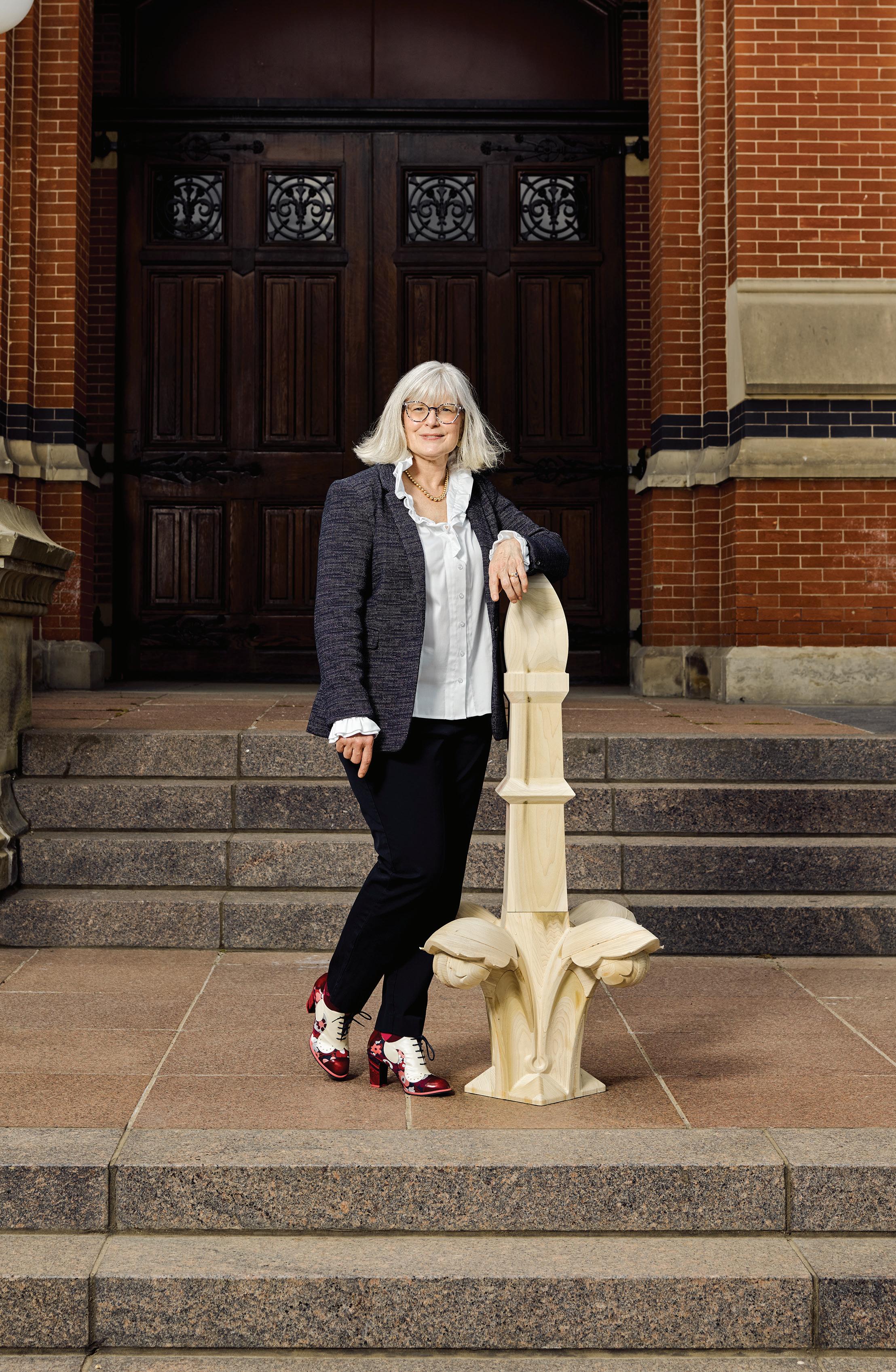
FEATURE 46 | CINCINNATI MAY FESTIVAL
Music Hall’s Guardian Angel
When Thea Tjepkema talks (and researches, writes, lectures, leads tours, and generally enthuses) about Cincinnati’s temple of arts and culture, everyone listens.
BY POLK LAFFOON IV | PHOTOGRAPH BY AARON M. CONWAY
CINCINNATI MAY FESTIVAL | 47
TTHEA TJEPKEMA KNOWS MORE about Cincinnati Music Hall—its architecture, its history, its past performers, its recent renovation, and its status as a National Historic Landmark—than anyone on the planet. She calls it “my obsession.”
She writes about it, lectures about it, gives tours of both its interior and exterior, and, through her Friends of Music Hall (FMH) board position, pushes hard to see that the restoration so well begun in 2016 doesn’t stop. She recently oversaw the restoration of 10 missing sandstone finials atop every exterior gable and repairing the outsized lyre below the rose window approximately a century after they last appeared without damage.
Thea can tell you that the bricks on the west side of Music Hall along Central Parkway are orange common brick because the architect, Samuel Hannaford, wanted them to glow in the sunset. Bricks on the east side, by contrast, are cherry red and pressed in Philadelphia, which is why we think of the building as red brick. How many bricks in all? About 4 million, she says, lugged by hod carriers, mostly Irish.
Inside, she will remind you, the building’s second-floor ballroom, first known as the Greystone, opened in 1928 and was America’s largest dance floor for a time. Nine years later, catering to the nation’s big band
craze, it became the Topper Ballroom, the name it carried until 1993.

Encouraged by her husband, Cincinnati Pops Conductor John Morris Russell, to find out which singers or musicians have performed in Music Hall, in the ballroom, or on the main stage, Thea has developed long lists with specific dates. One of them, reflecting her particular interest in the Hall’s African American heritage, includes Billie Holiday, Louis Armstrong, Duke Ellington, Sarah Vaughan, Don Shirley, and Ella Fitzgerald as well as Marian Anderson, Sissieretta Jones, Mamie Smith, and Sister Rosetta Tharpe.
Tjepkema’s and Russell’s initial arrival here in the 1990s piqued Thea’s interest in her husband’s workplace venue, and after moving to Canada and returning again to Cincinnati, she joined the board of the Society for the Preservation of Music Hall, recently renamed the Friends of Music Hall. The city,
which owns the building, established the Music Hall Revitalization Corporation in 2010 to finally kick-start a multi-year restoration project.
With a BFA in historic preservation from the Savannah College of Art and Design and a master’s in arts administration from the University of Akron, plus a background curating at the Owens-Thomas House and Slave Quarters Museum in Savannah, Thea came to Cincinnati with solid preparatory credentials. “She takes John’s passion for the Pops and directs it to the building,” says Ed Rider, a fellow archivist who serves with her on the FMH board. “They’re a great team for promoting Cincinnati music and Music Hall.”
Paul Muller, past president of the Cincinnati Preservation Association, agrees. “Thea is one of the most rigorous researchers I’ve come across,” he says. “If you can’t justify a date, she won’t pretend it’s out there. She sees life and joy in historical

FEATURE 48 | CINCINNATI MAY FESTIVAL
PHOTOGRAPH BY JOANNE GRUETER
facts and shares them with others. I’ve gained appreciation for historical aspects of Music Hall I wouldn’t have otherwise because Thea opened it up for me.”
HER FULL NAME IS THEA
Tjepkema (TAY-uh CHEP-ke-muh), but because pronunciation of her last name can be difficult to discern, she’s known across Cincinnati simply as Thea. Her speaking style is informal, and she has a friendly face bracketed by a striking mane of silver-gray hair. She wears glasses with translucent frames, smiles frequently, and sometimes lapses into a laugh over something she’s said.
Two high-profile lectures—one to the Cincinnati Preservation Association’s fall forum on “Muses: The Women of Music Hall” and the other at the Cincinnati & Hamilton
County Public Library called “Under One Roof: The African American Experience in Music Hall”—showcased her accessibility, echoed by substantial positive feedback. Each lasted a good hour and chronicled in considerable detail the many women and African Americans who have had outsized impact on Music Hall, either by performing in it or playing a role in shaping it.
Thea recalled for her first library audience, for example, that at the formal opening of Music Hall in 1878, building chairman Julius Dexter praised Reuben Springer and his peers who had contributed funds, then said, “Others may have given as much; possibly in proportion to their means, more.… Who may say the contribution of the colored barber is not equal in liberality with any $1,000, or even larger sum, given?”
But who was that barber? Did he really exist? Over a period of six years, countless hours of digging,
and help from a library friend, Thea found an old newspaper article about the city’s Black barbers. She matched it to a list of Music Hall’s original contributors and, sure enough, there was the name of Fountain Lewis with his contribution of $20 noted (about $500 in today’s money). She also found a quote from Lewis made some 20 years later about his gift: “And you can depend on it, I’m mighty proud of that fact now.” Digging further, she learned that Lewis and his peers earned most of their livelihoods cutting the hair of white men. One of his clients was Reuben Springer.
“Thea’s research is incredibly thorough,” says fellow FMH board member Joanne Grueter. “During the restoration of Music Hall, she uncovered photographs of the original tracery patterns in the windows reclaimed during work in Corbett Tower. She worked with EverGreene Architectural Arts to replicate the

CINCINNATI MAY FESTIVAL | 49
ATTENTION TO DETAIL Thea Tjepkema examines the metal finial in front of Music Hall’s rose window. (Previous spread) Tjepkema, photographed with a replacement finial model (made by Arya Design in Cincinnati), on April 19, 2021.
stenciling and colors in the Tower. The black bricks, an important design detail intended by Hannaford, were her discovery. And we now have those back on Music Hall’s facade.”
Thea reads everything she can find about Music Hall, causing her to become intimately familiar over the years with the Cincinnati & Hamilton County Public Library, the History Library at Union Terminal, the Cincinnati Symphony Orchestra and Society for the Preservation of Music Hall’s archives, the Ohio Memory Collection in Columbus, the Kenton County Public Library in Northern Kentucky, the University of Cincinnati’s rare book archives, and the Library of Congress. Tips from fellow Cincinnatians, she says, also have
master’s degree in education with a focus on chemistry and was an early feminist—suggested she become a Candy Striper at a local retirement home. There she befriended a resident named Alex, who, while they played checkers, liked to talk about early times in Gainesville, the buildings that had been there, the houses and stores, and the horses and buggies. Sometimes he’d ask Thea if such and such a building were still standing, so she began to look. And she realized, she says, “that buildings had stories and, taken together, can tell the history of a community.”
Not too many years later, she spent a year in the Netherlands, “where I saw really old buildings,” she says, including a windmill owned by the Tjepkema family. By the time she returned, she knew she loved art and
birthplace of Juliette Gordon Low, founder of the Girl Scouts. She left Savannah to become a museum technician at Yosemite National Park, where she catalogued historic photographs, many of them of Theodore Roosevelt. “I hiked a lot,” she says. “I’m an outdoor person. But I decided I wanted to get a master’s in arts administration and manage a house museum.”
Only a handful of schools offered the kind of arts administration program she was looking for, including the University of Akron, where she received a full scholarship and an assistantship to the director of art galleries. “I drove from Yosemite to Akron, Ohio, and I cried, What have I done? But it was a great program. I loved it.”
Returning to Savannah upon graduation, Thea was hired to work at the Owens-Thomas House, and after just a few weeks, she says, she “began bumping into” John Morris Russell, associate conductor of the Savannah Symphony Orchestra. Finding herself at an event where he was speaking about the orchestra, she soon found herself thinking, I could marry that guy. He’s such a dynamic speaker!
been of immense help.
Judy Williams, a Columbus-based consultant on historic preservation, calls Thea a research detective. “Because of her enthusiasm, her training, her deep love of history, and her personal connection to the building, I felt when I was working with her that her information was wonderful, behindthe scenes material that people wouldn’t know,” says Williams. “Sometimes, working with volunteers, you’re not so sure.”
historic architecture but didn’t know what she was going to do about it. At the Savannah College of Art and Design she tried a course in architecture but says she didn’t feel welcome with so many men crowding the classroom.
BORN IN
NORTHERN MICHIGAN
of Dutch descent, Thea moved to Gainesville, Georgia, when she was 2 so that her father, a poultry manager, could work in what was then “the poultry capital of the world.” When she was 15 and looking for volunteer work, her mother—who held a
She thought about painting and graphic design, but nothing seemed quite right until, by chance, she met a professor who taught an introduction to historic preservation. Persuading her to give it a try, he introduced her to her life’s work. “I signed up, and I quickly knew it was exactly what I wanted to do,” she says. “I looked at the old newspapers on microfiche, I learned how Sanborn Insurance maps documented buildings, and I discovered how to find things using city directories.”
Thea’s first jobs out of college were at house museums in Savannah: the Telfair Museum, the Owens-Thomas House, and the
“Somewhere along the way, John heard me say that I’d just moved back from Akron, and it turned out that he’d been the assistant conductor of the Akron Symphony,” she says. “Like we were following each other around. He said to me, You had classes in Guzzetta Hall. We dated for a year or so in Savannah.”
Russell auditioned with the Cincinnati Symphony in 1995, and Thea enthusiastically accompanied him north for a look around. During her summer between semesters in graduate school, she had worked at the William Howard Taft National Historic Site in Mt. Auburn, and from that experience had developed strong positive feelings for Cincinnati. Russell got the job, working under Erich Kunzel for the Pops and Jesús López-Cobos for the Cincinnati Symphony Orchestra, and a year later, officially married, they moved here.
Thea’s first impression of Music
FEATURE 50 | CINCINNATI MAY FESTIVAL
AS FINAL EXTERIOR DETAILS ARE RESTORED, MUSIC HALL WILL COME CLOSE TO THE ALMOST FANTASTICAL APPARITION ITS FOUNDERS IMAGINED IN 1878: A WELCOMING TEMPLE OF THE ARTS AND EXPOSITIONS.
Hall was “amazement at the sheer scale,” she says. She started reading about its history and did what she could to support Russell, who was trying to diversify his audiences by reaching out to local Black churches. As background, she began researching African American involvement in the building, first the boxers— Ezzard Charles was one of the earliest to fight there—and then the basketball players, the bands in the Greystone Ballroom, and the musical performers.
She thought she was on to something, a story that Cincinnati didn’t tell very well. “I said to myself, This is a small history of America going on right here,” she says. “It was amazing how many bands wanted to play here, hoping to make it to Harlem, partly on the strength of the WLW radio signal, or WSAI or WNKY. You wanted to come to Cincinnati to get on the radio.”
Thea became passionate about Music Hall’s history and future possibilities, but she was also busy with two children, both now in college. Once they were up and out and she could devote more time to Music Hall, she began developing tours on her own, pointing to places of interest on the facade and sharing interesting historical facts. By 2015, she caught the attention of Peter Koenig, current president of the Friends of Music Hall, and Don Siekmann, president of what was then still the Society for the Preservation of Music Hall, and they insisted she join them. Not long afterwards, she was on the architecture and planning committee, displaying photographs she’d unearthed from the distant past, asking, Can we do this? Can we do that? Preservation is our middle name!
Soon enough, when Thea spoke in those board meetings, others listened. She had a presence that, in a comfortable way, radiated authority; she had a vision, and documentation to back it up. “She is a dynamo and a whirling dervish,” says Koenig.
In a May 2016 memo sent to others on the board to make her case for re-creating the original look of Corbett Tower, the no-nonsense specif-
ics of her vision become clear: “Talk to architects about exposing as much of the cove ceiling, stenciling, and original room shape as possible (46 feet wide by 112 feet long by 30 feet high); talk to the lighting crew and make sure of specs and needs; paint analysis: date our stenciling to decide the target restoration date; paint analysis for the walls, so that they are the same date to match the stenciling; most likely the cove trim and crown molding and plaster cove will need repair; hire a restorationist for the stenciling preservation and restoration. Thea.”
Today, the renovated Music Hall is a case study in what taste and money, along with a reverence for the past and confidence in the future, can accomplish. Anyone who knew the old building—with its sandblasted outer skin, tawdry marquee, and bricked-up windows— can rightfully marvel at what stands there now, a monument to the High Victorian Gothic aesthetic, polished and programmed for contemporary needs.
Thea, it seems fair to say, is primarily responsible for much of that new look. She discovered the black bricks on the Elm Street front and Central Parkway back that were integral to Hannaford’s original concept. Having read numerous articles about them, she learned that Hannaford had seen the pattern on a trip to England. She pored over old photos and concluded that he’d wanted this intentionally bold pattern so that people could see the building through the smog of the era.
She recognized that beneath the hall’s sandblasted brick exterior, lost through the decades, a pattern of black bricks had indeed been essential to the way Music Hall first looked in 1878. She wondered if the design team could replicate those bricks during the renovation. The Society for the Preservation of Music Hall had money—not limitless funds, by a long shot, but enough to satisfy the request. The board eventually agreed that the black brick detail would make a critical difference and agreed to bear the extra cost.
Thea also lobbied for the trac-
ery in the three windows below the all-important rose window on Music Hall’s front facade. They’d been covered over in brick for decades, hiding a dropped ceiling in Corbett Tower containing heat and air conditioning. Now they were going to be opened, and that alone was a giant step forward by altering and improving what visitors see as they approach the building. But Thea knew that the Victorians would not have left those windows as simple glass panes; they were all about flowers and ornamentation. They had demanded a tracery design to complement the rose window pattern in the 1870s, and so would she. Again, there was cost. Again, SPMH was able to underwrite it. Again, the board agreed.
And, finally, Thea investigated the exterior lyre sculpture and 10 sandstone finials, each a decorative element at the peaks of the gables. In their original form, the finials referenced the leaves of a plant, leading to a geometric interpretation of a flower with an acorn on the top. Like so much else, they were critical to the building’s design but eroded by time.
Thea found dozens of historic photographs to help her make the case to restore them. Once more, she brought the board along, and it’s happening. She will now go to work encouraging the Friends of Music Hall to restore the missing metal ornamentation, almost like lace, that once upon a time ran the length of the rooflines.
With those eventually in place as well, the appearance of Music Hall will come close to the almost fantastical apparition its founders imagined 143 years ago: a joyful, welcoming temple of the musical arts and expositions, filling all who approach it with anticipation.
“Music Hall feels like a sanctuary,” Thea says. When you see it through her eyes, “with the rose window and the three other windows below it, and the light pouring in through them to Corbett Tower,” you know what she means. And you want her to keep fighting for it.
CINCINNATI MAY FESTIVAL | 51

PHOTOGRAPHS BY MARLENE ROUNDS ICONIC EATS our iconic 10 Cincinnati Dishes We Love FOOD STYLING BY KATY DOENCH PROP STYLING BY EMILY CESTONE
Chili on spaghetti? Barbecue ribs? Steaks?
These mainstay classic Cincinnati eateries serve up some of our city’s most beloved dishes.
LaRosa’s Pizza
Buddy LaRosa is the son of Italian immigrants who witnessed how much people loved his Aunt Dena’s pizza recipe at church festivals, so he and some friends took a chance in 1954 and opened their own pizzeria on the West Side. When his friends left the business, he renamed it LaRosa’s. While maintaining a family-friendly tradition—along with the original recipe—LaRosa and his own sons, Mike and Mark, have embraced consumers’ new dining and ordering habits by introducing dairy-free cheese and plant-based pepperoni options, regionally-sourced greens, and drive-through pickup windows. • Multiple locations, larosas. com
Izzy’s Reuben ..............
Known for its superior cuts of meat, Izzy’s has been in the deli business for more than 120 years. And nothing on the menu is more well-known than the restaurant’s “world’s greatest” Reuben. Stacked high with Izzy’s famous corned beef, the sandwich comes with sauerkraut, Izzy’s special dressing (a rich Thousand Island-ish flavor), and melted imported Swiss cheese, served on rye bread. If you need an extra dose of corned beef, order a “Reubenator,” the double decker version of the classic. One bite and Izzy’s guarantees that you’ll be back. •Multiple locations, izzys.com

Celebrity Dish Aftab Pureval, Cincinnati Mayor
Shio Ramen, Kiki
College Hill
“My favorite food right now in Cincinnati, which I think is unique, is the Shio ramen at Kiki in College Hill. We Cincinnatians are well known for our love of noodles, and this is a dish that is reflective of a new classic that builds on the traditional love of Cincinnatians and is reflective of the growth, the diversity, and what’s next in our city. My wife and I found Kiki and specifically their ramen a couple years ago, and we really fell in love with it. It’s one of our favorite date night spots, we’ll go there pretty regularly, either just as a couple or with friends. It’s a great atmosphere there in College Hill. That is really reflective of the energy and dynamism that’s going on in Cincinnati.”
Skyline Chili
To many of us, Skyline and “Cincinnati chili” are synonymous. Visitors, ex-pats, and Cincinnati celebrities on national TV will all say, Let’s get some Skyline! when referring to the local delicacy. It’s easy to understand why, given its outsized presence downtown, at sports stadiums, and in numerous neighborhood business districts. And yet you can still harken back to the juggernaut’s early days by visiting the old-school Clifton parlor. • Multiple locations, skylinechili.com
Frisch’s Big Boy



Tartar sauce on a hamburger? Don’t make that face. You shouldn’t knock it until you try it. According to some diehard Frisch’s fans, it’s exactly what makes Frisch’s Big Boy worthy of icon status. This quarter pound of beef is divvied up into two patties, layered with cheese, lettuce, and pickles, served on a double decker bun, and slathered with that tangy sauce. It’s so popular that when NRD Capital purchased the chain in 2015, the owner almost immediately announced that the burger was staying on the menu to assuage fans’ fears. Now that’s iconic.
•Multiple locations

Greyhound Tavern Chicken
A century ago, the Dixie Tea Room served ice cream to streetcar travelers at the very end of the line in suburban Northern Kentucky.
Today’s hungry travelers are greeted with a more substantial menu, including two house specialties that rightfully belong in any local food hall of fame. First, the onion rings. Huge, sweet Spanish onions, hand-sliced and hand-battered, are deep-fried golden brown, the platonic ideal of onion rings. Follow that with fried chicken. While it’s on the menu every day, on Monday and Tuesday, the moist, perfectly breaded half chicken is served family style, with bottomless bowls of mashed potatoes, gravy, coleslaw, green beans, and biscuits. It’s true home cooking.
•2500 Dixie Hwy., Ft. Mitchell, (859) 331-3767
Gold Star Chili
This titan of Cincinnati’s chili scene, like most others, built its business on family recipes from the founders’ Mediterranean homeland. The Daoud brothers came from Jordan, however, not Greece, and their chili has a spicier, meatier flavor profile when compared to the Skyline approach. The four brothers bought a restaurant in Mt. Washington, Hamburger Heaven, in 1964 and changed its name to Gold Star the following year. Today, their sons run the company, which has 70 company-owned and franchise locations in Ohio, Kentucky, and Indiana offering a varied menu of chili and sandwiches, including (of course) hamburgers. • Multiple locations

CINCINNATI MAY FESTIVAL | 53
Zip’s Burger

Last summer, Zip’s Café was ranked the best burger in Ohio by Food & Wine magazine. Be they amateur or professional, the East Side joint consistently makes nearly everyone’s “best burger” list. It’s deceptively simple (onion, pickle, tomato, lettuce, and mayo on a Klosterman bun) so we chalk its popularity up to the chuck—the burgers, seasoned and hand-formed into patties, are made fresh with ground chuck from Avril-Bleh. Jazz it up with your choice of condiments but you won’t need much; just let that flame-broiled goodness shine through. • 1036 Delta Ave., Mt. Lookout, (513) 871-9876
Jeff Ruby Steaks
Almost from the moment it opened in 1981, The Precinct became known as the best steakhouse in town, delivering prime aged beef to diners hoping for a side of sports hero stardust. New Jersey transplant Jeff Ruby started his local hospitality career managing Holiday Inns and overseeing iconic night-
Greyhound

clubs, including Lucy’s, before he made the jump to his own spot in a 1901 former police station on Columbia Parkway. Over four decades, the sports heroes have changed (all hail Joe Burrow), but the steaks have stayed spectacular. Ruby’s daughter Britney Ruby Miller is now CEO, overseeing the company’s seven restaurants across three states.
•Multiple locations



Taco Casa Mexican Food

Polly Laffoon is sometimes credited with introducing Tex/Mex to Cincinnati when she opened Taco Casa in 1968, and the devoted fans of Taco Casa’s particular brand of Americanized “Mexican” food would likely agree. There’s nothing authentic about much of the menu. The taco salad here is iceberg lettuce, seasoned ground beef, onions, tomatoes, pinto beans, ranch dressing, and cheese. Not even a tortilla bowl for novelty. Then there’s the tuna boat: Tuna salad, wrapped in a tortilla, warmed, topped with cheese and buttermilk ranch dressing, plus diced onion and jalapenos on top. It’s an only-in-Cincin-
nati institution. •4600 Smith Rd., Norwood, (513) 827-9440 • 10798 Montgomery Rd., Montgomery, (513) 891-8333


Montgomery Inn Ribs
In 1951, Ted Gregory and his wife Matula purchased McCabe’s Inn, where he’d been working, and renamed it for its suburban home. Gregory would eventually become known as Cincinnati’s Rib King, thanks to Matula’s barbecue recipe and homemade sauce as well as to the movie stars, pro athletes, and U.S. presidents who stopped by for a bite. The family’s Boathouse on the Ohio River has a higher profile these days, and fans across the country can have ribs, chicken, and desserts shipped to them. But you owe it to yourself to lounge at the old inn with a bowl of warm Saratoga chips and sweet barbecue dipping sauce and let the world drift by.


• 925 Riverside Dr., East End, (513) 721-7427

ICONIC EATS
Five-Way Chili Spaghetti
1 No matter where you go, spaghetti is the bedrock of this quintessential Queen City meal.
2 A generous ladleful of Cincinnati chili goes next, made
Sum of Its Parts
What makes an icon? Take a closer look at the ingredients of two classic Cincinnati dishes.
with a special blend of cinnamon, cocoa, and other spices depending on your preferred chili parlor.
3 Beans offer a hearty boost to the five-way, whether they’re kidney or black-beans-and-rice mix at Skyline, red beans at Gold Star, or red kidney beans at
Empress.
4 Diced onions add a bit of freshness.
5 A heaping mound of shredded cheese completes any fiveway, but you can go the extra mile with oyster crackers, 6 fried jalapeño caps at Blue Ash Chili, or fresh chopped garlic at Dixie Chili.
LaRosa’s Buddy Deluxe
1 It all starts with the crust: your choice of traditional thin, hand tossed, or deep dish pan.
2 The family chain has used Aunt Dena’s pizza sauce recipe for
nearly 70 years.
3 Pepperoni always goes under the cheese on a LaRosa’s pie to give it more flavor from the sweet and savory sauce during the bake. Buddy LaRosa has been doing it that way since 1954.
4 Speaking of cheese, LaRosa’s uses 40 tons of fresh pro-

volone each week—or 1,920 tons annually. It seems like a lot until you figure LaRosa’s serves more than 7 million pizzas a year.






5 This pie piles up some serious Italian meats with capocollo ham and sausage.
6 Zesty banana peppers add a tangy kick to this deluxe pie.
1 2 3 4 5 6 1 2 3 4 5 6
ILLUSTRATIONS BY KELSEY COBURN CINCINNATI MAY FESTIVAL | 55
Bourbon Country Seven great spots to sip Kentucky’s signature spirit

Dean’s Hops & Vines
This no-frills neighborhood dive on Cincinnati’s west side is a popular hangout for game days and mid-week kickbacks. Known for its killer beer menu—would you expect anything less from a bar with a giant “We Want Beer” photo on the back wall?—Dean’s also has quite the collection of whiskey (we counted more than 80; the official roster is more than 150). Pull up a barstool to order a shot of Boone County, Jack Daniels 150, Old Elk Rye, Angel’s Envy, or your favorite bourbon to go with your High Life. Enjoy that glass of Kentucky gold at a high top or out on the patio. 3722 Harrison Ave., Cheviot, (513) 515-3215, facebook. com/deanshv
Revival Vintage Bottle Shop
It may look like an extremely small liquor shop with a wee bar in the corner, but Revival Vintage Bottle Shop is really a time machine. The inventory is vintage—these are the dusty bottles from the back of grandpa’s liquor cabinet, like a 1955 bottle of J.W. Dant or a 1971 flask of Evan Williams. Brad Bonds finds and sells these bottles; he also lets you try some. There’s a rotating selection of tasters, ranging from $5 a half ounce up to $25. It’s not all bourbon, either—we saw vintage rum and even banana liqueur when we visited. 5 E. Eighth St., Covington, (859) 479-2676, revivalky.com
The Monkey Bar
Back in the 1970s, Train Stop Inn owner Ken Harris kept a chimpanzee named Sam that drank beer and smoked cigarettes, and the place got nicknamed “The Monkey Bar.” Sam’s long gone now, but the name remains. In the summer months, the huge patio along the Little Miami River and the Loveland Bike Trail–adjacent location make this a popular hangout for locals and trail riders. When the weather turns chilly, it’s time to head downstairs to the bourbon room. The large bar features leather-backed stools, two stone fireplaces, and a wide selection of Kentucky’s finest. 7837 Old 3C Hwy., Maineville, (513) 781-4246, themonkeybarandgrille.com
Billy Yanks
The name honors the iconic bronze statue of a Union soldier keeping watch over the Hamilton skyline atop the Soldiers, Sailors, & Pioneers Monument, but you won’t drink like a Union soldier at Billy Yanks. The bourbon bar and restaurant inside the historic Hammerle building boasts dozens of whiskies, beers, and spirits to try. If the march north to Hamilton worked up your appetite, Billy Yanks also serves a fiery Victory at Nashville chicken sandwich and a Big Kahuna burger that puts the patty from Pulp Fiction to shame. Both pair well with Grippo’s-crusted mac and cheese.
205 Main St., Hamilton, (513) 844-0130, billyyanks.com
The Purple Poulet
In 1947, The Green Derby opened at the corner of Ninth and York in Newport, serving generations of diners before it closed in 2018. In February, a new color took over when The Purple Poulet moved from Dayton to this fully revamped space. A small, six-stool bar topped with purple-flecked granite sits on one side of the main dining room, the gateway to a swell collection of bourbon, including some vintage bottles. Easygoing prices make this a worthwhile visit. And if you’re hungry, the popular fried chicken or one of the other Southern specialties will fix you right up. 846 York St., Newport, (859) 916-5602, purplepoulet.com
Oscar Station
As you would expect from a bourbon bar located in the OG Jungle Jim’s International Market complex in Fairfield, it’s hard to beat the selection at Oscar Station, just beyond the aisles of global eats. If you can’t decide from the list of nearly 160 bourbons from Ezra Brooks to Pappy 15 Year try a handcrafted creation from the ever-rotating cocktail menu. If you’re looking to relax the old-fashioned way, you can kick back in the smoke-friendly cigar room with your glass. Bring some friends and make it a party—the Oscar Station and Oscar Event Center can be booked for your next bourbon-filled get-together. Thursdays 4–10 pm, 8771 N. Gilmore Rd., Fairfield, (513) 674-6055, junglejims.com
Smoke Justis
Walk all the way through the large, high-ceilinged dining room and you’ll come to the Smoke Justis Bourbon Lounge, where a large bar surrounds towering shelves stocked with bottles—bartenders use library ladders to access the upper reaches of the collection. This is a swanky space (you’re inside the historic Citizens Telephone Company headquarters) with real presence, but it’s far from pretentious. Newbies and aficionados alike can enjoy the spirits at weekly Wednesday bourbon socials. Pro tip: Ask for a pour based on what you like and your price point, and you might just discover a new favorite. 302 Court St., Covington, (859) 8148858, smokejustis.com
56 | CINCINNATI MAY
FESTIVAL
GUIDE
PHOTOGRAPH BY CATIE VIOX
TO BOURBON

CINCINNATI MAY FESTIVAL | 57 PHOTOGRAPH BY MARLENE ROUNDS
WHERE TO EAT
KEY: No checks unless specified.
AE American Express, DC Diners Club
DS Discover, MC MasterCard, V Visa MCC Major credit cards: AE, MC, V
$ = Under $15 $$ = Up to $30
$$$ = Up to $49 $$$$ = $50 and up
AMERICAN COPPIN’S
With wine on tap and an extensive local beer list, Coppin’s is an ideal place to meet for drinks. In addition to plenty of Kentucky bourbon, much of the produce, meat, and cheese comes from local growers and producers. House-cured meat and cheese from Kenny’s Farmhouse and cheese from Urban Stead populate the “Artisan Cheese and Charcuterie Board,” which dresses up the main attractions with honey, dijon mustard, house pickles, and Sixteen Bricks purple barley bread. The mussels—made with seasonally rotating sauces and chorizo from Napoleon Ridge Farms in Gallatin County—were served with a peppery tomato sauce, perfect for sopping up with bread. The seven-ounce Sakura Farms Wagyu ribeye with wild mushrooms, roasted parsnip, and beef jus is a must have. Or try the striped bass with grape farro roasted broccolini and mussel cream sauce.
638 Madison Ave., Covington, (859) 905-6600, hotelcovington.com/dining/coppins. Breakfast seven days, lunch Mon–Fri, and dinner Thurs–Sun. MCC. $$
THE EAGLE OTR
The revamped post office at 13th and Vine feels cozy but not claustrophobic, and it has distinguished itself with its stellar fried chicken. Even the white meat was pull-apart steamy, with just enough peppery batter to pack a piquant punch. Diners can order by the quarter, half, or whole bird—but whatever you do, don’t skimp on the sides. Bacon adds savory mystery to crisp corn, green beans, and edamame (not limas) in the succotash, and the crock of mac and cheese has the perfect proportion of sauce, noodle, and crumb topping. The Eagle OTR seems deceptively simple on the surface, but behind that simplicity is a secret recipe built on deep thought, skill, and love.
1342 Vine St., Over-the-Rhine, (513) 802-5007, eaglerestaurant.com. Lunch Fri–Sun, dinner Mon–Thurs. MCC. $
GOOSE & ELDER
The third restaurant from chef Jose Salazar, Goose & Elder is a more everyday kind of joint compared to his others. The prices are lower, and most of the dishes, from burgers to grits, are familiar. Salazar’s
menus have always hinted that the chef had a fondness for, well, junk food. But junk food is only junk if it is made thoughtlessly. Everything here is made with little twists, like the cumin-spiced potato chips and delicate ribbons of housemade cucumber pickles with a sweet rice wine vinegar. Even the fries, crinkle cut and served with “goose sauce,” a mildly spiced mayonnaise, are wonderfully addictive. The restaurant demonstrates that what we now consider “fast food” can be awfully good if someone makes it the old-fashioned, slow way.
1800 Race St., Over-the-Rhine, (513) 579-8400, gooseandelder.com. Mon & Wed–Fri, dinner Mon & Wed–Sun, brunch Sat & Sun. MCC. $$
MIGHTY GOOD
With a kitchen full of students from the Findlay Culinary Training Program, this “meat and three” makes food good enough that everyone involved can hang their chef’s hats on. (Served in a small skillet so it stays hot and slightly creamy throughout the meal, the baked mac and cheese casserole would be the favorite dish at any church potluck.) At $15 for an entrée and three sides, Mighty Good offers one of the best values, not just in Over-theRhine, but in all of Greater Cincinnati.
1819 Elm St., Over-the-Rhine, (513) 263-6893, mightygoodotr.com. Lunch and dinner Tues-Sat. MCC. $$
OTTO’S
Chef/owner Paul Weckman opened Otto’s, named after his father-in-law, with $300 worth of food and one employee—himself. Weckman’s food is soothing, satisfying, and occasionally, too much of a good thing. His tomato pie is beloved by lunch customers: Vine-ripe tomatoes, fresh basil, and chopped green onions packed into a homemade pie shell, topped with a cheddar cheese spread, and baked until bubbly. Weckman’s straightforward preparations are best. The shrimp and grits with sauteed shrimp spinach, mushrooms, Cajun beurre blanc atop a fried grit cake, short ribs braised in red wine and herbs, served over mashed potatoes with green beans and caramelized baby carrots that will bring you the comfort of a home-cooked meal. This is, at its heart, a neighborhood restaurant, a place with its own large, quirky family.
521 Main St., Covington, (859) 491-6678, ottosonmain.com. Lunch and dinner Tues–Fri, brunch and dinner Sat–Mon. MCC. $$
RED ROOST TAVERN
At its best, Red Roost Tavern—located in the Hyatt
Regency, downtown—meets its singular challenge with verve: offering a locally sourced sensibility to an increasingly demanding dining public while introducing out-of-town guests to unique Cincinnati foods. Take the goetta, rich pork capturing the earthiness of the steel-cut oats, served as a hash with sweet potatoes and poached eggs. The seasoning added a restrained, almost mysterious hint of black pepper. But the kitchen’s talent seems straightjacketed. Chefs thrive on instincts not covered by the five senses; restaurants thrive by taking careful risks. Red Roost seems to be struggling to find its third eye, and sometimes the entrées don’t live up to their ambitions.
151 W. Fifth St., downtown, (513) 354-4025, redroosttavern.com. Breakfast and lunch Sat & Sun, dinner seven days. MCC,DS. $$$
SUGAR N’ SPICE
This Paddock Hills diner, with a second location in Over-the-Rhine, has been dishing up wispy-thin pancakes and football-sized omelettes to Cincinnatians since FDR was signing new deals. Breakfast and lunch offerings mix old-hat classics like steak and eggs, corned beef hash, and basic burgers with funky iterations that draw on ethnic ingredients such as chorizo and tzatziki. Get here early if you don’t want to stand in line.
1203 Sycamore St., Over-the-Rhine, (513) 2423521, eatsugarnspice.com, Breakfast and lunch seven days. MCC. $
SYMPHONY HOTEL & RESTAURANT
Tucked into a West 14th Street Italianate directly around the corner from Music Hall, this place feels like a private dinner club. There’s a preferred by-reservation policy. Check the web site for the weekend’s five-course menu, a slate of “new American” dishes that changes monthly. You can see the reliance on local produce in the Greek lemon chicken soup. Salads are interesting without being busy, and the lemon lavender sorbet is served as the third course palate cleanser with the five-course menu. Main courses of pan-seared rainbow trout, grassfed strip steak, and a veggie burger hit all the right notes, and you can end with a sweet flourish if you choose the strawberry lavender shortcake.
210 W. 14th St., Over-the-Rhine, (513) 721-3353, symphonyhotel.com. Dinner Fri & Sat. $$
YORK STREET CAFÉ
Five blocks from the Newport riverfront, Terry
DINING GUIDE
Top 10 = Named a Best Restaurant March 2020.
58 | CINCINNATI MAY FESTIVAL
Here is a selective guide to Cincinnati Magazine’s favorite restaurants within a three-mile radius of the downtown Duke Energy Convention Center, including Northern Kentucky. Get out and explore our city!
and Betsy Cunningham have created the sort of comfortable, welcoming environment that encourages steady customers. A dependable menu and quirky atmosphere appeal to a broad range of diners, from non-adventurous visiting relatives to non-attentive children. Desserts have always been one of the stars: flourless chocolate hazelnut torte, bittersweet, rich and moist; butter rum pudding that would be equally at home on a picnic table or a finely dressed Michelin-starred table.
738 York St., Newport, (859) 261-9675, yorkstonline.com. Lunch Tues–Fri. Dinner Tues–Sat. MCC, DS. $$
CHINESE AMERASIA
A sense of energetic fun defines this tiny Chinese spot with a robust beer list. The glossy paper menu depicts Master Chef Rich Chu as a “Kung Food” master fighting the evil fast-food villain with dishes like “fly rice,” “Brocco-Lee,” and “Big Bird’s Nest.” Freshness rules. Pot stickers, dumplings, and wontons are hand shaped. The Dragon’s Breath wontons will invade your dreams. Seasoned ground pork, onion, and cilantro meatballs are wrapped in egg dough, wok simmered, and topped with thick, spicy red pepper sauce and fresh cilantro. Noodles are clearly Chef Chu’s specialty, with zonxon (a tangle of thin noodles, finely chopped pork, and mushrooms cloaked in spicy dark sauce and crowned with peanuts and cilantro) and Matt Chu’s Special (shaved rice noodle, fried chicken, and seasonal vegetables in gingery white sauce) topping the menu’s flavor charts.
521 Madison Ave., Covington, (859) 261-6121 , amerasia.carry-out.com. Lunch Mon–Fri, dinner Sat. MCC. $
ECLECTIC
Top 10 ABIGAIL
STREET
Most people who’ve eaten at Abigail Street have favorite dishes that they order every visit: the Moroccan spiced broccoli, for example, or the mussels charmoula, with its perfect balance of saffron, creaminess, and tomatoey acidity. Many of the new items on the menu have the same perfected feeling as these classics. Working within a loose framework of Middle Eastern and North African flavors, Abigail Street has never fallen into a routine that would sap its energy. New offerings like the wood-grilled kefta, with charred tomatoes, peppers, and whipped tahini, feel just as accomplished as old favorites like the falafel, beautifully moist and crumbly with a bright parsley interior. The restaurant is always watching for what works and what will truly satisfy, ready to sacrifice the superficially interesting in favor of the essential.
1214 Vine St., Over-the-Rhine, (513) 421-4040, abigailstreet.com. Dinner Tues–Sat. MCC, DS. $$
Top 10
BOCA
With its grand staircase, chandelier, and floor-to-ceiling draperies, Boca has an atmosphere of grandeur and refinement. There is a sense of drama not only in the decor but in everything it serves. In some dishes, there is a painterly sense of contrast and surprise, like violet-derived purple sugar beside the pain de Gênes (French almond cake). In others, there is a dramatic suspense, like the whole egg yolk quivering in the center of the Fassone tartare waiting to be broken. While staying mostly grounded in the fundamentals of Italian and French cuisine, Boca has an air of international sophistication that sets its food apart. The hamachi crudo, an old standby on the menu, takes Japanese flavors and gives them new dimensions with grapefruit suprêmes and slivers of shishito pepper. This is food of extraordinary creativity and flair.
114 E. Sixth St., downtown, (513) 542-2022, bocacincinnati.com. Dinner Mon–Sat. MCC, DS. $$$
Top 10 BOUQUET RESTAURANT AND WINE BAR
Normally diners aren’t pleased when a restaurant runs out of something. At Bouquet, though, surprise changes to the menu are simply a sign of integrity. Chef-owner Stephen Williams is serious about using seasonal ingredients, and if the figs have run out or there is no more chicken from a local farm, so be it. The flavors at Bouquet are about doing justice to what’s available. Preparations are unfussy, complexity coming from within the vegetables and proteins themselves. A spring salad—wonderfully fresh and vibrant, so you know the strawberries included have just come off a nearby vine—is dressed with candy-striped beets, jerk-seasoned pepitas and whipped goat cheese. This determination to make something delicious out of what’s on hand, to embrace limitations, gives the food at Bouquet a rustic, soulful quality.
519 Main St., Covington, (859) 491-7777, bouquetrestaurant.com. Dinner Tues–Sat. MCC, DS. $$
CHÉ
This Walnut Street spot draws on authentic Argentine recipes, including the empanadas. Choose from more than a dozen different crispy, perfectly cinched dough pockets, with fillings ranging from traditional (a mixture of cumin-spiced beef, hardboiled egg, and olives) to experimental (mushrooms, feta, green onion, and mozzarella). There are also six different dipping sauces to choose from, but you need not stray from the house chimichurri.
1342 Walnut St., Over-the-Rhine, (513) 3458838, checincinnati.com. Lunch Tues–Sun , dinner seven days, brunch Sat & Sun. V, MCC, DC, AMEX. $$
CROWN REPUBLIC GASTROPUB
What makes Crown Republic special isn’t its handful of outstanding dishes. It’s the place’s sheer consistency. No single dish is absolutely mind-blowing or completely original, but when almost everything that comes out is genuinely tasty, the service is always friendly and attentive, and (stop the presses!) the bill is quite a bit less than you expected, you sit up and pay attention. The crab and avocado toast, served on toasted bread with lime juice and slivers of pickled Fresno chiles, is a prime example of what makes Crown Republic tick. The cocktails are equally unfussy and good, like the Tequila Honey Bee, made with tequila reposado, honey thyme syrup, lemon, bitters, and mezcal rinse, which adds a smoky kick.
720 Sycamore St., downtown, (513) 246-4272, crgcincy.com. Brunch, lunch and dinner Wed–Sun. V, MC, DS, AMEX. $$
THE LITTLEFIELD
Inside a modest 1,500 square-foot space on Spring Grove, just south of Hamilton Avenue, at least 70odd bourbons behind the bar drive this little restaurant’s philosophy. The menu is meant to be limited, the better to support and celebrate the bottled flavors up front. There are surprises: a faint hint of curry powder deepens the moody cauliflower fritters; skewered golf-balls of mild, peppery ground lamb get a faint crust from the final sear. You’ll also want to order the smoked pork katsu. Panko crusted cutlets of pork, topped with tonkatsu sauce, served with sesame ginger slaw and kewpie mayo. The signature chicken and corn chowder is exactly what you need on a cold winter’s day.
3934 Spring Grove Ave., Northside, (513) 3867570, littlefieldns.com. Lunch Mon–Fri, dinner Sat & Sun. V, MC. $
MAPLEWOOD KITCHEN
At Maplewood, you order at the counter, then find a table, and a server will deliver what you’ve selected. There’s no cohesive cuisine, rather, the menu takes its cue from all corners of the globe: chicken tinga, spaghetti pomodoro, a New York Strip steak, guajillo chicken are all represented, along with a satisfying pappardelle with house-made sausage. Brunch is available all day so try the light lemon ri-
cotta pancakes or the satisfying avocado benedict. 525 Race St., downtown, (513) 421-2100, maplewoodkitchenandbar.com. Breakfast and lunch seven days. MCC. $$
MASHROOTS
After serving mofongo at Findlay Market for nearly four years, Mashroots opened its first brick-andmortar spot in College Hill this year. For the uninitiated, mofongo is a traditional Puerto Rican dish of mashed fried plantains with garlic and olive oil, typically served with protein and sauce. Here, you can get plantain, yuca, or sweet potato as your root and a protein, like skirt steak or pulled chicken. Top it off with veggies (pinkslaw, vinagrete, citruscarrot) and a sauce (pink mayo, anyone?), and wash it all down with refreshing cocktails made with rum and harder-to-find spirits.
5903 Hamilton Ave., College Hill, (513) 6204126, mashroots.com. Lunch and dinner Tues–Sat, Lunch and dinner Sun. MCC. $
MELT REVIVAL
In this Northside sandwich joint, the restaurant’s name pretty much dictates what you should get. Diners have their choice of sandwiches, including the vegetarian cheesesteak—seitan (a meat substitute) topped with roasted onions, peppers, and provolone—and the J.L.R. Burger, a black bean or veggie patty served with cheese, tomato, lettuce and housemade vegan mayo. For those who require meat in their meals, try the verde chicken melt: juicy pieces of chicken intermingle with pesto, zucchini, and provolone. Not sure you’ll want a whole sandwich? Try one of the halvesies, a half-salad, half-soup selection popular with the lunch crowd. 4100 Hamilton Ave., Northside, (513) 818-8951, meltrevival.com. Lunch and dinner Tues–Fri, breakfast, lunch, and dinner Sat, brunch Sun. MCC, DS. $
METROPOLE
Metropole has been remarkably stable since it opened in 2012. Even when chefs have left, the organization has promoted from within, kept pop-ular dishes on the menu, and maintained a certain vibe, a balance between sophistication and rustic-ity. Its vegetarian fare contains many of its most inventive and delightful creations. The seared salmon is served with beluga lentils, green tomato, cucumber, brown butter, and smoked onion. The blistered shishitos, served with refreshing watermelon, goat cheese, yuzu, and spiced almonds, encapsulates Metropole at its best: fun and whimsical, but rooted in careful execution of deep and satisfying flavors. 609 Walnut St., downtown, (513) 578-6660, metropoleonwalnut.com. Dinner seven days. V, DS, MC, AMEX. $$
Top 10 MITA’S
It’s fitting that chef Jose Salazar named this restaurant after his grandmother, because there is something deeply homey about the food at Mita’s. With a focus on Spanish and Latin-American tapas, it always feels, in the best possible way, like elevated home cooking. Its sophistication is modestly concealed. The flavors are bold and direct, whether the spicy freshness of the ceviche de camarones with passionfruit leche de tigreor the intensely bright sourness of the pozole verde. In dishes like the alcochofas y hongos, the chef hits every register: the acid of red espelette peppers to balance the earthy ramp-garlic hummus, the crunchy pistachios against the soft sautéed mushrooms and artichoke hearts. But what mainly comes through is the warm-hearted affection a grandmother might have put into a meal for a beloved grandson. It’s the kind of big hug everyone needs from time to time.
501 Race St., downtown, (513) 421-6482, mitas. co. Dinner Mon–Sat. MCC. $$$
NICHOLSON’S
To remind local diners that they were here before those young dog-toting punks with their exposed brick and crafty ales in Over-the-Rhine, Nicholson’s branded themselves Cincinnati’s “first and finest gastropub,” and revamped the menu to include plenty of snacks and small plates for grazing, and
CINCINNATI MAY FESTIVAL | 59
not-quite-brawny, straightforward sandwiches and main dishes. Try the Faroe Island salmon, bowl of cock-a-leekie soup, or check out the shepherd’s or Scottish BBQ style burgers or the turkey reuben with Russian dressing. And the bar’s clubby intimacy makes it easy to belly up and enjoy their impressive collection of single malts or a Scottish ale.
625 Walnut St., downtown, (513) 564-9111, nicholsonspub.com. Lunch and dinner seven days. MCC. $$
OKTO
This lively mash-up is a telling symbol of Earth+Ocean Restaurant Group’s flexible approach to traditional food. In what other Greek restaurant would the best cocktail be a smoky, chile-laced paloma, normally associated with Mexico? Or would the dish of lamb chops come dressed with gremolata, which we’ve never seen on anything but Italian food? E+O has always prided itself on its eclectic take on regional cuisine and they serve up something similarly fun and varied here. Those looking for classic Greek food will find plenty to satisfy them. The lamb kebabs, served ground, with the classic roasted tomato on the side; or the Via bowls, featuring tomatoes, olives, cucumbers, feta, red onion, tzatziki, and your choice of protein served atop a bed of couscous. The fun Okto has with Greek cuisine means there is already plenty that is good, plus plenty of room to grow.
645 Walnut St., downtown, (513) 632-9181, oktocincinnati.com. Dinner Tues–Sat. MCC. $$
SACRED BEAST
Sacred Beast advertises itself as a kind of upscale diner, but the real gems are the oddball dishes that don’t quite fit the diner mold. The menu can be disorienting in its eclecticism: foie gras torchon is next to fries with lobster gravy, and a king salmon is next to a diner breakfast and deviled eggs. Winners are scattered throughout the menu in every category. On the cocktail list, the Covington Iced Tea, a lemon and coffee concoction made with cold brew, San Pellegrino, and vodka is oddly satisfying. The service is good, and there is some flair about the place—including vintage touches, from the facsimile reel-to-reel audio system to the mostly classic cocktails—even within its rather chilly industrial design. In short, go for the unique grub; stay for the elegant, shareable twists on classic snacks.
1437 Vine St., Over-the-Rhine, (513) 213-2864, sacredbeastdiner.com. Lunch and dinnerWed–Sun. MCC. $$
SALAZAR
A freewheeling tour through Korean, Moroccan, Italian, and French flavors—and that’s just on one iteration of the ever-evolving menu. Salazar turns out fresh, well-balanced dishes dotted with seasonal surprises: the cauliflower steak special (a Moroccan spiced, seared wedge of the cruciferous vegetable complemented by a strong hit of lemon), the chicken liver mousse (so good it deserves its own trophy), and the succulent chicken Milanese (with its musky, sweet-and-sour notes of ground cherry). With its bustling bar and cheek-by-jowl tables, Salazar hums with energy at every meal.
1401 Republic St., Over-the-Rhine, (513) 6217000, salazarcincinnati.com. Dinner Mon–Sat, brunch Sat & Sun. MCC. $$
THE STANDARD
Owners Paul Weckman and Emily Wolff offer a pared down menu of five to seven rotating small plates, plus seven sandwiches. It’s simple but satisfying, with a small-town diner vibe. After a complete menu overhaul that shifted the restaurant away from its Pan-Asian street food concept, The Standard focuses on Americana classics, like smoked brisket chopped cheese, smash burgers, smoked wings, and chili.
434 Main St., Covington, (859) 360-0731, facebook.com/thestandardcov. Dinner Tues–Sun. MCC. $
TASTE OF BELGIUM
YUCA
Yuca is in The Fairfield’s former space, retaining much of the same modern, airy, and inviting café vibes with a neighborhood feel, but boasting a menu certainly worth a commute. In the mood for a hearty breakfast? Indulge in the Fat Zach, a heaping corn gordita packed to the brim with chicken, chorizo, and scrambled egg, served with avocado, pineapple pico, and sweet and spicy potatoes. There’s a full drink menu ranging from coffee to Bloody Marys—or a selection of margaritas and palomas if you’re looking to stick around.
700 Fairfield Ave., Bellevue, (859) 360-0110, yucabycedar.com. Breakfast and lunch Tues–Sun. MCC. $
FRENCH
ROYCE
If Cincinnati is to live up to its nickname of “The Paris of the Midwest,” then restaurants like Royce are essential. Recently opened in The Foundry building across from Fountain Square, it’s the latest local concept from Terry Raley’s Amaranth Hospitality Group, which also owns Pearlstar in Over-theRhine. Royce’s menu delves into the French deep cuts, from sweetbreads to grilled duck hearts to sauteed skate; it starts, though, with a wide selection of pates, legumes, cured meats, and cheeses ordered a la carte or as part of a larger charcuterie board. They pair well with the extensive, heavily French wine list and French beers on tap. Royce’s house-made desserts are as classically French as the rest of the menu.
501 Vine St., downtown, (513) 721-0888, roycecincy.com. Dinner Mon-Sun. MCC. $$$
FRENCH CRUST
Located in the old Globe Furniture building at the corner of Elm and Elder Streets, this Jean-Robert de Cavel creation offers French fare in the heart of Over-the-Rhine. Swing by for lunch and have a quiche Lorraine (French Crust’s quiches are unrivaled in our humble opinion) and an avocado and shrimp salad, or opt for a more hearty entree—like bouillabaisse or cassoulet—for dinner. If you’re an early bird, a Croque Monsieur (sunny side up egg) is a great way to start the day.
PONTIAC OTR
Dan Wright’s BBQ dream gets reincarnated as a wing joint and tiki drink emporium. The brisket still shows up on the brisket nachos, and the fried pickles and the cheesy grits didn’t go anywhere, but the smoked wings have taken center stage. Choose from one of three sauce options—BBQ, buffalo, or dry rub—pick your quantity, and chow down. If you’re feeling particularly spirited, you can try one of their original tiki cocktails. The cherry blossom, made with lightly aged Puerto Rican rum, whisks diners away with notes of coconut and lime..
1403 Vine St., Over-the-Rhine, (513) 579-8500, pontiacbbq.com. Lunch Fri–Sun and dinner Wed–Sun, brunch Sun. MCC. $$
RUTH’S PARKSIDE CAFÉ
The spiritual successor of Mullane’s Parkside Café, Ruth’s brings back the vegetable-forward menu with a few concessions to contemporary tastes. Dinner options now include steaks and heavier entrées. But the stir-fries, beans and rice, pasta, and the traditional option to add a protein to an entrée (tofu, tempeh, chicken, or local chorizo) for an upcharge are all old standards. While dishes are generally hearty, they are rarely too rich, leaving room to freely consider dessert. There is a small selection of baked goods, including a gooey butter cake, homemade fruit pies, and Madisono’s Gelato.
1550 Blue Rock St., Northside, (513) 542-7884, ruthscafe.com. Lunch Mon–Fri, dinner Mon–Sat. MCC. $$
Jean-François Flechet’s waffle empire grew from a back counter of Madison’s grocery at Findlay Market to multiple full-service sit-down spots. There’s more on the menu than the authentic Belgian treat, though it would be a crime to miss the chicken and waffles: a dense, yeasty waffle topped with a succulent buttermilk fried chicken breast, Frank’s hot sauce, and maple syrup. There are also frites, of course, and Brussels sprouts—served with pancetta and sherry vinaigrette—plus a gem of a Bolognese. And let’s not forget the beer. Five rotating taps offer some of the best the Belgians brew, not to mention those made in town.
1133 Vine St., Over-the-Rhine, (513) 381-4607, and other locations, authenticwaffle.com. Breakfast and lunch Mon–Sat, dinner Tues–Sat, brunch Sun. MCC. $
THE VIEW AT SHIRES’ GARDEN
The name of this restaurant demands that one question be answered first: So, how’s that view? Well, it’s impressive. Especially if the weather cooperates and you can get a seat outside. Most dishes are rotated out every six months, but a few remain staples from season to season. Try the pan-roasted chicken, featuring a Freebird Farms skin-on breast. Or go for the Chef’s Feast for Two, a shareable steak with an Argentine shrimp salad and two sides. The cocktail list offers high, low, and zero proof options alongside a well-rounded beer and wine selection.
309 Vine St., 10th Floor, downtown, (513) 407-7501, theviewatshiresgarden.com. Dinner Tues–Sat, brunch Sat & Sun. MCC. $$$
1801 Elm St., Over-the-Rhine, (513) 455-3720, frenchcrustcafe.com. Breakfast and lunch Wed–Sun, dinner Thurs–Sun. MCC. $$
LE BAR A BOEUF
If it’s been a couple of years since you’ve been to Le Bar a Boeuf—Jean-Robert de Cavel’s fun-yet-refined French bistro located on the first floor of the Edgecliff Private Residences in East Walnut Hills—it may be time for a revisit. The formerly burger-centric menu now approaches the full repertoire of bistro classics. The menu reads like a greatest hits list of bistro fare, with escargot, beef tartare, duck leg confit, steak frites, and French onion soup all making appearances. As France’s influence on American fine dining has waned, it’s refreshing to see a restaurant committed to not only preserving the French classics but reinvigorating them.
2200 Victory Pkwy., East Walnut Hills, (513) 751-2333, barboeuf.com. Dinner Tues–Sat. MCC.

ITALIAN
10 NICOLA’S
Chef/Restaurateur Cristian Pietoso carries on the legacy of his father, Nicola, as the elder Pietoso’s Over-the-Rhine eatery celebrates 25 years in business. Nicola’s has entered a new era of exuberant creativity under the leadership of chef Jack Hemmer. You can still get the old Italian classics, and they’ll be as good as ever, but the rest of the menu has blossomed into
Top
DINING GUIDE
$$
60 | CINCINNATI MAY FESTIVAL
a freewheeling tour of modern American cuisine. Any establishment paying this level of attention to detail—from the candied slice of blood orange on the mascarpone cheesecake to the staff ’s wine knowledge—is going to put out special meals. Rarely have humble insalate been so intricately delicious, between the perfectly nested ribbons of beets in the pickled beet salad or the balance of bitterness, funkiness, and creaminess in the endive and Gorgonzola salad. Order an old favorite, by all means, but make sure you try something new, too.
1420 Sycamore St., Pendleton, (513) 721-6200, nicolasotr.com. Dinner Mon–Sat. MCC, DC, DS. $$$
PEPP & DOLORES
As with all of Thunderdome’s restaurants, you get a sense that they want to deliver a meal that satisfies many different kinds of people. The prices are reasonable, with pasta entrées about $15. The dishes are familiar in their flavors, but everything feels balanced and modulated and gradually perfected. There is lovely variety: the limone pasta is zippy with lemon and chili flakes, and just the right mixture of tart and creamy; the deep meaty flavors on the mushroom toast are balanced with a nice acidity; and the heat in dishes like the eggplant involtini is just enough to wake up the sauce without overwhelming the flavor. The menu has a wealth of excellent vegetarian and pasta-alternative options.
1501 Vine St., Over-the-Rhine, (513) 419-1820, peppanddolores.com. Lunch Fri–Sun, dinner Mon–Thurs. MCC. $$
PRIMAVISTA
Besides offering the old world flavors of Italy, Primavista also serves up a specialty no other restaurant can match: a bird’s eye view of Cincinnati from the west side. The kitchen is equally comfortable with northern and southern regional specialties: a Venetian carpaccio of paper thin raw beef sparked by fruity olive oil; house-made fresh mozzarella stuffed with pesto and mushrooms; or artichoke hearts with snails and mushrooms in a creamy Gorgonzola sauce from Lombardy. Among the classics, nothing is more restorative than the pasta e fagioli, a hearty soup of cannellini, ditali pasta, and bacon. Most of the pastas are cooked just a degree more mellow than al dente so that they soak up the fragrant tomato basil or satiny cream sauces. The fork-tender osso buco Milanese, with its marrow-filled center bone and salty-sweet brown sauce (marinara and lemon juice), is simply superb. Desserts present further problems; you’ll be hardpressed to decide between the house-made tiramisu or bread pudding with caramel sauce, marsala soaked raisins, and cream.
810 Matson Pl., Price Hill, (513) 251-6467, pvista.com. Dinner Wed–Sun. MCC, DC, DS. $$
Top10
SOTTO
There are certain books and movies that you can read or watch over and over. Eating at Sotto is a similar experience: familiar, but so profound and satisfying that there is no reason to ever stop. Unlike other restaurants, where the techniques are often elaborate and unfamiliar, the magic at Sotto happens right in front of you, using ordinary elements and methods. When you taste the results, though, you realize that some mysterious transmutation has taken place. Penne with rapini and sausage comes in a buttery, lightly starchy broth with a kick of spice that you could go on eating forever. From the texture of the chicken liver mousse to the tart cherry sauce on the panna cotta, most of the food has some added element of soulfulness.
118 E. Sixth St., downtown, (513) 977-6886, sottocincinnati.com. Dinner seven days. V, MC, DS, AMEX. $$
SUBITO
Focusing on Northern Italian cuisine, Subito carves out its own worthwhile place in the landscape. Most of the items on the menu—from pizza to various pastas—will be familiar, but there are delightful surprises, like the vegan torta di ceci. At the base of the dish is a light, flaky farinata—a griddled pancake made out of chickpea flour. Topped with pickled red onion, and covered with nectarine and
toasted almonds, the whole dish is rounded out with a touch of tangy sweetness from a blackberry balsamic vinaigrette. Everything at Subito is done with intelligence and a light touch.
311 Pike St., downtown, (513) 621-4500, thelytleparkhotel.com/dining/subito. Breakfast and lunch Mon–Fri, dinner Mon–Sat, brunch Sat & Sun. MCC. $$
VIA VITE
Via Vite serves up crowd-pleasing entrées, including the Pietoso family Bolognese, over penne, right on Fountain Square. (Add in a golf-ball-sized veal meatball heavy with lemon zest, and it’s an over-the-top comforting main dish.) The same applies to the risotto, where a few small touches add sophistication. Carnaroli rice results in a glossier, starchier dish. A puree of asparagus turns the risotto an eye-popping green, and the poached lobster garnish creates a nice back-and-forth between vegetal and briny flavors. Braised lamb shank over polenta is comforting workhorse, and the flavorful Faroe Island salmon with roasted carrot puree, caramelized Brussel sprouts and truffled brown butter balsamic vinaigrette.

520 Vine St., downtown, (513) 721-8483, viaviterestaurant.com. Dinner Mon–Sat. MCC, DS. $$
JAPANESE
ZUNDO RAMEN & DONBURI
A stark contrast to Styrofoam cup soup, chef Han Lin’s ramens are a deep and exciting branch of cuisine, capable of subtlety, variation, and depth. The simplicity of the dish’s name hides a world of complexity. Zundo uses the traditional Japanese building blocks of flavor—soy sauce, miso, sake, mirin—to create something freewheeling and time-tested. Bowls of ramen come with a marinated soft-boiled egg half, roast pork, green onion, and a healthy serving of noodles. Each has a distinct identity, like the milky richness of the tonkotsu,
the rich and buttery miso, or the light and faintly sweet shoyu ramen. A transformative add-in is the mayu, or black garlic oil. Dripped on top of one of the subtler broths, it adds a deep, mushroom-y richness, with the hint of burned flavor that makes barbecue so good.
220 W. 12th St., Over-the-Rhine, (513) 975-0706, zundootr.com. Lunch and dinner Tues–Sun. MCC. $$
KOREAN HARU
After the closing of Sung Korean Bistro, Haru is a welcome addition to the downtown scene. Dishes are served along with the usual Korean accompaniment of pickles, kimchi, fish cakes, and other mysteriously delicious dainties. A favorite is the japchae, a traditional dish sporting silky sweet potato noodles with sesame-and-garlic sauce, matchsticks of assorted crisp vegetables, and behind it all a wonderful smokiness that pervades the whole meal. The accompanying pot of gochujang, a fermented Korean chili paste, adds its own sweet and spicy note. The result is a homey, soulful, and satisfying taste that appeals even to those who’ve never eaten a bite of Korean food before.
628 Vine St., downtown, (513) 381-0947, harucincy.com. Lunch and dinner Mon–Sat. MCC.
$$
RIVERSIDE KOREAN RESTAURANT
Come for the jo gi mae un tang—a bowl of sizzling, happy hellbroth pungent with red pepper, garlic, and ginger, crowded with nuggets of fish, tofu, and vegetables. Come for the restorative power of sam gae tang, a chicken soup for the Seoul—a whole Cornish hen submerged in its own juices and plumped with sticky rice and ginseng, dried red dates, and pine nuts. Revered for their medicinal properties, both dinner-sized soups will leave your eyes glistening and your brow beaded with sweat. They’re a de-
CINCINNATI MAY FESTIVAL | 61
PHOTOGRAPHS BY (LEFT, RIGHT) JEREMY KRAMER
tox for your overindulgence, rejuvenation for when you’re feeling under the weather. Expect crowds on weekends. Expect too, that dozens of them have come for dolsot bibimbap, the hot stone pots filled with layers of rice, vegetables, meat or tofu, egg, and chili paste. Characterized by its electric color and addictive flavors, Riverside Korean’s version is a captivating bowl of heaven.
512 Madison Ave., Covington, (859) 291-1484, riversidekoreanrestaurant.com. Lunch Tues–Fri, dinner Tues–Sun. MCC, DS. $$
MEDITERRANEAN
ANDY’S MEDITERRANEAN GRILLE
In this lively joint with a burnished summer lodge interior of wood and stone, even the food is unrestrained: rough-cut chunks of charbroiled beef tenderloin, big slices of onion and green pepper turned sweet and wet in the heat, skewers of marinated and charbroiled chicken perched on rice too generous for its plate. Co-owner Andy Hajjar mans his station at the end of the bar, smoking a hookah pipe that fills the air with the sweet smell of flavored tobacco, while the friendly but hurried staff hustles through.
906 Nassau St., Walnut Hills, (513) 281-9791, andyskabob.com. Lunch Mon–Sat, dinner seven days. MCC. $$
MEXICAN NADA
The brains behind Boca deliver authentic, contemporary, high-quality Mexican fare downtown. You’ll find a concise menu, including tacos, salads and sides, large plates, and desserts. The Pork Al Pastor tacos, zesty with salsa verde and sweet with grilled pineapple, are definite crowd-pleasers. If you’re biased against brussels sprouts, Nada just might convert you. Their crispy brussels, served with chipotle honey and candied ancho pepitas, are a deliciously intriguing starter.
600 Walnut St., downtown, (513) 721-6232, eatdrinknada.com. Lunch Mon–Fri, dinner seven days, brunch Sat & Sun. MCC, DS. $$
TAQUERIA CRUZ
The menu at this four-table mom-and-pop welcomes you to “a little piece of Mexico.” The huaraches (spelled guarachis here), are flat troughs of thick, handmade fried masa dough the approximate shape and size of a shoeprint, mounded with beans and slivers of grilled beef or chili-red nubs of sausage, shredded lettuce, a crumble of queso fresco, and drizzle of cultured cream. Should you have an adventurous side, you can have your huarache topped with slippery tongue, goat meat, shredded chicken, or pork. There are stews, carne asada plates, and sopes—saucers of fried masa much like huaraches, only smaller.
518 Pike St., Covington, (859) 431-3859. Lunch and dinner seven days. Cash. $
TAQUERIA MERCADO
On a Saturday night, Taqueria Mercado is a lively fiesta, with seemingly half of the local Hispanic community guzzling margaritas and cervezas, or carrying out sacks of burritos and carnitas tacos— pork tenderized by a long simmer, its edges frizzled and crispy. The Mercado’s strip mall interior, splashed with a large, colorful mural, is equally energetic: the bustling semi-open kitchen; a busy counter that handles a constant stream of take-out
orders; a clamorous, convivial chatter in Spanish and English. Try camarones a la plancha, 12 chubby grilled shrimp tangled with grilled onions (be sure to specify if you like your onions well done). The starchiness of the rice absorbs the caramelized onion juice, offset by the crunch of lettuce, buttery slices of avocado, and the cool-hot pico de gallo. A shrimp quesadilla paired with one of their cheap and potent margaritas is worth the drive alone.
6507 Dixie Hwy., Fairfield, (513) 942-4943; 100 E. Eighth St., downtown, (513) 381-0678, tmercadocincy.com. Lunch and dinner seven days. MCC, DS. $
SEAFOOD
MCCORMICK & SCHMICK’S
The daily rotation here reads like a fisherman’s wish list: fresh lobsters from the coast of Maine, ahi tuna from Hawaii, clams from New England. But high-quality ingredients are only half the equation; preparation is the other. Herb-broth sea bass, served with roasted fingerling potatoes, makes the taste buds dance. The spacious digs and attentive waitstaff bring a touch of class to Fountain Square, and make it a sophisticated destination. It’s likely to remain a favorite. After all, it’s right in the middle of things.
21 E. Fifth St., downtown, (513) 721-9339, mccormickandschmicks.com. Lunch and dinner seven days. MCC, DC, DS. $$
PEARLSTAR
Over-the-Rhine’s buzzworthy oyster bar marks owner Terry Raley and his Amaranth Hospitality Group’s first foray outside of Nashville. The oysters—flown in every 24 to 36 hours—are delivered on a bed of crushed ice with lemon wedges and a vinegary herbed mignonette sauce. Add a few refreshing drops of lemon and mignonette, mix in the additional fresh horseradish, house-made hot sauce, or cocktail sauce, and slurp your way to the sea. The entrées (Pearl “Stars,” as they’re called on the menu) are equal parts surf and turf, with the Arctic char and Texas redfish living up to the “star” billing. The char, with its topping of lemon caper butter, was creamy enough to eat by the spoonful while the soft, spicy redfish was flecked with a chocolaty chorizo oil that tasted like a master chef’s take on Cincinnati chili. All of this can be washed down with PearlStar’s extensive drink menu, including cleverly named cocktails like Summer Dreamsicle and House Cup #1.
1220 Vine St., Over-the-Rhine, (513) 381-0427, pearl-star.com. Dinner Wed–Sun, brunch Sun. MCC. $$
STEAKS
LOSANTI
A bit more upscale than its sister restaurant, Crown Republic Gastropub, Losanti is also more conservative in its offerings. Service is friendly and informal, and though the meal feels like a special occasion, prices and atmosphere are right for, say, a date, rather than a wedding anniversary. The filet mignon, rib eye, and New York strip are cut to order for each table (there are a few available weights for each). The steaks themselves are totally irreproachable, perfectly seasoned, cooked to precisely the right point. Losanti even makes the steakhouse sides a little special. Sweet and smoky caramelized onions are folded into the mashed potatoes, a nice dusting of truffles wakes up the mac and cheese, and the sweet corn—yes, totally out of season, but still good—is at least freshly cut off the cob and recalls elote with lime and chile.
1401 Race St., Over-the-Rhine, (513) 246-4213, losantiotr.com. Dinner Mon–Sat. MCC. $$$
JEFF RUBY’S
Filled most nights with local scenesters and power brokers (and those who think they are), everything in this urban steakhouse is generous—from the portions to the expert service. White-jacketed waiters with floor-length aprons deliver two-fisted martinis and mounds of greens dressed in thin vinaigrettes or thick, creamy emulsions. An occasional salmon or sea bass appears, and there’s a small but decent assortment of land fare. But most customers, even the willowy model types, inhale slabs of beef (dry aged USDA prime) like they’re dining in a crack house for carnivores. The best of these is Jeff Ruby’s Cowboy: 22 ounces of 70-day dry-aged bone-in rib eye. This is steak tailor-made for movers and shakers.
505 Vine St., downtown, (513) 784-1200, jeffruby.com. Dinner Mon–Sat. MCC, DC. $$$$
MORTON’S
THE STEAKHOUSE
No one has replicated the concept of an expensive boys’ club better than Morton’s. Amid the dark polished woods and white linen, the Riedel stemware and stupendous flower arrangements, assorted suits grapple with double cut filet mignons, 24 ounces of porterhouse, pink shiny slabs of prime rib, overflowing plates of salty Lyonnaise potatoes, or mammoth iceberg wedges frosted with thick blue cheese dressing. Jumbo is Morton’s decree: Oversized martini and wine glasses, ethereal towering lemon soufflés, roomy chairs, and tables large enough for a plate and a laptop. Even steaks billed as “slightly smaller” weigh in at 8 to 10 ounces.
441 Vine St., downtown, (513) 621-3111, mortons.com. Dinner seven days. MCC. $$$
THAI
TEAK THAI
Owner Chanaka De Lanerolle has said that he decided to bring back Teak’s take on Thai food because of the renewed vibrancy in Over-the-Rhine, which he compared to the energy he felt in Mt. Adams during his time there. But for all of the hype around the restaurant’s re-emergence on the scene, it’s probably best to consider it a reimagining rather than a reopening. While long-time favorites show up on the menu, prepared by many of the same kitchen staff members from Mt. Adams, some adaptations have been made to better meet expectations of modern diners. Letting go of preconceived notions about Teak will serve you well. With a two-sided, standalone sushi menu and a wide variety of main plates ranging from small bites to signature dishes, you have plenty of room to craft your own dining experience.
1200 Race St., Over-the-Rhine, (513) 421-8325, teakotr.com. Lunch and dinner Tues–Sun. MCC. $$
VIETNAMESE
PHO LANG THANG
Owners Duy and Bao Nguyen and David Le have created a greatest hits playlist of Vietnamese cuisine: elegant, brothy pho made from poultry, beef, or vegan stocks poured over rice noodles and adrift with slices of onions, meats, or vegetables (the vegan pho chay is by far the most flavorful); fresh julienned vegetables, crunchy sprouts, and herbs served over vermicelli rice noodles (again, the vegan version, bun chay, is the standout); and bánh mì. Be sure to end with a cup of Vietnamese coffee, a devilish jolt of dark roast and sweetened condensed milk that should make canned energy drinks obsolete.
1828 Race St., Over-the-Rhine, (513) 376-9177, pholangthang.com. Lunch and dinner seven days. MCC, DS, DC. $
DINING GUIDE
62 | CINCINNATI MAY FESTIVAL

CINCINNATI MAY FESTIVAL | 63 PHOTOGRAPH BY LANCE ADKINS
The May Festival, Cincinnati Symphony Orchestra and Vocal Arts Ensemble operate under an administrative shared services agreement. By the consolidation of resources and expertise, this cooperative management effort benefits all organizations.
OFFICE OF THE PRESIDENT & CEO
Jonathan Martin President & CEO
Andrea Maisonpierre Hessel
Executive Assistant to the President & CEO
MAY FESTIVAL
Steven R. Sunderman Executive Director
Cat Dixon
Director of Advancement & Engagement
Matthew Swanson Associate Director of Choruses
Kathryn Zajac Albertson Chorus Manager
Edy Dreith Administrative Assistant
Bryce Newcomer Chorus Librarian
ARTISTIC PLANNING & PRODUCTION
Robert McGrath
Chief Operating Officer
Shannon Faith Assistant to the Chief Operating Officer
Artistic Planning
Nate Bachhuber Vice President of Artistic Planning
Anthony Paggett Director of Artistic Planning
Laura Ruple Assistant to the Music Director and Artistic Planning
Nick Minion Artist Liaison
Shuta Maeno
Artistic Planning Intern
Sam Strater
Senior Advisor for Cincinnati Pops Planning
Production
Paul Pietrowski
Vice President of Orchestra & Production
Brenda Tullos Director of Orchestra Personnel
Naomi Sarchet Orchestra Personnel & Operations Manager
Laura Adams Director of Operations
Alex Magg
Production Manager, CSO & May Festival
Carlos Javier Production Manager, Pops
Digital Content & Innovation
KC Commander Director of Digital Content & Innovation
Lee Snow Digital Content Technology Manager
Corinne Wiseman Digital Content Manager
Kaitlyn Driesen Digital Production Manager
COMMUNICATIONS
Felecia Tchen Kanney Vice President of Communications
Tyler Secor Director of Publications and Content Development
Charlie Balcom Social Media Manager
Wajeeh Khan Communications Intern
COMMUNITY ENGAGEMENT
| DIVERSITY, EQUITY & INCLUSION
Harold Brown
The Honorable Nathaniel
R. Jones Chief Diversity & Inclusion Officer
Tiffany Cooper Director of Community Engagement and Diversity
Amanda Franklin Community Engagement Manager
Pamela Jayne Volunteer & Community Engagement Coordinator
Nicole Ortiz Community Engagement Intern
FINANCE & DATA SERVICES
Richard Freshwater Vice President & Chief Financial Officer
Finance
Kristina Pfeiffer Director of Finance, CSO
Elizabeth Engwall Accounting Manager, CSO
Judy Mosely Accounting Clerk, CSO
Laura Van Pelt Accounting Clerk, CSO
Judy Simpson Director of Finance, MEMI
Marijane Klug
Accounting Manager, MEMI
Deborah Benjamin Accounting Clerk, MEMI
Matthew Grady
Accounting Manager, MEMI
Sydney Mucha Accounting Clerk, MEMI
Data Services
Sharon D. Grayton
Data Services Manager
Tara Williams
Data Services Manager
Kathleen Curry Data Entry Clerk
HUMAN RESOURCES
Kyle Wynk-Sivashankar Vice President of Human Resources
Jenny Ryan Human Resources Manager
Megan Inderbitzin-Tsai Payroll Manager
Natalia Lerzundi Payroll Specialist
MARKETING
Michael Frisco
Vice President of Marketing
Michelle Lewandowski Director of Marketing
Jon Dellinger Copywriter/Marketing Manager
Alexis Shambley Marketing Coordinator
Carmen Granger Subscriptions Marketing Manager
Stephanie Lazorchak Graphic Designer
Amber Ostaszewski Director of Audience Engagement
Abigail Karr
Audience Engagement Manager
Tina Marshall
Director of Ticketing & Audience Services
Nic Bizub Group Sales Manager
Elaine Hudson
Assistant Box Office Manager
Hannah Kaiser Assistant Box Office Manager
Djenaba Adams Marketing Intern
PATRON SERVICES
REPRESENTATIVES
Rebecca Ammerman, Lead
Ellisen Blair, Lead
Drew Dolan, Lead
Wendy Marshall, Lead
Erik Nordstrom, Lead
Craig Doolin
Mary Duplantier
Ebony Jackson
Grace Kim
Hayley Maloney
Administrative Offices: Music Hall, 1241 Elm Street, Cincinnati, OH 45202 Box Office: 513.381.3300 | contact@mayfestival.com
ARTISTS & REPERTOIRE HISTORY
You can browse a comprehensive list of May Festival repertoire and featured artists who have graced the Music Hall stage at mayfestival.com/about/history.
MAY FESTIVAL ADMINISTRATION
64 | CINCINNATI MAY FESTIVAL
AUDITION


for the May Festival Chorus & Youth Chorus
FESTIVAL 150
There are no costs associated with singing in May Festival Choruses, such as dues or fees for participation. The May Festival provides uniforms, parking, voice lessons, and musical scores to all singers at no charge.


Plus, singers receive FREE or discounted tickets to CSO and May Festival performances!

mayfestival.com/join






May 19-27 • Music Hall
Featuring: Excerpts from Dett’s The Ordering of Moses Mozart’s Requiem Mahler’s Symphony of a Thousand Bach’s Magnificat



And the following world premieres:

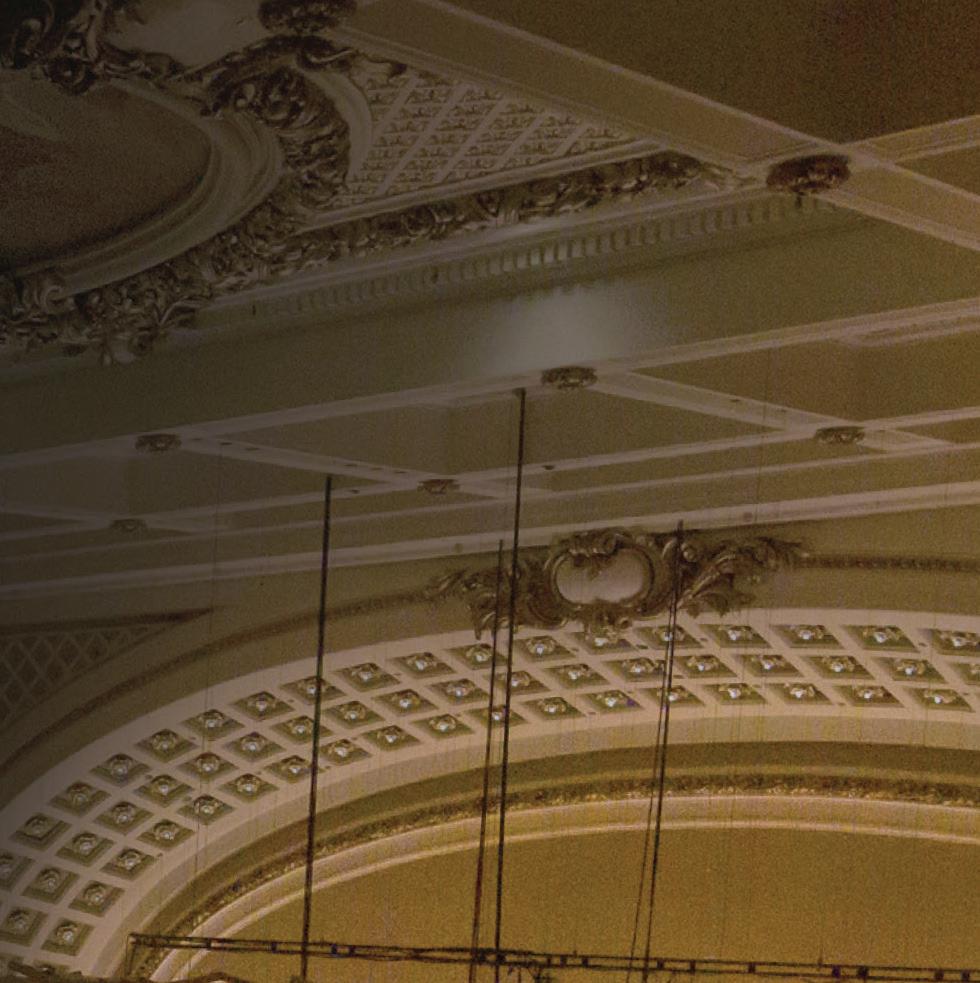
James Lee III’s Breaths ofUniversal Longing









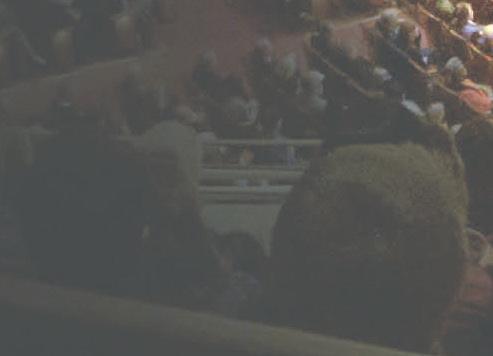







James MacMillan’s Timotheus, Bacchus and Cecilia














Julia Adolphe New Work
25 for 25: A New Time for Choral Music







Commissioning Project













+ More


























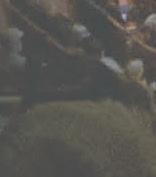


















A SEASON 150 YEARS IN THE MAKING 150th Anniversary Season
Season tickets on sale now Individual tickets on sale MAR 1 mayfestival.com • 513.381.3300


 May Festival announcing its 150th anniversary season.
Credit: JP Leong
May Festival Chorus, May Festival Youth Chorus and Cincinnati Symphony Orchestra led by May Festival Principal Conductor Juanjo Mena perform Jessie Montgomery’s I Have Something to Say, May 2022.
Credit: JP Leong
May Festival announcing its 150th anniversary season.
Credit: JP Leong
May Festival Chorus, May Festival Youth Chorus and Cincinnati Symphony Orchestra led by May Festival Principal Conductor Juanjo Mena perform Jessie Montgomery’s I Have Something to Say, May 2022.
Credit: JP Leong




 GREETINGS FROM THE BOARD CHAIR AND EXECUTIVE DIRECTOR
Christy Horan and Steven Sunderman
GREETINGS FROM THE BOARD CHAIR AND EXECUTIVE DIRECTOR
Christy Horan and Steven Sunderman

 Credit: Mark Lyons
Credit: Mark Lyons
 by Ken Smith
by Ken Smith
 The May Festival kicked off its 150th anniversary season by performing Mahler’s Symphony No. 2, Resurrection, with the Cincinnati Symphony Orchestra led by CSO Music Director Louis Langrée in September 2022. Credit: Roger Mastroianni
The start of the May Festival sounded early this season with the traditional herald trumpets decked in their new May Festival banners. Credit: Charlie Balcom
The May Festival kicked off its 150th anniversary season by performing Mahler’s Symphony No. 2, Resurrection, with the Cincinnati Symphony Orchestra led by CSO Music Director Louis Langrée in September 2022. Credit: Roger Mastroianni
The start of the May Festival sounded early this season with the traditional herald trumpets decked in their new May Festival banners. Credit: Charlie Balcom












 Credit: Eric Johnson
Credit: Eric Johnson













































































































































































































































































